

























Help us support Care Africa by opening an Apprentice Salon in Nigeria!
For years, students in Egbe, Nigeria seeking hairdressing apprenticeships had to travel into town, often to unsafe or unhealthy environments. The new J Michael’s Salon will be located directly on the mission property, offering students a secure and supportive space to learn valuable skills that can sustain them for life.
Scan QR Code to Donate
e VOICE-TRIBUNE invites you to join us in celebrating the release of our October Arts & Philanthropy issue with an evening of fun at e Splatery on Wednesday, October 16th, from 5:30–8:30 PM
e Splatery is one of Louisville’s most unique art experiences, where guests are encouraged to let loose and create one-of-a-kind splatter masterpieces. No experience required, just an open mind and a willingness to embrace a little color.
Light snacks and beverages will be provided as you mingle, paint, and celebrate the incredible arts and philanthropic spirit that makes our community so vibrant.
is is an intimate, limited-space event.
Important note: this experience is intentionally messy. Paint will get on your clothes, shoes, and anything else you wear; it’s all part of the fun. We encourage guests to wear attire that can handle a little artistic air.
Join us for an unforgettable evening where art, philanthropy, and community come together, and take home not just memories, but your own personal work of art.
Please scan the QR code below to RSVP and reserve your spot.
Dear Louisville Voices & Readers,
Our city’s festivals, galas, and performances glow against a backdrop of people stepping forward, embracing their “spark,” and lifting our cultural community. This VOICE-TRIBUNE celebrates art and philanthropy as intertwined forces: each shaped by perspective and interpretation, each capable of evoking powerful responses, sometimes even sparking a call to action. Just as iconic works from Claude Monet and Jean-Michel Basquiat stir emotion, provoke thought, and inspire dialogue, philanthropy too is an act of creativity. Giving, whether through talent, time, or treasure, is a creative act that keeps Louisville’s cultural fabric strong.
This month’s stories shine a light on leadership in action. Creative Art Director Anthony Krutzkamp has come home to lead the Louisville Ballet. Amelia Acosta Powell, the new Artistic Director, and Emily Tarquin, the new Managing Director, are steering Actors Theatre into a new chapter as the Executive Leadership Team. Dr. Ann Kenworthy has become Spaulding University’s 11th President. And Teddy Abrams has renewed his contract with Louisville for another three years!
We see the same call to action in our nonprofit partners. Independence Bank’s “Day of Good” demonstrates how small acts ripple outward, while our Giving Back Guide connects readers to organizations like Louisville Ballet, Yew Dell Botanical Gardens, and Family Scholar House. Our feature on Mary and Al Shands and the Great Meadows Foundation reminds us of a lifetime of giving that transformed Kentucky’s arts landscape. And Morgan Freeman and Eric Meier’s Symphonic Blues Experience illustrate how art rooted in history can expand into new forms that inspire philanthropy and connection alike.
Throughout this issue, artists show us how their work becomes a gift to others: the bold world of Good Girl Corsets, the sustainable glamour of The Web Has No Weaver, the unapologetic inclusivity of Velvet Outlaw, and the tactile storytelling of Tabitha Arnold’s tapestries. Each of these creators is challenging not only what fashion or visual art can be, but also how it can build community and confidence. Even our lifestyle pages echo the theme of giving and connection. “Food is Fuel” offers practical ways to care for ourselves and each other. And stories like “Youth Ambassadors Leading Louisville” prove the next generation is already building bridges across schools, neighborhoods, and cultures.
On a personal note, this month’s cover shoot was one of our most unforgettable. With paint still covering my hands, arms, legs, and some in my hair from the set, I changed into a gown, met up with my best friend Amanda, and rushed to the Art of Bourbon at the Speed Art Museum. It was there I shared a rare 1960s bourbon with our table of four, including rock stars Matty McCloskey and Will Ripley from Rev Theory. It was a living example of how art, community, and philanthropy often happen in the same breath, even if it’s an unexpected adventure! Special thanks to Antonio Pantoja, Matt Goodlett, Katie Kinman, Cleo Heine, and Anthony Lopez for bringing that cover moment to life. They didn’t hesitate when I mentioned splattering paint, body paint, and wearing clothes you can absolutely ruin.
October 2025 reminds us that art is not only something we watch, wear, or collect, it’s something we do together. It is community, philanthropy, and creativity braided into one. This issue celebrates those who give their time, talent, and treasure to keep that braid strong, ensuring Louisville continues to be a place where we all thrive.
Thank you for being part of this journey with us. Together, we’re not just documenting Louisville’s cultural life; we’re nurturing it.
SO MANY EVENTS ARE GOING ON THIS MONTH! So you’re gonna have to check the website!
Check out: www.louisvilleCalendar.com
Cheers to the many VOICES of Louisville,

Amelia
Frazier
Theobald Publisher & CEO, The VOICE-TRIBUNE



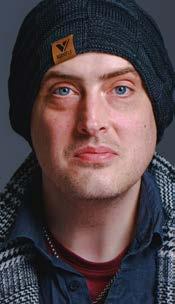



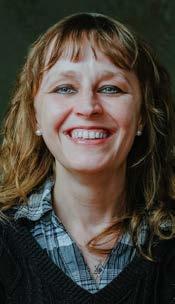





October always reminds me why I fell in love with this city’s arts and nonprofit communities. I see the gallery openings, the performances, the community programs, and I am inspired. But I also think about what often goes unseen. The long hours, the planning, the resources stretched to their limits to make these experiences possible. To truly support this work is to recognize the dedication behind it and help ensure it can continue.
It is my opinion that art and philanthropy are inseparable. When I attend a show, a gallery, or volunteer with a nonprofit, I’m reminded that these acts are not only about giving back; they’re playing a part in sustaining the connection that gives our city life. They are small ways of saying, “I see you. I value this. I am with you.”
I’ve watched Louisville thrive in many ways because of those who labor quietly to amplify voices that might otherwise go unheard. Their success depends on all of us; they need our attention, our time, our support. Recognizing the work behind the work is a responsibility we take personally at the VOICE, and one we hope others will embrace as well.
This October, we invite you to join us in lifting up our artists and nonprofits. Celebrate their achievements, support their efforts, and help ensure that their work continues to challenge and inspire. For me, that’s what it means to be part of a community, not just to be a witness to change, but to help make it possible.
Take care,
Alisha Proffitt Chief Director of Editorial & Editor












PRESIDENT/CEO, AMELIA FRAZIER THEOBALD
OPERATIONS MANAGER, MARY ZOELLER
CHIEF DIRECTOR OF EDITORIAL & EDITOR, ALISHA PROFFITT
CHIEF REVENUE OFFICER & DIRECTOR OF SALES, JULIE KOENIG
CHIEF GRAPHIC DESIGNER, JOSH ISON
COPY EDITOR, RENAE ISON
SOCIAL MEDIA MANAGER & EXECUTIVE ASSISTANT, BRYLEA PEACH
CHIEF EVENT PHOTOGRAPHER & DIRECTOR, EDITORIAL PHOTOGRAPHER & VIDEOGRAPHER, GRAPHIC DESIGNER, KATHRYN HARRINGTON
FASHION & EDITORIAL PHOTOGRAPHER, MATT JOHNSON
FASHION & EDITORIAL PHOTOGRAPHER & VIDEOGRAPHER, ANTONIO PANTOJA
ACCOUNT EXECUTIVE & FASHION COORDINATOR , CLEO HEINE
ACCOUNT EXECUTIVE, SAMANTHA HAUB
DISTRIBUTION, KELLI & RAGAN VAN HECKE, JILL & JOHN MINNIX
CONTRIBUTING WRITERS: ALISON CARDOZA, ALISHA PROFFITT, ANTONIO PANTOJA, BOBBIE HOLSCLAW, CASSIE TATUM, CHRIS MORRIS, JACKIE ZYKAN, KATHRYN HARRINGTON, KELSEY KNOTT, KEVIN MURPHY WILSON, MARY ZOELLER, RUSS BROWN
CONTRIBUTING PHOTOGRAPHERS: DAN DRY, GIOIA PATTON, JACKIE ZYKAN, KEVIN SIVAKUMAR, LINDSEY FRANKLIN, LISA STAFF, LOUISVILLE BALLET, SYMPHONIC BLUES EXPERIENCE, TABITHA ARNOLD, TERESA STARR, UOFL ATHLETICS, VERENA GERLACH, Y’ALL



Ham or Go Home: The Wild World of Good Girl Corsets
Kelsey Knott
Listen first, then Create: Emily Tarquin and Amelia Acosta Powell Step into Leadership at Actors
of Louisville
Cassie Tatum
By Matt Johnson
Alisha Proffitt
Alisha Proffitt
Art of Extravagant
with The Web
Beautiful Nightmare: The Seer and the Sword. A movie, a memoir.
Artist Feature: Henry Stansall of The Ruen Brothers
Youth Ambassadors
Leading Louisville: The Next Generation of City Builders
By VOICE-TRIBUNE
Photos By Kathryn Harrington and Provided By Y’ALL
78
Why Whiskey Row? By Chris Morris
Photos By Matt Johnson

Ellie Abbick & Nick Pemberton Wedding
Diane Werle & Brian Patton Wedding
Kathryn Harringtons Society 70
Unbroken Chain: Art + Philanthropy Still Overlap at Great Meadows
By Kevin Murphy Wilson
Photos By Verena Gerlach
Jackie Zykan: Maître Liquoriste + Perfumer + Herbalist
Circles of Support: How Teresa Starr Turns Struggle into Solidarity
By Alisha Proffitt
Clueless: A Seasonal Short Story By Mary Zoeller 88
VOICE-TRIBUNE’s 2nd Annual Halloween Costume Contest
Designing with Intention: Crystal Smith for Bittners By VOICE-TRIBUNE
Photos By Dan Dry
Food is Fuel By Alison Cardoza 108
Photos By UofL Athletics 96
Now hear this! With family deaf history, ex-U of L star Stefan LeFors was made to order or his new coaching job
By RUSS BROWN Photos Provided
Paula McCraney on the Passing of Jefferson County Clerk Bobbie Holsclaw
LOUISVILLE CALENDAR
128
Cards’ potential still uncertain as ACC play gets underway with Miami favored
By RUSS BROWN
SOCIETY
THANK YOU TO SPONSORS


“A

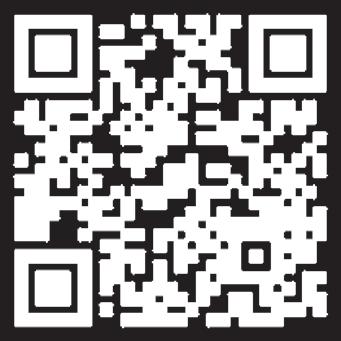




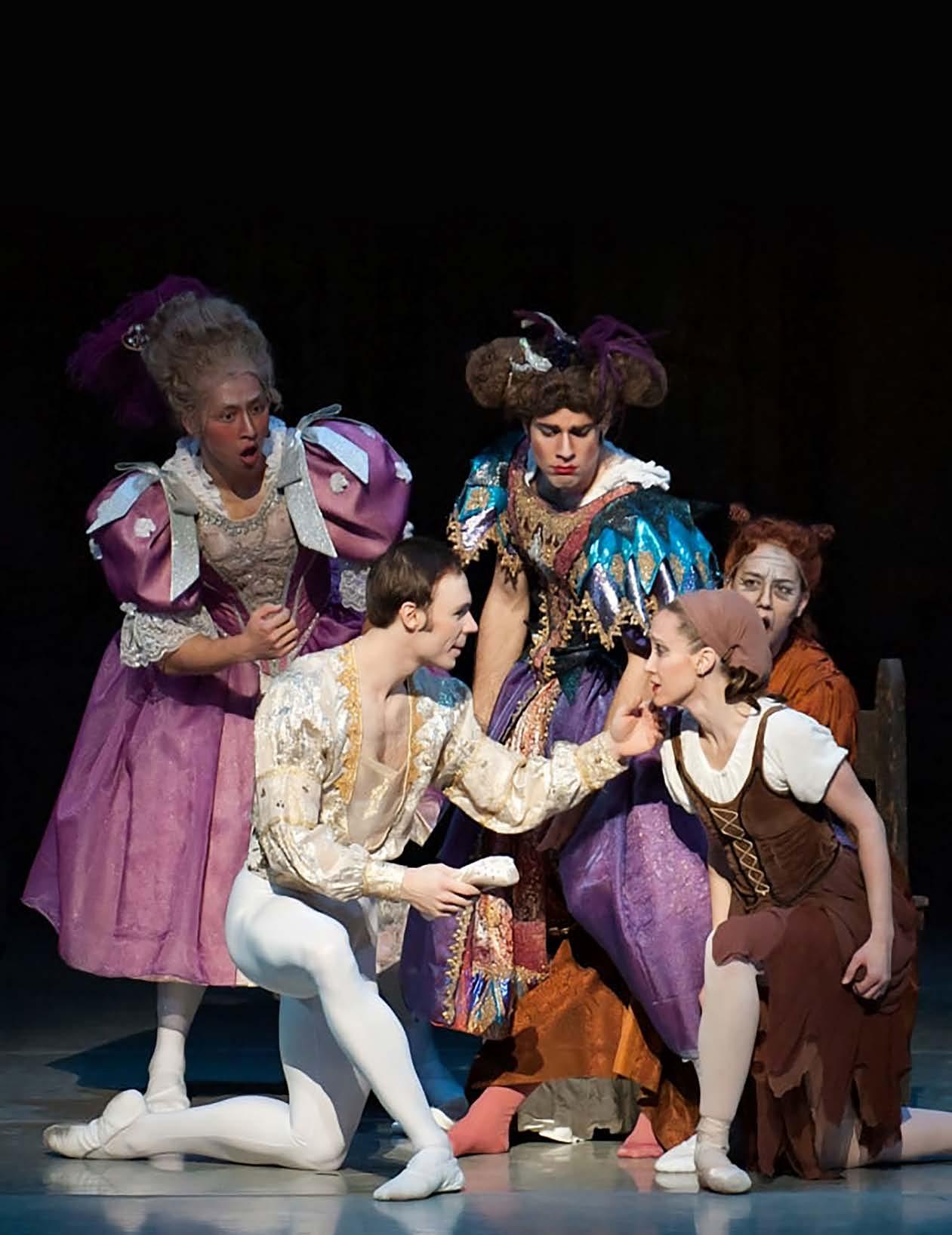
By Kelsey Knott • Photos Provided By Louisville Ballet
Meet Anthony Krutzkamp, who’s stepping into his new role as Artistic Director of Louisville Ballet. While Krutzkamp has led an incredible life traveling with dance, nothing thrills him quite as much as returning home to lead the ballet company he grew up with.
As a child raised on a family-owned dairy farm in Campbell County, his dancing dreams began with a love for clogging, though he started in tap. Upon his tap studio’s closing, the Cincinnati Ballet School called to gauge Anthony’s interest in ballet. “The call was on Friday. On Monday, I was dancing. I was a hyperactive boy, so when Cincinnati Ballet invited me to watch a company class, my mom took me out of school, and I saw these guys doing double assembles and five pirouettes and thought, ‘Okay, I can do this. I want to do this.’” His teacher, Karen Connell, expanded his world even further when she told him scholarships and summer intensives around the country were within reach. And so, at the age of 15, Krutzkamp headed to Boston Ballet School.
Opportunities continued weaving their way into his world, and he believes, “My life has been happenstance.” Working as a guest artist in Charleston, West Virginia, led him to meet Miguel Campaneria, who initiated his international travel to Japan, where he spent six weeks for seven summers and found more opportunities across Europe. Performing in lead roles as a Principal Dancer for Cincinnati Ballet and revitalizing Sacramento Ballet as Artistic and Executive Director, Krutzkamp is well-known for his innovation, blending classical tradition with contemporary voices, as well as expanding outreach with events like Kansas City Dance Festival and Moving Arts Cincinnati, both of which he co-founded.
The flow of music and the comfort found in the side-stage lighting keep Krutzkamp inspired: “When you’re dancing, there’s a moment when you’re rehearsing that you no longer think about the steps. The music carries you. You’re no longer worrying about count five; you just know it, because that’s part of the diphthong of the music. You lose all thinking and become an artist. There’s a moment on stage where you’re ready to enter, and you’re no longer nervous. It feels like home, in the theater sidelighting.”
Krutzkamp looks forward to building trust with the Louisville Ballet dancers and watching them grow and thrive. “To think that I could be the artistic director of the company I used to watch perform when I was younger is just unbelievable. I grew up heading north to Cincinnati Ballet and south to Louisville Ballet. It’s the best part of the job, watching dancers get better. When a dancer knows you’re behind them, and then you see them accomplish things on stage, cheering them on through the nerves… I want to go through that.” He believes Louisville is ready for a safe space where performers can reach their full potential. “It’s just dance. You can make it fun and low-stress. You can find amazing choreographers and treat the dancers well, pulling the best out of them. They’re happy, the show happens, everyone’s happy, do it all again.” With the core belief that dance is for everyone, Krutzkamp hopes Louisville audiences find appreciation and enjoyment in experiencing a performance, whether from the impressive athleticism or the sheer joyousness of the dancers.

Teaming up with CEO Leslie Smart is another reason Krutzkamp is thrilled to take on this role. “If you look at what Leslie’s done in a short amount of time, you can see that it’s true and that it’s real. She’s grown the company and created financial stability, while enhancing the profile of Louisville Ballet through innovative partnerships, bold artistic initiatives, and expanded community engagement.”
“I look forward to bringing new ideas to the stage, deepening our connections with audiences, and continuing to amplify Louisville Ballet’s presence locally and beyond, ” he said. “I know I can do my part in meeting people and selling tickets because people need to see what these artists can do.” Krutzkamp looks forward to continuing to break down the accessibility barrier by crafting works that challenge the dancers and entice the audience.
A husband and father to two lovely girls, Krutzkamp knows he has lucked out in all parts of his life: “I’m just excited to start. It’s a dream job; I just had to pinch myself.”
Don’t miss Dracula at the Brown Theatre on October 10th and 11th, and round out your magical holiday season with tickets to The Brown-Forman Nutcracker at the Kentucky Performing Arts Center. Purchase tickets at louisvilleballet.org
• Led Sacramento Ballet to record-breaking ticket sales
• Founded Sacramento’s Second Company and awarded $125K in student scholarships
• Programmed works by Balanchine, Penny Saunders, Alejandro Cerrudo, Ma Cong, Caili Quan, Ihsan Rustem, and Jermaine Spivey.
• Co-founded Kansas City Dance Festival and Moving Arts Cincinnati
• Took Sacramento Ballet to the Bremerhaven International Summer Gala in Germany
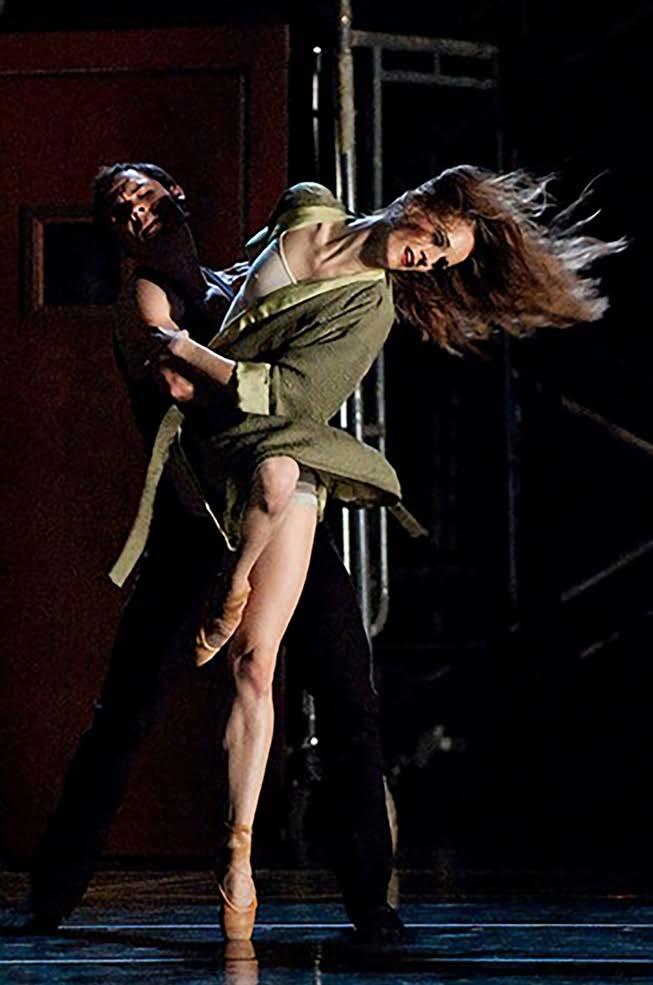









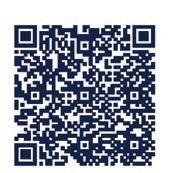

By Cassie Tatum • Photos By Matt Johnson
On a Wednesday morning, the renowned Actors Theatre of Louisville leaves behind the weekend’s vibrant chatter surrounding the most recent performance and slows, morphing into a quiet and cloud-lit space. So quiet in fact, you can almost hear the building whisper. It’s a place meant for listening, or more specifically, active listening, which we could all use more practice doing.
Emily Tarquin, newly appointed Managing Director of Actors Theatre, implements the art of listening not only while watching and curating live performances, but while leading the community hub and state theatre of Kentucky through the process of rebuilding post-Covid. Tarquin, alongside newly appointed Artistic Director Amelia Acosta Powell, emphasize “listening first” to the needs of the Louisville community as they collaborate to shepherd the theatre’s sustainability for years to come.
The Actors Theatre of Louisville has squared up to challenges since the pandemic, and with Tarquin and Acosta Powell at the helm, the space will continue its pursuit in life-long learning and community engagement. Since January of this year, both have been serving in their respective positions as interim leaders, proving to the board of Actors Theatre their combined abilities create space for future development of the theatre itself, and for the Louisville community that fills it with curiosity, creativity, and a love for experiential art.
In their roles as Managing and Artistic Directors, Tarquin and Acosta Powell will serve as guideposts for the theatre’s mission: a storytelling revolution meant to unlock human potential, build community, and enrich quality of life by engaging people in theatre that reflects the wonder and complexity of our time. “We are both people who focus on the work, the mission,” says Acosta Powell, in regard to leaping head-on into executive leadership roles. “This is a step we are ready to take because Actors Theatre means a lot to us, to this community— and the community means everything” in terms of the theatre’s success. The pair are creating an “alchemy” of innovation and growth, all while keeping the needs of the community in the forefront.
Tarquin and Acosta Powell are both “uniquely positioned to serve as a bridge” in this rare and strange moment, when entertainment rests in our fingertips, constantly swirling and distracting from the opportunity for connection provided by the events created and hosted by artistic spaces like Actors Theatre.
It’s vital to retain the theatre’s loyal audience while also supporting and attracting local emerging voices, and younger, more diverse demographics. Actors Theatre has engaged the DeVos Institute and Christen Boone to lead a strategic planning process to support this effort. Tarquin and Acosta Powell plan to widen the range of stories shared by Actors Theatre, along with a variety of programs offered to the public. “We know our times are complex,” Tarquin posits, “and I think in some ways it’s harder, now more than ever, to lean into the wonder” that is emphasized in the theatre’s mission. By implementing programs specifically geared toward all ages and audiences, Actors Theatre will “provide that respite, that relief, and be a source of joy,” to the masses.
Reenergizing the theatre and fostering that necessary joy doesn’t only mean introducing newness to Actors Theatre. Instead, Tarquin and Acosta Powell plan to reincorporate beloved classic “stories that feel familiar,” like A Christmas Carol. Inherent in live performance is the element of surprise, so even if you know the story by heart, “you don’t know exactly what will happen in that room on that night,” says Tarquin. Each performance differs from the next as the audience informs the actors and vice versa, creating an immersive and centered audience experience.
Tarquin and Acosta Powell plan to enmesh the quintessential performances with “new stories that people can be surprised by, learn from, and expand who feels seen and represented at Actors Theatre of Louisville.” The world premiere of FDR’s Very Happy Hour kicks off on October 15th, a performance that experiments with how stories can be shared and viewed. The show, centered around President Franklin Delano Roosevelt, was “written by a wheelchair user,” Acosta Powell explains, “and performed by an actor who uses a wheelchair and an actor who is deaf.” Every performance will offer ASL interpretation, captioning, audio description, and, of course, wheelchair seating. “Not just at the back of the house where the traditional wheelchair seats are,” Acosta Powell notes, “but on the stage, at the center of the action.” To Tarquin and Acosta Powell, accessibility allows for a broadening of audience, offering experiential art and programming to everyone.
The passion behind Tarquin and Acosta Powell’s leadership as Managing and Artistic Directors is visceral, and grounded in their individual goals is a shared sense of belonging. They are asking us, the Louisville community, to witness the beauty of artistic creation, to participate in the equitable spread of knowledge through story, to actively listen, and, most importantly, to lean into the wonder of theatre.

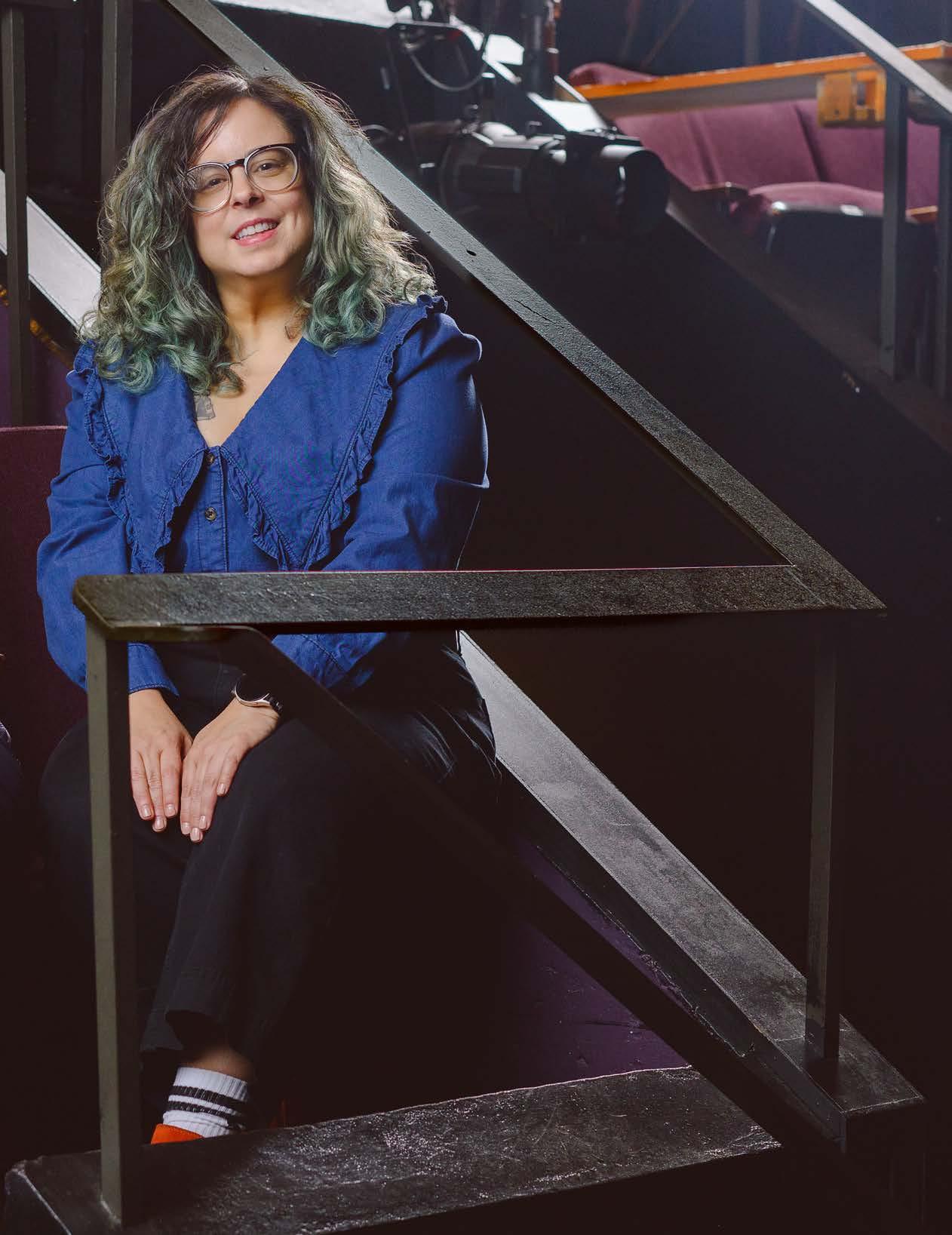

By RUSS BROWN • Photos By Matt Johnson
After 37 years, 80-year-old Chuck Rubin was ready to turn his Louisville used camera business over to a younger entrepreneur. Alex O’Nan, 47, a longtime camera lover and a frequent visitor to Rubin’s shop, was eager to begin a new career.
It was a perfect match. Thus, as of Aug. 1 “Chuck Rubin’s Photographics” became “Abandoned Cameras”, located at 3418 Frankfort Ave. Rubin recently explained how the sale came about. “Business had slowed down, but it was still fun and still good, so I stayed there,” he said. “One day this tall, skinny guy (O’Nan) came in and said, ‘Do you want to sell this place?’ And I said, ‘Hmmm, I’m 80, maybe I should’, so I did. And Alex has been running it ever since and doing a great job, by the way. He has become very popular in the camera business very quickly.”
But Rubin is quick to correct anyone who suggests he is retiring. “I’m not retired, I’m unemployed,” he said. “That’s different. I haven’t figured out (his next step) yet.”
For now, O’Nan said Rubin is still very much a presence in the building, keeping an office nearby his former business, and that the two work together attending camera shows and seeking out used and vintage equipment.
“I want his advice,” O’Nan said. “I want him involved. He’s the kind of guy that, yes he’s old, but he doesn’t want to sit around at home doing nothing. His brain is still sharp, he loves doing it and he’ll do it for as long as he can.”
Rubin, who was born in Brooklyn, N.Y. and had lived in Florida, has called Louisville home for 55 years. “Look it up, I’m a Louisvillian,” he said.
He became interested in cameras and photography “around 1970,” he said. “I was doing ‘Shakespeare in the Park’ and went to the DAV to look for props. I found this black box; and we started messing with it. We found a secret button, pushed it and it opened, and there was cherry wood, red leather and brass. It was really beautiful. It was an old camera from the 30s and that’s what got me started collecting cameras, and that led to collecting more cameras and then shooting pictures with them.”
What was Rubin’s occupation before he went into the second-hand camera business? “I was pretending to be an insurance adjuster,” he joked.
Asked what he was most proud of as a businessman, Rubin didn’t hesitate. “I feel most proud, somebody buys something or they don’t, and when they’re leaving they say, ‘Chuck, thank you for being here. I really appreciate it.’ When I was a kid and somebody gave me a compliment like that, I figured my mother paid them. It took me 80 years to realize that people were serious about it, and it felt great.”
Before O’Nan’s offer came along, Rubin said he’d had inquiries about selling, but never seriously considered them. But they say timing is everything, and O’Nan’s was ideal.
“I looked around at how much stuff I had and I thought about what I was going to do when I retired, which should have been 15 years ago,” Rubin said. “If I sell, I don’t have to clear all this stuff out, and it seemed like a good idea, so I sold.”
For O’Nan, his move into entrepreneurship came after a long list of jobs, which he described as “kind of bouncing around” trying to find the right fit.
When he bought Rubin’s business, he had recently completed an internship at Angel’s Envy distillery. A native of Shelbyville, Ky., O’Nan attended Kentucky State University for a few years, then transferred to U of L as a photography major. But that didn’t last either and then he was offered his “dream job,” running trains to Nashville and Cincinnati as the conductor for nearly 20 years.






Louisville Business First
Top 20 People to Know in Construction
REFLECTIONS OF YOU, BY AMY
AMY WAGNER, NEST REALTY



By Alisha Proffitt • Photos Provided
The blues has a way of speaking straight to the soul, and thanks to Morgan Freeman, Eric Meier and their extraordinary team, its legacy is reaching new audiences in fresh, unforgettable ways. From their work with the legendary Ground Zero Blues Club to the creation of Morgan Freeman’s Symphonic Blues Experience they’ve built something truly special, a show that blends the grit and heart of Delta blues with the sound of a full symphony orchestra.
We’re thrilled that this one-of-a-kind experience is making its way to Louisville. And thanks to our friends at the Louisville Orchestra, we were able to ask Freeman and Meier a few questions about the music, the mission, and what audiences can look forward to when the Experience comes to town.
Alisha Proffitt: When you first opened Ground Zero back in 2001, what did you imagine it might become? And looking at it now, how close is it to what you pictured back then?
Morgan Freeman: My partners, Bill Luckett, Howard Stovall, and I opened the club in 2001 to provide both local patrons and visitors to the Delta an opportunity to experience the best of blues right here in the Mississippi Delta. Fast forward to today, we are consistently recognized as the top blues club in the world with visitors from over 50 countries. The venue, music, and experience is authentic as it gets - great music and great times.
AP: The Symphonic Blues Experience is such a unique idea, mixing raw blues with a full orchestra. What inspired this collaboration, and have the reactions from audiences surprised you at all?
MF: My partner conceived of the idea back in 2022. After he met with an Australian Hip Hop band that had created a symphonic fusion album, he asked why not us. We looked around and recognized that this was a novel idea of blending blues with orchestral music. We piloted it in Savannah, Dublin, and Salzburg.
AP: You cinematically narrate the story of the blues during the show. How do you communicate to the audience something that feels true to its history but also speaks to people hearing it for the first time?
MF: We strive to honor the roots of the blues by sharing stories that echo the real lives and emotions of those who created this music. By weaving historical anecdotes with personal reflections, I hope to show both longtime fans and newcomers that the blues is not just a genre—it’s a living history of resilience and hope. Connecting those stories to what’s happening in the world today helps everyone see themselves in the music.
AP: Blues has always been tied to real-life struggles, but it also carries with it hope. This is a sentiment many still relate to throughout the world today. What do you believe it is about music that makes it such a powerful vessel of expression, connection and healing?

MF: Music has a way of meeting people where they are, whether in sorrow or joy. The blues, especially, carries a message: even in the toughest times, there’s strength to be found in singing your story to someone who listens. That exchange—artist to audience—is what brings connection and healing. Through song, we discover that our stories are echoed by others, and that understanding fosters hope.
AP: When you think about the future, what impact do you hope to make with Ground Zero and the Symphonic Blues Experience?
MF: My hope is to preserve the authentic spirit of the blues while opening new doors for people everywhere to experience its power. With Ground Zero, we’re building a place of heritage and celebration, and through the Symphonic Blues Experience, we’re showing how this music continues to evolve and inspire in cities around North America. If each patron leaves with a deeper appreciation and a new sense of connection, then we’ve truly succeeded.
AP: Of course, we have to ask, are there any destinations or plans you are looking forward to during your visit to Louisville?
MF: My time is limited but hopefully a stop or two from some great local food and some bourbon!
AP: Mr. Meier, you came on board as co-owner in 2018. What made you want to be part of Ground Zero, and what’s it been like working alongside Mr. Freeman and carrying forward the club’s legacy?
Eric Meier: I wanted to be part of an iconic music establishment providing entertainment to the Mississippi Delta for locals and visitors. It is an incredible brand and experience. I feel lucky and honored to work with Morgan Freeman, Howard Stovall, and the wonderful staff.
AP: Kentucky has a strong music culture and history of its own. How do you imagine the blues and orchestra pairing will connect with audiences here?
EM: Extremely well. We are excited.
AP: The Ground Zero Arts Foundation plans to do some great work for young musicians. Can you tell us about the charter and focus?
EM: We recognize the need to support the local musicians that make this place special. Our non-profit foundation is specifically focused on providing educational support, financial planning and health care support to local musicians.


AP: Ground Zero is often called “the crossroads of the blues.” From where you sit, how do you keep the music authentic while also letting it grow and evolve for new generations? What can we do to support new and emerging musicians and artists- what opportunities would you like to see more of?
EM: Authenticity starts by honoring the originators and tradition bearers, giving them a stage and letting their voices be heard. At the same time, it’s vital to provide opportunities for younger artists to collaborate, explore, and blend genres. Supporting new musicians means investing in programs, mentorships, and—most importantly—making space for fresh ideas while staying true to the blues’ spirit. I’d love to see even more educational opportunities, music recording opportunities, and partnerships with schools and community organizations.
AP: Now that the Symphonic Blues Experience is on the road, what do you hope audiences take away with them when they walk out of the theater?
EM: Time well spent. Presenting the Symphonic Blues Experience in Louisville not only supports the city’s cultural landscape but also continues a tradition of meaningful musical storytelling, connection, and healing—giving local audiences a chance to see their own music heritage reflected in a new, unforgettable light. We are excited.
For more information, visit: www.symphonicblues.com
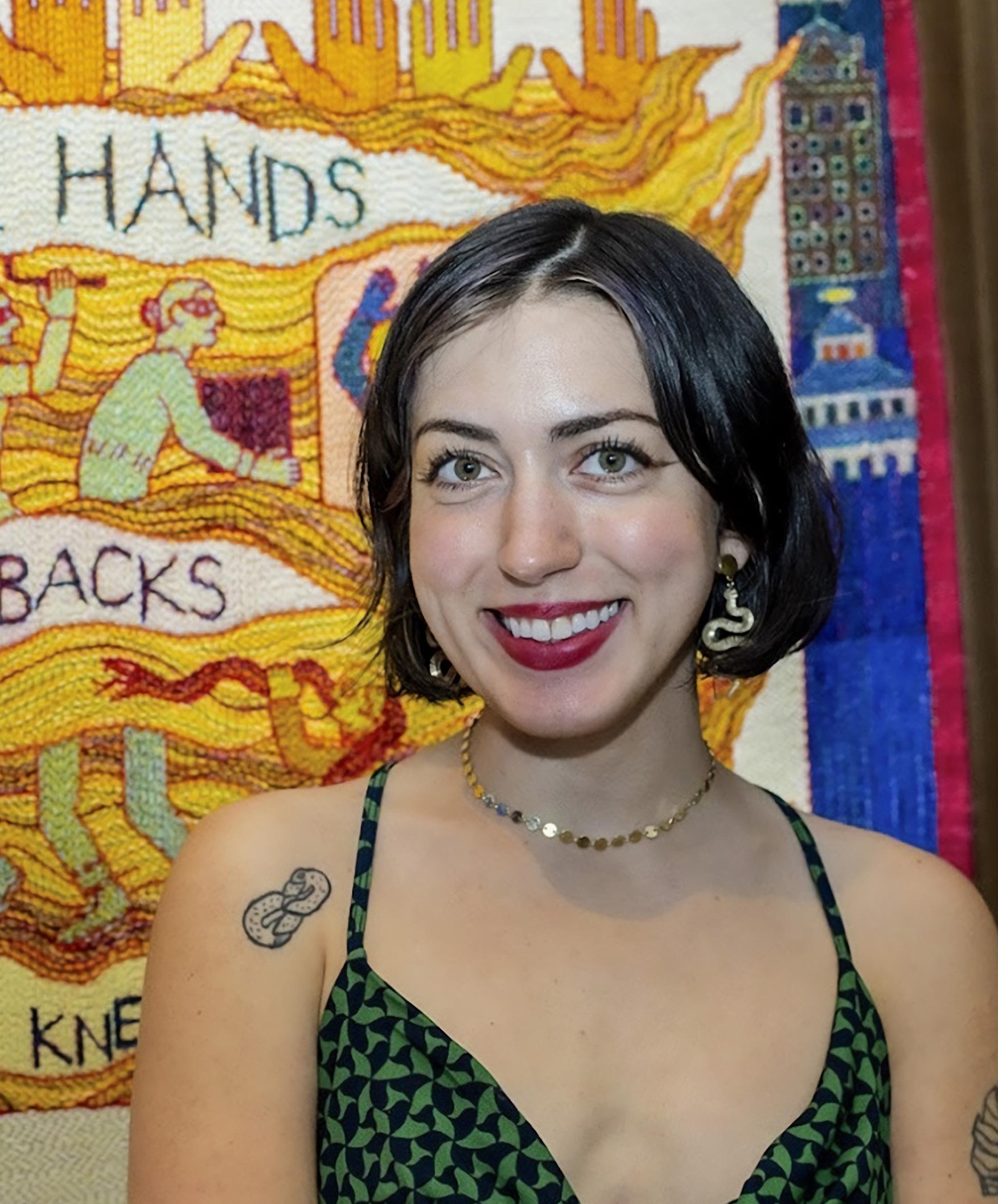
By Kevin Murphy Wilson | Photos Provided
Tabitha Arnold is a Tennessee-based activist/artist whose provocative works are held in prominent collections (both private and public) far and wide, including the Museum of Fine Arts—Boston and Dom Museum Wien. A self-described socialist and labor organizer, her pieces frequently draw upon imagery from Bible Belt spirituality, social-realist propaganda, and ancient art motifs to create new historical artifacts from a working-class perspective. We recently caught up with this 2025 recipient of the Southern Prize for Visual Art for a quick look backwards and forwards.
VOICE-TRIBUNE: Can you tell us a bit about your background/ education/experience?
Tabitha Arnold: “I was born in Chattanooga, Tennessee. My mom’s family are working-class Portuguese and Polish immigrants. My dad’s side is more educated, ‘WASP-y,’ and very religious: my grandfather was a preacher who died in the pulpit while giving a sermon. I didn’t learn much about class struggle or unions from my family growing up. I moved to Southeastern Pennsylvania in my early teens and eventually went on to study painting at the Pennsylvania Academy of Fine Art (PAFA) in center city Philadelphia.”
VT: So, what sparked your interest in Labor and Class Struggle initially?
TA: “Living in Philly [sic] for several years definitely put labor unions on my radar. Class struggle is something you can observe on a street level; as strikes are very visible, Scabby The Rat [an American labor icon often used in protests] appears everywhere, and the building trade unions are still relatively powerful in city politics. But it wasn’t until I graduated college and worked at a coffee shop that I began to get radicalized to the idea that I, myself, could have a union at my job. I was part of the very beginning of a citywide cafe workers’ movement that would become a national phenomenon, mostly led by Starbucks Workers United.”
VT: Your recent solo exhibition was titled “Gospel of the Working Class.” As a socialist, were you also influenced by Liberation Theology and/or the Catholic Worker Movement?
TA: “The show title references a book of the same name by Erik S. Gellman and Jarod Roll. It follows two Southern preachers, Claude Williams and Owen Whitfield, who were essentially radicalized by their congregations into becoming leaders in the labor movement of the 1930s. They bumped elbows with liberation theologists at Vanderbilt and the founders of Highlander Folk School, a communist-led organizer training center just 45 minutes outside of Chattanooga. So, yes, I notice how liberation theology trickles into political action here in the South. As for the Catholic Worker Movement, that’s something I admittedly need to learn more about, but I know it has directly inspired my DSA chapter’s mutual aid program to cook free meals at scale for the community.”

VT: Are there any specific artists that inspired you or that you wanted to emulate, or alternatively were there any that you knew you didn’t want to be like?
TA: “For a long time I’ve looked to Palestinian artists, specifically the liberation posters of the 1970s and 1980s, to find inspiration. I’m inspired by collective movements, like the Chilean arpillera artists, and public art programs, like the WPA post office murals. Ironically, my own art practice is very solitary, as I do all of the work myself. I want to avoid contracting out the craft or labor of my work to other, uncredited artists; which I know is the norm for a lot of late-career artists to set up their own “art factory” as they get wealthier. I’m looking for ways to expand my practice to be more collective in the future.”
VT: How has your relationship to materials and processes evolved over the years?
TA: “I spent my teens trying to be a painter, but the process never brought me joy. I just thought it was the default path for serious people who wanted a career as a studio artist. Then, around age 21, I discovered tapestry weaving, which did bring me joy! I love how meditative it is, and how you build an image one line at a time, from the ground up. But when I wanted to move to more complicated imagery, I felt frustrated with the limitations of weaving; and that’s when I got into the punch needle and realized I could use it as an embroidery tool. So now I have my own unique mix of processes, where I am using painting canvas stretchers to brace a linen backing for punch needle, which I use in geometric patterns from the ground up to emulate tapestry weaving, and I show the ‘back’ of the work instead of the tufted side, so it resembles embroidery.”
VT: What are you up to at the moment in terms of an emerging body of work and/or any upcoming exhibitions?
TA: “I’m still working on ‘Gospel of the Working Class.’ I believe it needs one more historical tapestry about Chattanooga to be complete, and that piece will likely go on view in Lexington, Kentucky next year. I’m at a residency in Omaha right now, experimenting with mosaic tile, which I want to use for more permanent and weatherproof artwork. I’m also refining a screenplay I wrote about a union drive, that I hope I can get some eyes on in the next few months.”
VT: You were recently awarded the 2025 Southern Prize for Visual Arts during a ceremony at KMAC, which is a nice marker of achievement. But generally speaking, in this day and age, and at this point in your career, how do you measure success as an artist?
TA: “I measure success in how many working people and union organizers tell me that my work has directly helped or inspired them! At this point, this happens almost daily, so much that I can’t always keep up with responding to everyone personally. But it means so much to me every single time, and it lets me know I’m on the right path.”
Tabitha Arnold’s work is on view here in Louisville through November 2, 2025 as part of The South Arts 2025 Exhibition of the Southern Prize and State Fellows for Visual Arts at KMAC. For more information about the artist, visit tabithaarnold.com
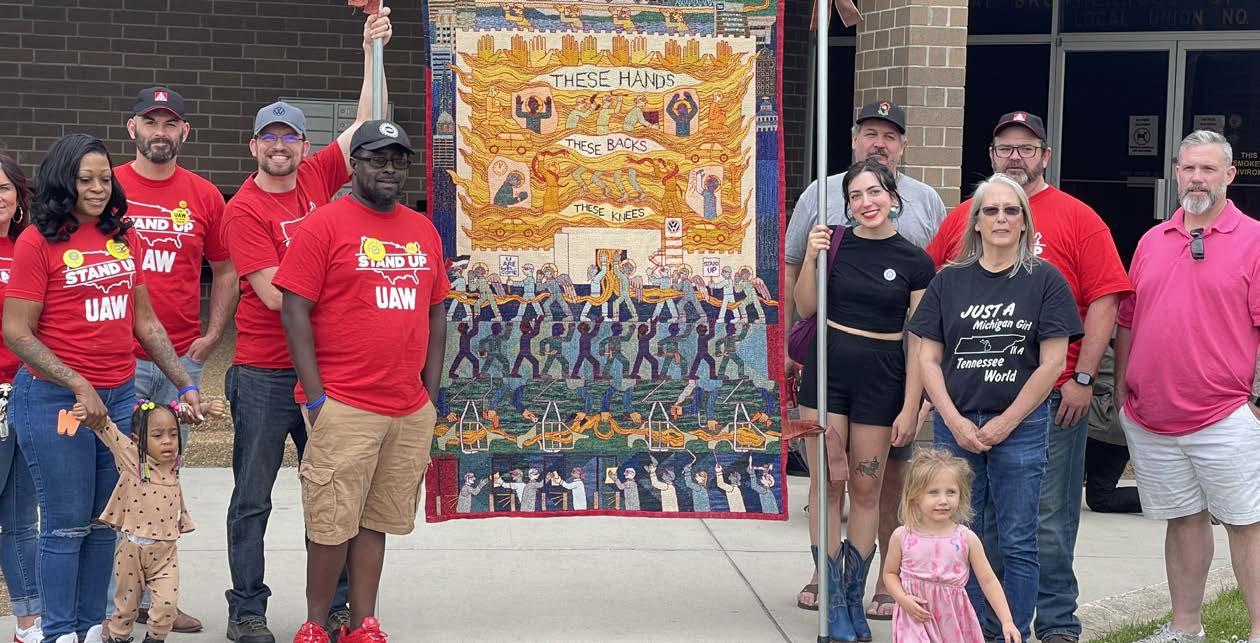





By the time Miranda Deaton was thirty-three, she had lived more than a few lives. The founder, designer, and seamstress of Velvet Outlaw begins her own introduction with a bit of fun. “I am a Virgo sun, Taurus moon, Libra rising, an enneagram 8, pet parent to 4 fur babies, lover of strawberry rhubarb pie, and usually obsessively listening to one song on repeat until I’m over it (currently, Islands in the Stream by Dolly Parton and Kenny Rogers).”
Velvet Outlaw, the Louisville-based brand known for rhinestone suits, fringe, and sharp tailoring, did not emerge from a conventional path. Before sequins and custom blazers, Deaton worked on capital defense teams. The switch might seem improbable, but as she recalls, it was “the culmination of a hundred small things and one big final push.”
For years she managed full-time work on capital murder cases, a side job, and Velvet Outlaw all at once. “When you have a dream, you do probably too much to make it happen - I was running out of steam but determined to see what this idea of Velvet Outlaw was becoming,” she says. She still calls her legal work “my dream career.” But a family crisis changed her outlook.
“My dad was diagnosed with cancer and everything changed. … This major change in the dynamic of mine and my parents’ life made me realize that I didn’t want to wait to retire to live my dreams of being an artist, because what if life isn’t long or what if, or what if, or what if…”
Along came clarity. “His diagnosis made me realize the life that I still wanted to live. I wanted a work-life balance, I wanted to spend time with him, with my family, I wanted to be available and I wanted Velvet Outlaw.”
That urgency changed not just their business but their entire disposition. “For only being 33 years old, I have truly lived a lot of life, highs, lows, and a lot of really beautiful middle moments,” Deaton says. “Velvet Outlaw is my creative outlet that also happens to be a successful business. I have always turned to art as a form of self-expression, healing, and outlet. Velvet Outlaw is the formal version of that creative expression that I have opened up publicly for others to also participate in. Clothing is personal. Art is personal. Velvet Outlaw is both.”
She often describes clothing as “armor, expression, and healing.” The goal is simple but radical. “My goal for a Velvet Outlaw customer is that they will walk away feeling like a participant in a piece of their very own artwork. Their suit or outfit will feel like them. They can see themselves in their garment and when they wear it, they feel seen and confident.”
A cornerstone of Velvet Outlaw’s design philosophy is inclusivity. “I intentionally focus on designing and making clothing for mid to plus-size bodies,” she says. Too often, she adds, people dismiss fashion with comments like “that’s not for me” or “that would look better on my daughter.” Each time, it “breaks my heart because I know that behind those words are hundreds of pants that didn’t fit right, negative self-talks in the mirror, wearing something oversized because you wanted to hide a part of yourself. I’ve been there. Velvet Outlaw is a place where we work through those struggles together and help you find the piece of your dreams and if we can’t find it, we make it.”
The work also carries a family thread, quite literally. “My grandpa passed over the summer and I was able to take a large amount of his thread, which is now in my studio, and used in each garment I make. It’s a small but loving gesture to honor his immense dedication to consistent hard work.”
Historically, her rhinestone suits draw inspiration from vaquero culture and the elaborate “Nudie” traditions of mid-century country music. But she approaches that history carefully. “I spend a lot of time learning and researching in order to understand the historical and current cultural significance of the rhinestone suits and vaquero culture. … At the end of the day, I do want the suits to be recognized as a ‘rhinestone or nudie suit,’ but it’s clear that it is a Velvet Outlaw original design.”



She is also firm about what Velvet Outlaw is not: “Overall, fast fashion could never. Period. One handmade garment of my simplest coat design takes me at least 20 hours - from ideation to a finished garment - and that is on the low end. … When you work with a designer, you are working with an artist. We get to build a personal connection and build a wearable work of art together. You could never get that from fast fashion.”
That care has drawn attention. Velvet Outlaw has appeared at Austin Fashion Week, Derby Diversity Week, and in the pages of Queer KY. For Deaton, such moments have been instructive: “Doing various fashion shows, interviews, and markets all over the Midwest and South has helped me see Velvet Outlaw from the consumer’s perspective. Often, I am too close to the rhinestones to really see the whole picture and over the last few years I’ve gained a clearer perspective of what Velvet Outlaw is becoming!”
Every designer needs a soundtrack. On her website, Velvet Outlaw offers playlists like Legendary Women of Country. But asked to name a single anthem, Deaton hesitates. “It would have to be a combo of multiple songs or a new song just for Velvet Outlaw, sung by Dolly Parton, Willie Nelson, and Beyoncé. Which we got close to with Beyonce’s latest album!”
At home, the design studio sometimes doubles as a pet runway. “Z (Zetta), my sweet baby angel, is the inspiration for Velvet OutPaws and she is the face of our socials and the main model for all of the products. All of the cats have been models, too. Taco (our orange cat) loves his bandanas. I’m determined to show people that pets deserve fringe too!”
For Deaton, Velvet Outlaw is rhinestones and fringe, yes, but also personal expression, legacy, and joy. As she puts it, “Clothing is personal. Art is personal. Velvet Outlaw is both.”
For more information visit: velvetoutlaw.com


By Alisha Proffitt • Photos By Matt Johnson
Corsets. Some think Victorian torture devices. Others think Halloween pirates. In Louisville, they’re also for croissants spilling chocolate, pigeons strutting their stuff, and one very famous “Awesome Opossum” that’s toured Europe. This is the world of Good Girl Corsets, a mother-daughter duo who believe that confidence can, in fact, be stitched in.
The story begins in 2010 with the Va Va Vixens, a variety performance troupe. When Carrie Foster joined the lineup, she turned to her mom, Deb Foster, for help with costumes. Deb was already a skilled sewist, but she soon upped the ante with corsetry. And as her daughter recalls, “No surprise, she was a natural. Before you could count to ten, she was whipping out a corset in a week or two… which is unheard of.”
Word spread fast. Other performers wanted in, festivals came calling, and suddenly Good Girl Corsets was born. While Deb perfected the structural art of corsetry, Carrie uncovered her own hidden talent, draping fabric into sculpture and building extravagant headdresses. “Looking back, I had no idea what I had unleashed. It is so satisfying to uncover a hidden talent within yourself you had no idea was even there,” Carrie says.
These days, the duo divides and conquers. Deb, now focusing on hand-stitching and embellishments, while her daughter leads design and vision. Together, they create costumes that are as clever as they are couture.
Inspiration can come from anywhere: a song, a client’s personality, or the sheer fabulousness of a flamingo. (Yes, there was a flamingo costume, and yes, it was fabulous.) Clients often arrive with ideas, but the real magic happens when they hand over creative freedom. “We work best with people who present a project with minimal direction and then allow us to really go ham,” Carrie laughs. And honestly, wouldn’t you want your costumer to go full ham?

Corsets, of course, come with questions. Chief among them: are they comfortable? The answer: not exactly. But there are levels. “Corsets are not known for their comfort factor… but hourglass corsets tend to create less muffin topping,” Carrie explains with the pragmatism of someone who’s both worn and built more than a few.
What sets Good Girl Corsets apart, though, isn’t just craftsmanship or creativity. It’s the way their designs change how people feel. Performers step on stage not just extravagantly dressed, but transformed. Non-performers who commission a piece get a taste of that same thrill. As they put it: “Everyone should get to experience the celebrity.”
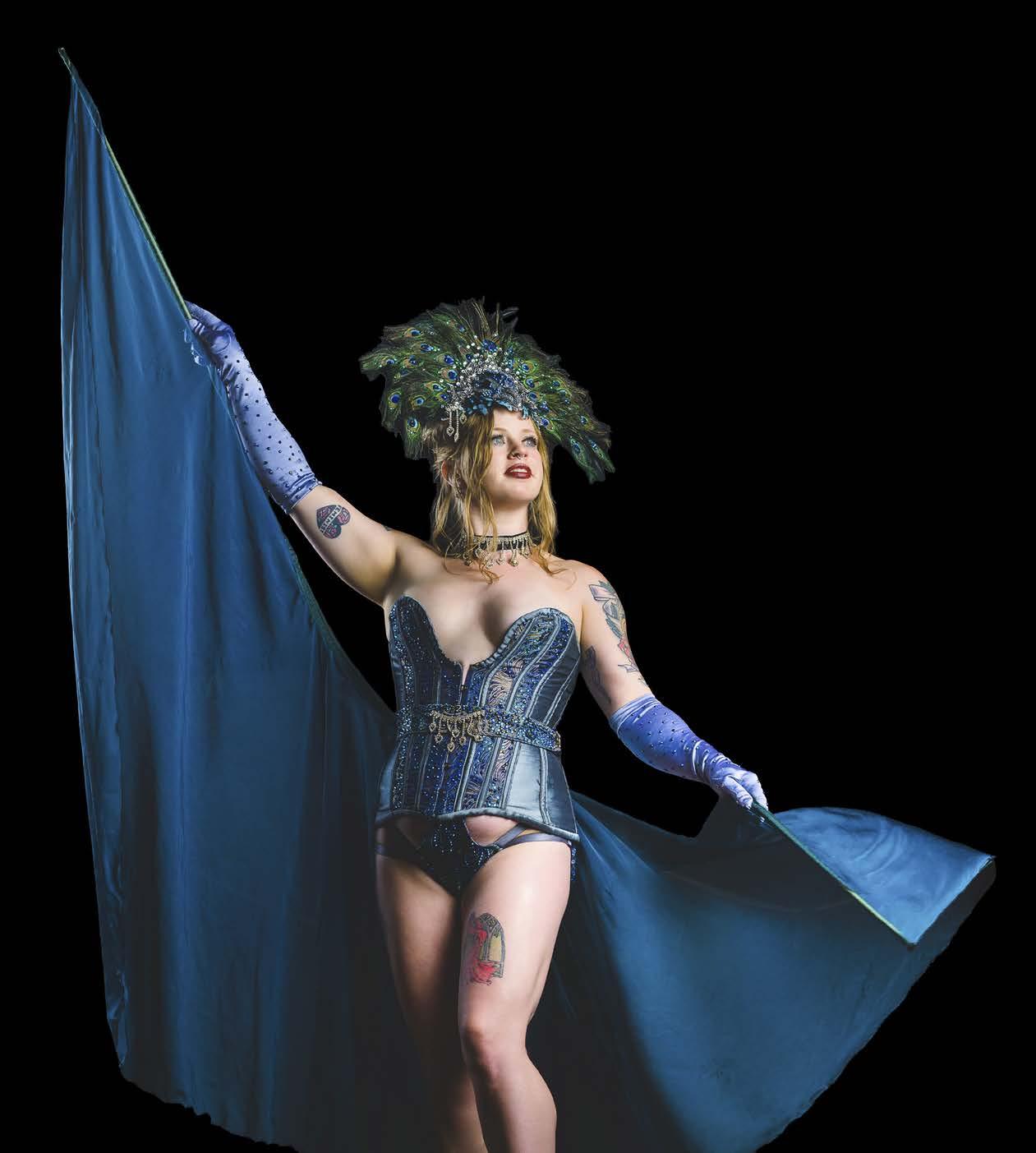
Good Girl Corsets call their vibe “Timeless, Bold & Unforgettable.” Judging by the pigeons, pastries, and possums in their portfolio, that feels exactly right. Wearing a Good Girl creation is like entering a small, fabulous alternate universe.
Aside from all the sequins and feathers, Good Girl Corsets is also a story about opportunity and community. “I owe ALL OF THIS to Art Sanctuary, which produces the Va Va Vixens. That is why it is so important to support local arts organizations like Art Sanctuary. Talent that blossoms when it has a place to grow is essential for the entire community!” Without spaces like this, where performers and creators can experiment, learn, and take risks, many hidden talents might never see the light of day. The costumes, the shows, the joy; they all start with a community willing to invest in art and imagination.
Art Sanctuary is now working on its revitalization project, Art Sanctuary Reimagined, and looking for a new home to house studios and performance spaces for our local artists, making support more urgent than ever. “Where would we be in this world without the influence of art? Please consider a tax-deductible donation to Art Sanctuary! We are looking for a new building, so now more than ever, your donations are vital,” Carrie explains. By supporting local arts nonprofits, you’re nurturing the next generation of artists, performers, and visionaries who will fill the world with color, humor, and heart.
To Learn more about Good Girl Corsets and how you can support this mother/ daughter duo, as well as the many other artists that rely on Art Sanctuary, visit: art-sanctuary.org/donate/#donate-now
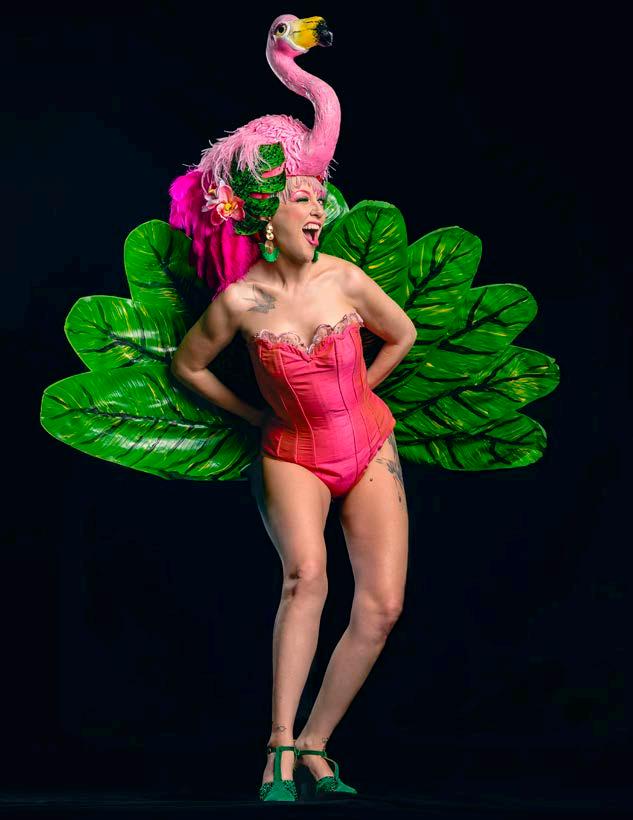



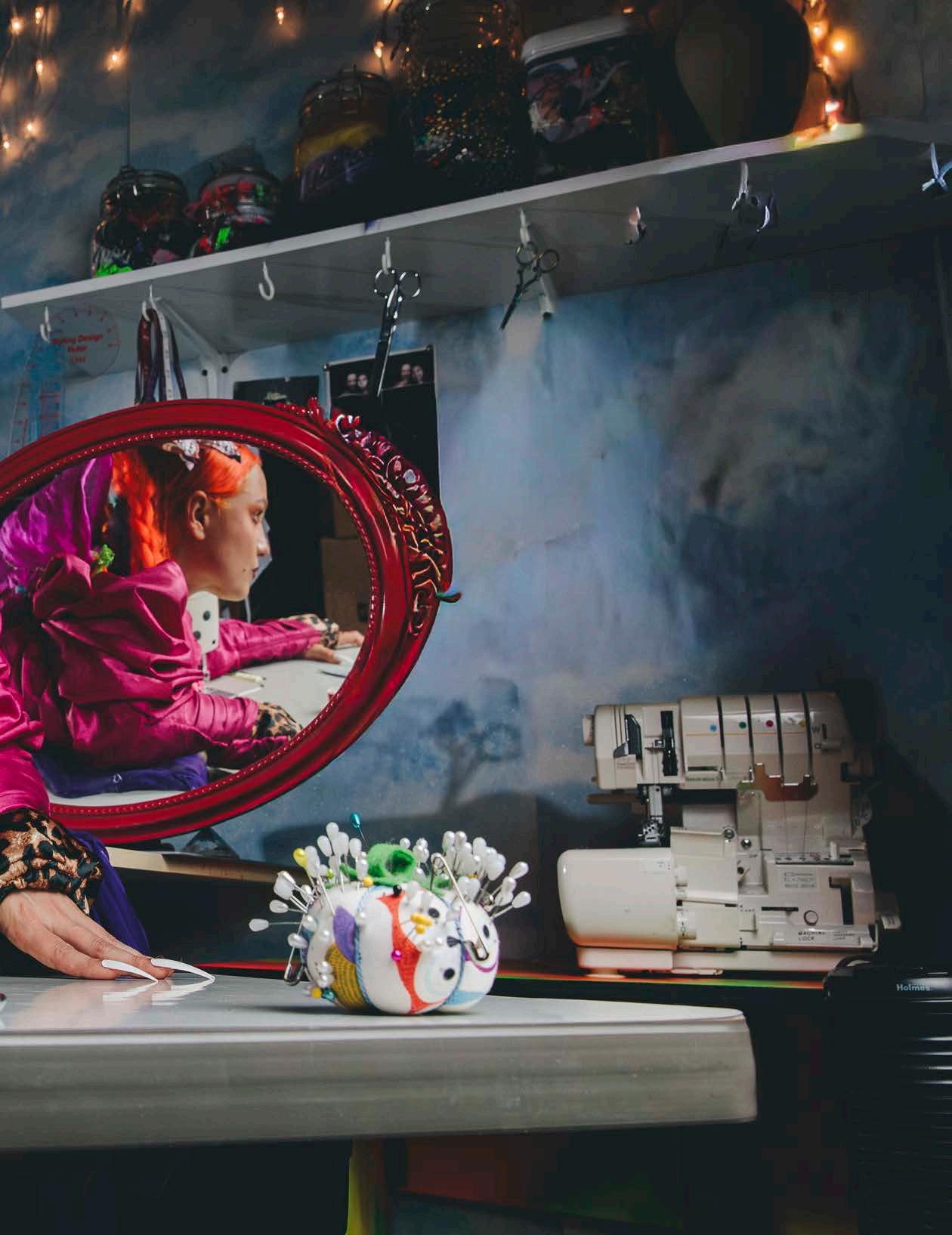
By Alisha Proffitt • Photos By Matt Johnson
Meet Web Richards, a standout local artist who has had us willingly caught in her web for years. “I am a sustainable fashion designer and artist, focused on spinning the ‘trash’ of our current culture of disconnection and greed into glamorous treasures for a more connected, sacred, loving future.”
The project is called The Web Has No Weaver. “The name was inspired by a philosophical concept from Taoism, emphasizing the universe’s interconnectedness without a single creator or divine weaver. I felt this name really encompassed my goal with my art–to remind each other that we are all connected and we get to create our reality. We have the power to change harmful industries, make the world a more colorful place, break free from constraining labels, and live more freely.”
This is wearable art that starts in the discard pile, rescued from flea markets, thrift racks, and donation bins. “I have been training my spidey senses when it comes to textiles and objects for a very long time. I grew up treasure hunting at thrift stores and flea markets every weekend. You can really feel if a piece is special, has history, or potential if you tune into its energy. It also helps that I am naturally attracted to vibrant colors and patterns, which always stick out the most.”
For Web, it’s both scavenging and spellcasting. “I see our bodies as blank canvases and getting dressed as a unique way we get to communicate our inner worlds every day. It’s a universal language that we are all forced to speak, whether we like it or not. Dressing extravagantly is a way I like to honor and celebrate life, while also bringing joy to others and inviting conversation from like-minded strangers. It’s a key to unlock a part of ourselves, and inspires others to unlock it in themselves as well.”
Narratives are stitched into the pieces. “I often write narratives for my collections, and see my models as characters I am costuming for a film.”
For their debut, Web conjured The Gleaner’s Grimoire. “I wrote a post-apocalyptic sci-fi about a rebellious community that forms an alliance with nature’s master regenerators: spiders & fungi: to heal themselves and the planet through sustainable, vibrant expression. We staged it in a field, behind the house I was living in with friends during the pandemic, which became a sort of artist commune. So the show was inspired by my life at the time, and how we were all dedicating ourselves to creating art and finding healing in the midst of this intensely dark period.”
Then came Victorian Athleisure. “The first thing that sparked it was receiving a large donation of secondhand deadstock spandex and jersey, which are fabrics that are typically associated with sportswear. I thought it would be a funny commentary on the current popular style of dressing ‘athleisure,’ which I find to be incredibly boring, and turn it into something over-the-top. I am often inspired by time periods where people dressed more decadently, so I borrowed silhouettes from the Victorian era like puff sleeves, high necks, or draped skirts.”
The runway, unsurprisingly, did not disappoint. “The models stuffed themselves with chocolate cake to a chopped and screwed soundtrack of Vivaldi. I like to remind people that fashion can be fun and silly– life is a big game of dress up after all.”
Her work on Arachnephilia! then leaned into spiders and myth. “Spiders have always been my lifelong guides; they show up whenever I need help. They are so misunderstood, thought to be these terrifying, evil creatures when they are actually beautiful and sweet. They are also a symbol of divine femininity in many cultures, and similar to spiders, feminine energy is often misunderstood and subjugated.”
“In the Greek creation myth, Arachne is turned into a spider as punishment for being too confident in her craft, and for calling out the Gods for their abuse of humans– speaking truth to power. So I wanted the collection to be a celebration of her fierce, feminine, creative energy. The designs mirrored that by becoming a blend of sexy, feral looks hanging in the balance between softness and power.”
The show was both stunning and jaw-dropping. Web has built a reputation for being bold and unafraid of ruffling a few feathers with her work; this was no exception. “The show began with Angel 004 singing ‘Women’s Work’ by Kate Bush as masked and cloaked figures pulled pins from pin cushions and began pricking her. ‘Women’s Work’ transitioned into ‘Work This P****’, as the figures ripped off their masks and coats to reveal skimpy outfits and started voguing. I loved the idea of messing with the audience’s expectations, setting a serene tone and then doing a sudden 180– turning it into a hot, fun dance party, celebrating the complex and beautiful chaos that is femininity.”
These days, comfort too has entered Web’s design language. “I used to not think about comfort at all when designing because I thought it would limit my work, but lately I have committed myself to making my pieces extremely comfortable to wear because I want my customers to not only look free but feel completely free to move in the world. I also make all my pieces adjustable, so they can fit multiple different body types, or fit one person throughout different stages in their life because a lot of us go through body changes.”
She believes the seams themselves are statements. “It is very important to me that when you see a web, you know it’s a web. For example, I sew all of my clothing inside out to make the seams and the hard work of creation visible. Not only is it a beautiful embellishment, but it helps people start to understand how time-intensive it really is to make clothing, and thus we should honor it, and not treat our clothing like disposable trash.”
What is the spell cast with every web? “I see my designs as spells, helping anyone wearing a web to be more present, live life to the fullest, and remain open to new experiences. I dream about growing and building a team because the world really needs more webs! I would love to create even bigger, more fantastical shows that incorporate large-scale installation work, as well as fashion films. The web is being weaved.”
For more information visit: thewebhasnoweaver.com



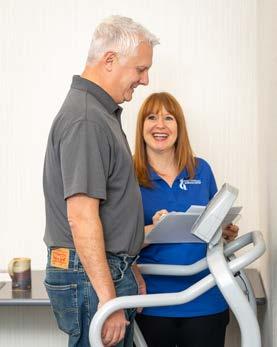
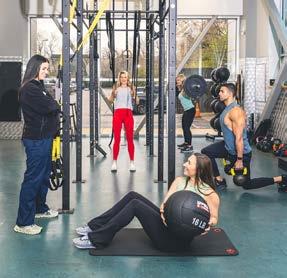



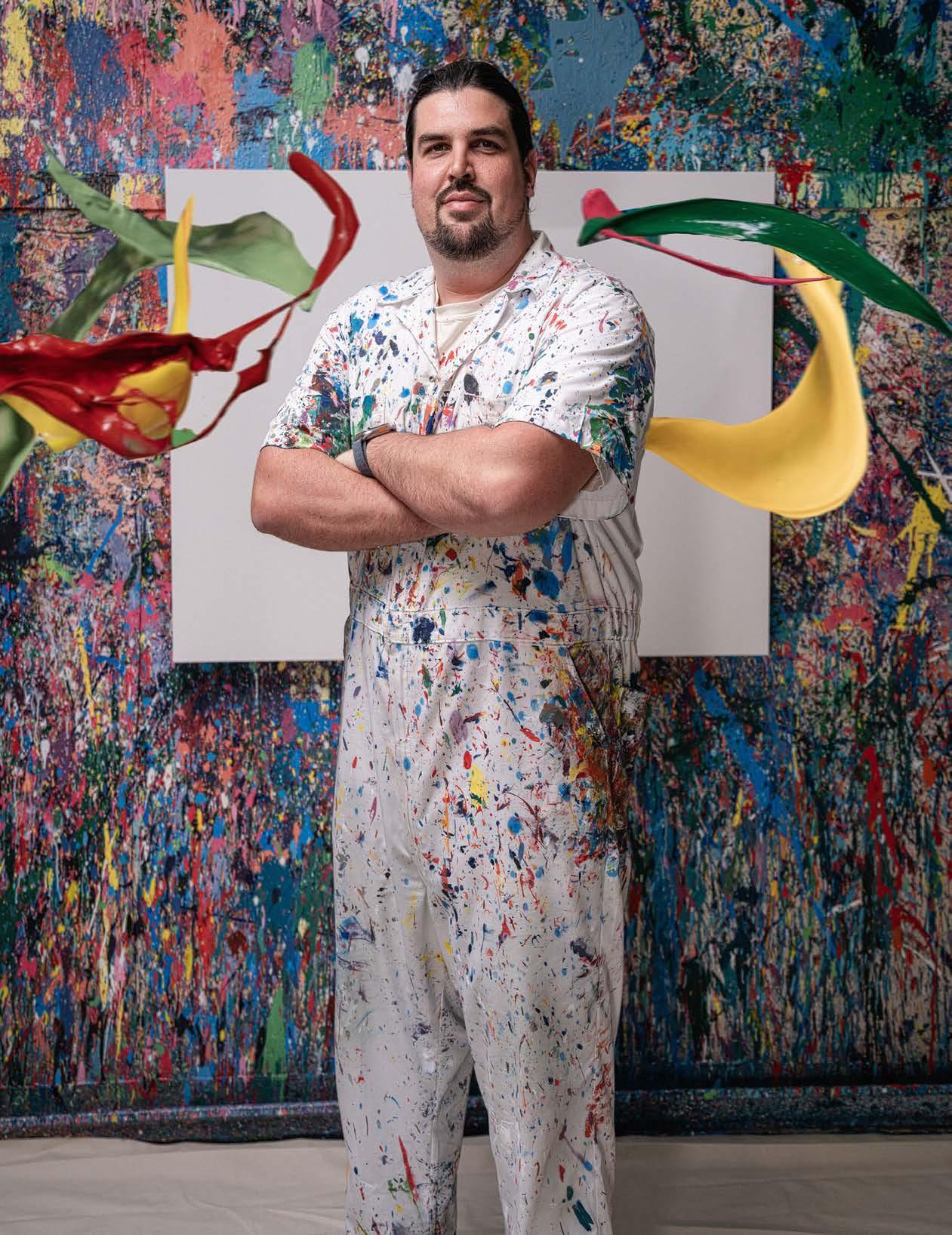
By Alisha Proffitt • Photos By Antonio Pantoja
Louisville has no shortage of places to see art. Galleries, theaters, the murals climbing brick walls throughout Highlands and downtown Louisville. What it did not have (until recently) was a place designed for the dabblers, creatives, and curious minds to participate in a more unstructured joy of making it.
Enter The Splatery, a new splatter-paint studio opened by Anthony Lopez. His concept is pretty simple: give people paint, tools, and protective gear, then set them free to hurl color across a canvas. The results may or may not resemble traditional art, but that, Lopez insists, is the point.
“I love the idea of creativity without rules,” he said in a recent conversation. “Traditional art can feel intimidating.”
Lopez first encountered splatter-paint studios elsewhere, where he saw how guests lit up when allowed to abandon technique and play. When he began searching for a city to start his own venture, Louisville surfaced repeatedly. Its massive arts community and sense of livability appealed, and family ties in Kentucky made the decision feel, as he put it, “like coming home.”
Guests arrive, check in, and slip on gloves and shoe covers, or full-body suits for those wary of the inevitable mess. A 30-by-40-inch canvas stands ready. Cans of red, yellow, blue and white paint line the space. And then, for the next hour, restraint gives way to motion.
“People come not to learn, but to play—with color, with movement, with texture,” Lopez said.
The format has proven especially popular for groups. Companies bring employees for team-building; bridal parties trade champagne flutes for paint brushes. Lopez admits the logistics are more complicated (more canvases, more cleanup) but the rewards outweigh the hassle. Watching coworkers shed their usual formality, or guests letting loose, feels like its own kind of artistry.
All fun aside, safety is an important factor in the experience. Paint is selected specifically for splattering, and staff manage cleanup so guests can focus on the experience. “People need to feel safe enough to get wild,” Lopez explained.
For those who arrive doubting their creativity, Lopez offers some reassurance. “Everyone is an artist.”
Lopez opened the studio only recently, but already he is looking ahead. More sessions, collaborations with local artists, and perhaps new locations in other cities. His ambition is less about scaling quickly than about preserving what makes the studio special. “My hope for the future is that The Splatery remains a space where people feel free,” he said.
Louisville, it seems, has gained not only another studio, but a room where mess itself becomes a work of art.


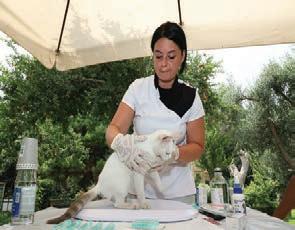

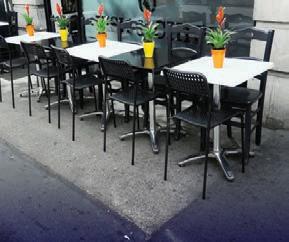







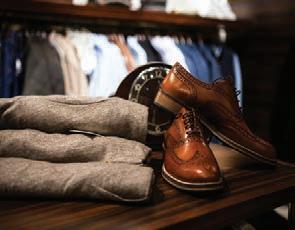
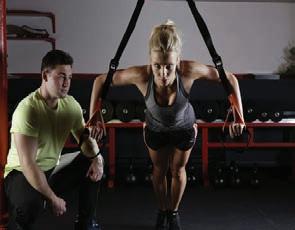


































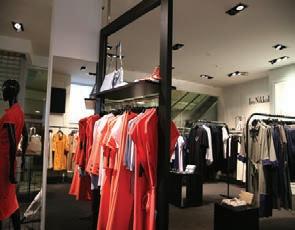

































LOUISVILLE’S FAVORITES, CHOSEN BY YOU!
e awards where the people decide. Celebrate the city you love by nominating and voting for your favorite businesses, places, and personalities. Nominations and voting are open now through November 10th, don’t miss your opportunity to pick your local favorites and share your voice!



By VOICE-TRIBUNE • Photos By Antonio Pantoja
Katie Kinman occupies a rare space in contemporary creative work, one defined by versatility, rigor, and a restless curiosity. Her career spans acting, casting, modeling, voice-over work, dance, singing, movement coaching, and even stunts. A constellation of skills that resists simple categorization. On her own terms, Kinman navigates the arts with range and depth, crafting a professional life that is as eclectic as it is intentional.
Among her recent screen roles, she appears in Gus Van Sant’s latest film as Al Pacino’s daughter-in-law, sharing scenes with Dacre Montgomery. Collaborations with filmmakers such as Adam Rehmeier, Michael Gallagher, Tamlin Hall, Alex Vlack, Billy Butler, and Lina Roessler further underscore a trajectory that moves fluidly between independent and larger-scale projects, drawing attention for both precision and nuance.
But Katie isn’t only in front of the lens; she is involved behind the scenes too. She works as an Assistant Casting Director (to Kathy Campbell at Campbell Talent Group Casting.). She is involved in two music videos; she has multiple new short films in the works. She has made a name for herself as a creative who both collaborates and leads.
We are proud to present Katie as our cover model for this volume. She was photographed at The Splattery by Antonio Pantoja, wearing body paint designed by celebrated local makeup artist Matt Goodlett. In this striking visual collaboration, Katie’s dynamic range of expression, movement, and presence shine through, not just as a model but as the artist she truly is.
Katie Kinman’s work embodies the kind of fluid creativity increasingly rare in a world of narrowly defined roles.
For a closer look at her evolving career, visit katie-kinman.com


The Seer and the Sword. A movie, a memoir
By Antonio Pantoja
Some stories take years to wrestle out of you. Others descend like a prophecy carved into stone, demanding to be told.
The Seer and the Sword came to me in just four days. But the truth is, it was never really mine alone.
It started as a late-night idea with my daughter, Echo. We had been playing Skyrim together, talking about how incredible it would be to step into a world like that on film. So we came up with a few ideas for a movie. That night, while she slept, I stayed up until five in the morning fleshing out the bones of the story. At 7, I woke her for school, but before she could even brush her teeth, I had to tell her everything. We went back and forth for so long that morning, sharpening and shaping this world together, that she was late to school. That’s how alive it felt.
I wrote the script in four sleepless, furious days. Every word poured out of me because I had one person in mind the whole time, my brother and close friend, John Wells. John wasn’t just an actor I wanted for the part. He was the part. I could see him in every frame, carrying the weight of this story on his shoulders.
But when I finished the draft, I realized the soul of this story belonged to someone else too, my friend Sabrina. She had been through battles that mirrored the wounds hidden in this film. I knew in my bones it needed her voice. Yes, it would be healing for her. But selfishly? I wanted her fingerprints on this story. I wanted her perspective woven into its marrow.
The film itself follows Therin, a weary father and former monster hunter whose world is torn apart when a beast attacks his home, killing his wife and leaving his daughter Lyra at death’s door. Desperate to save her, Therin seeks the aid of a mysterious Oracle. To keep his child alive, he must become the warrior he once was, but every step back into that life risks devouring what little humanity he has left.
Imagine the brutality of John Wick set against the sweeping myth of Game of Thrones and The Witcher, but infused with the haunting emotional core of Pan’s Labyrinth. That’s the essence of The Seer and the Sword.
The last five years of my life have been scar tissue, grief, and clawing my way toward redemption. Writing this film was like ripping open the curtains of my chest and letting people see inside of my soul. It’s what’s truly in my heart. It isn’t just a film, it’s a warning shot. A howl in the night.

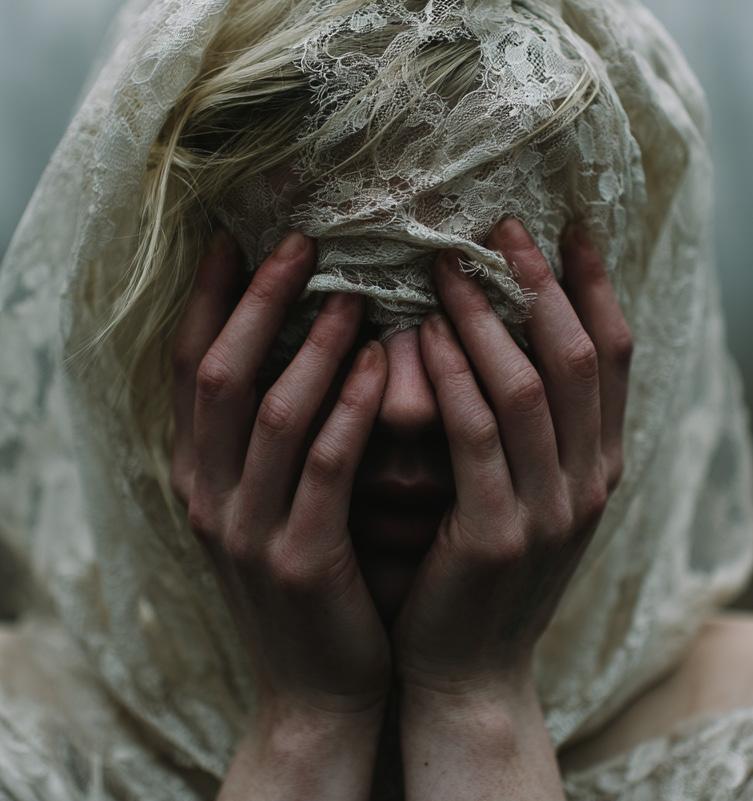
When audiences see The Seer and the Sword, they’ll feel it. They’ll know it was born of grief, loss, love, and survival. It’s not a fantasy escape; it’s a mirror, dressed in blood and myth.
And now, the hard part: bringing it to life. We plan to shoot this December, but indie filmmaking doesn’t happen without a community. We’re raising money right now to get this film made, and every dollar will be visible on screen. If you want to be part of something raw, haunting, and unforgettable, I invite you to join us.
Scan the QR code to watch the trailer and to get involved with the crowdfunding campaign. You can follow our journey or get involved in the film yourself there. You can pre-buy tickets to the premiere, a t-shirt, or even be in the film yourself.
This isn’t just my film. It’s ours.
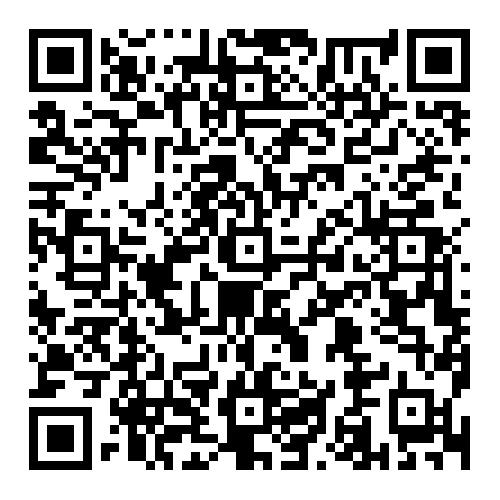






Celebrating 30 years of fellowship and creativity!

AB30 Opening Reception: November 8, 10am-12pm th Breakfast bites, music & Bloody Mary bar available!

Artists' Breakfast Group Louisville was founded to build community among artists. For 30 years, members have gathered every Thursday at local eateries to share food, creative ideas, and professional insights. This year, the group marks its 30th anniversary with AB30, an exhibition at Louisville Visual Art featuring 39 current members.
Opening this October — Discover a curated collection of the world’s finest luxury brands, including Matouk, Amalia Home, Branche, John Robshaw, Home Treasure, Yves Delorme, European Soaps, and more. Indulge in timeless comfort, exquisite design, and everyday elegance.







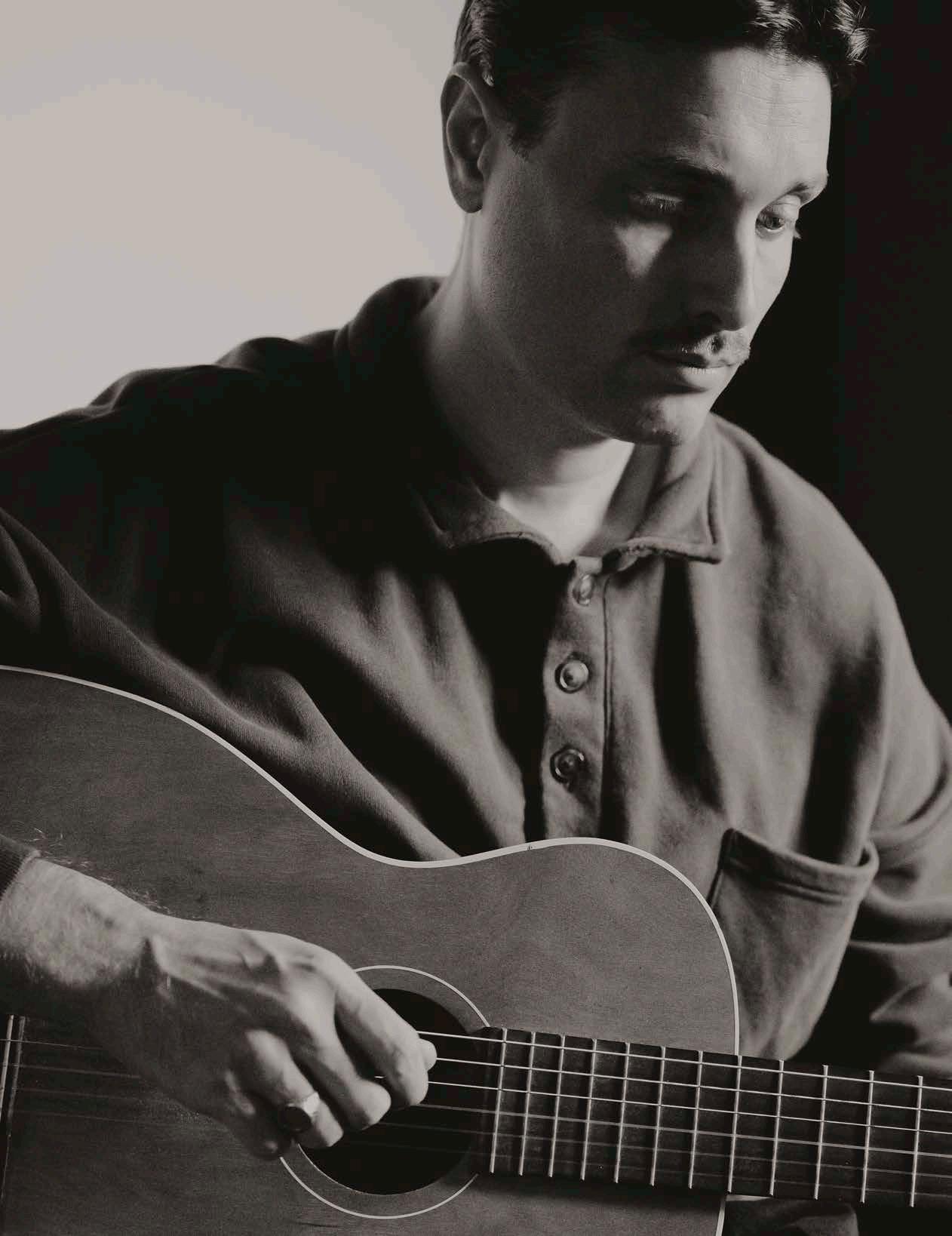

By Kelsey Knott • Photos By Matt Johnson
Allow yourself to be transported through the sound of the Ruen Brothers, an international band from Scunthorpe, England, who’ve played major world stages like Glastonbury, Coachella, Bonnaroo, Edmonton Folk Fest, and more!
Encouraged by their grandmother, who always regretted not learning the piano, Henry and Rupert Stansall learned guitar in their youth. “As soon as we learned to play, we started trying to write songs.” With supportive parents who often played American artists at home, the Ruen Brothers started gigging the pub circuit as young teens in their steel town on the northeast coast. Moving to London at 20, they recorded music in their tiny apartment, a passion of Rupert’s from the four-track tape days when he was 11 to the GarageBand and Logic era in their early adulthood. Their song “Aces” was picked up by BBC Introducing, finding its way to Zane Low, who played it back-to-back three times on Radio 1. “We went from nobody really wanting to know us and telling us we weren’t ready yet to the whole industry wanting to sign us.” Through their label, Republic, they connected with Rick Rubin to make their first record, as he shared their vision to create something cool and brought in amazing players like Chad Smith from the Chili Peppers and Matt Sweeney. They feel fortunate in their ebb-and-flow music journey, and each record since their first returns to their roots of self-producing and recording.
With an ethos of creating transportative music, Henry stays inspired by film and visual media. “The reverbs are intentional. Listeners close their eyes, and maybe they’re in a huge, cavernous outdoor space, or standing in front of the ocean. Awooo explores that, more than any other record.” Writing daily and spending time outdoors is also key: “In natural environments, your mind becomes neutral and balanced. Walking or running through the woods helps the creative brain because you come back refreshed with a different perspective. It’s giving you a chance not to think, and when you’re in the process of not thinking all too much, naturally, the ideas start to come, and they start to bloom.” Henry and Rupert tend to write separately and come together with their best ideas to create consistency within the record, and this workflow can produce quick results, such as their upcoming lead single, “Sitting at the Station,” which came together in less than half an hour.
Of the cities in which they’ve resided, this city feels the most like their home in Scunthorpe. Unlike the chaos and fast pace of larger cities, Louisville allows for respite, making room for energy focused on being purely creative. Furthermore, the Monarch creates a no-pressure community space made for listening, supporting, and enjoying. “I don’t know anywhere as unique. Mark immediately welcomed me and made me feel at home. There are so many resources here for local artists and touring artists, and it encourages creativity, growth, experimentation, and collaboration.” Henry helps further the space’s growth with his production of The Monarch Living Room session series.
While the industry evolves and changes, Henry urges creatives not to force themselves to fit into the industry model, as it can lead to a loss of creative transparency. “Create things you want to create and enjoy creating. If you make something you like and think is cool, just share it, and keep doing that consistently. Small bits of momentum will build if you stick with it, and when you do something good, the industry will come to you. The only thing that should really be evolving and changing is you, as a creative.” Stansall hopes listeners feel stirred emotions from experiencing their music, and receiving messages from fans about their songs helping them through tough times makes it feel worthwhile to the Ruen Brothers.
On October 17th, the Ruen Brothers release their fourth studio album, Awooo, three days after their single “Sitting at the Station.” Check out ruenbrothers.com for upcoming shows this fall!

By VOICE-TRIBUNE
Independence Bank is showing once again that small acts of kindness can make a big difference. Its second annual Day of Good, which launched on September 5, 2025 in Owensboro, has already brought together more than 425 volunteers from the bank and surrounding communities to lend a hand across 15 counties in Kentucky.
The Day of Good isn’t just a single day of service; it’s a six-week initiative designed to support local organizations and neighborhoods through meaningful, hands-on projects. Volunteers have spent the past few weeks cheering on athletes at the Special Olympics Kentucky state softball tournament, building and delivering beds for children and seniors, preparing meals, and helping with repairs that improve daily life for families in need.
A highlight of this year’s initiative was the bank’s support of the Special Olympics softball tournament in Owensboro. Volunteers helped ensure the event ran smoothly and that athletes had the resources they needed to compete and celebrate their achievements. The effort underscored a larger message of the Day of Good: supporting communities isn’t just about tangible projects; it’s about creating spaces where everyone feels included and valued.
Volunteers also tackled practical, neighborhood-level needs. Through a longstanding partnership with the Warren County Housing Authority, they built and delivered beds for children and seniors, bringing comfort to families who needed it most. Other projects included meal preparation for local first responders and nonprofits, as well as essential home repairs, showing that even small acts of service can have a meaningful impact.
What makes the Day of Good truly special is how it brings people together. Employees and community members worked side by side, strengthening connections and building friendships while helping their neighbors. The program demonstrates that giving back is not only about helping others; it’s about building stronger, more connected communities.
The initiative will continue through October 18, with the bulk of volunteer efforts taking place on September 20. By the time the Day of Good wraps up, Independence Bank will have helped improve homes, provided meals, delivered beds, and shown hundreds of volunteers the power of lending a hand.
Through this ongoing effort, Independence Bank is proving that doing good doesn’t have to be complicated. A willing heart, a few helping hands, and a commitment to community can leave a lasting impact and inspire others to do the same.
For those interested in joining the remaining projects, Independence Bank encourages community members to visit its website or social media pages for details on how to get involved.
Every gift has the power to shape a stronger, more vibrant community. From nurturing creativity and learning to preserving beauty and providing vital support for families, the impact of giving extends far beyond the moment—it builds a foundation for future generations.
The Voice-Tribune’s Giving Back Guide brings together eight remarkable organizations that embody this spirit of service. Each one plays a unique role in enriching lives and strengthening the fabric of our city, and together, they remind us that generosity is one of our greatest community traditions.
As you explore this guide, we invite you to discover new ways to connect, contribute, and celebrate the causes that matter most to you. Because when we give back, we don’t just support important work—we help create the community we all want to call home.


Just outside of Louisville in Crestwood, Kentucky, Yew Dell Botanical Gardens offers 60 acres of inspiration, education, and beauty. Once the private estate of legendary plantsman Theodore Klein and his wife Martha Lee, Yew Dell grew from family farm to nationally recognized public garden. Today, it is listed on the National Register of Historic Places and welcomes visitors year-round to explore curated display gardens, woodland trails, historic architecture and ongoing plant research.
As a nonprofit organization, Yew Dell’s mission is to spark a passion for plants and gardening through accessible science and inspiring beauty. That passion comes to life in every corner of the gardens — from seasonal displays and family-friendly events, to hands-on workshops and educational programs designed for gardeners of all levels.
Community support makes all of this possible. Whether through annual fund gifts, honoring a loved one with a tribute bench, or leaving a bequest, every donation directly fuels Yew Dell’s ability to connect people with plants. Memberships, too, help sustain daily operations while offering free admission, discounts and reciprocal benefits at gardens nationwide.
For those who prefer to roll up their sleeves, volunteering at Yew Dell provides a chance to learn new skills and give back in a meaningful way. With opportunities in the gardens, natural areas, events and even office work, there’s a place for every interest and talent.
Learn more, become a member, or support the mission at yewdellgardens.org
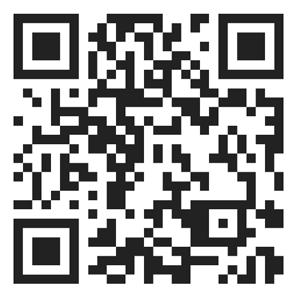
HELP US KEEP THE LIGHTS BRIGHT!
Donate today to support the Artists and artistry of your Louisville Ballet:
$30 buys a pair of ballet shoes
$60 provides a leotard and tights for one Ballet Bound student
$125 buys a pair of pointe shoes for a Company Artist
$200 provides snow for a performance of The Brown-Forman Nutcracker
$275 Covers performance tickets for students from a Title I school
$500 funds one Boys, Books, + Ballet library program
$850 brings one Moving Stories educational performance to the community
$1,700 awards a Ballet Bound student a first-year Community Scholarship
$1,800 supports an in-school Community Engagement residency
Your donation makes a difference!
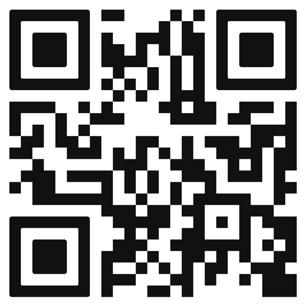
WATERFRONT BOTANICAL GARDENS: Where the Future Blooms
Waterfront Botanical Gardens has blossomed from a former landfill into one of Louisville’s most inspiring destinations. A place where beauty, education, and community flourish together. Each year, more than 62,000 guests stroll the grounds, while over 3,000 children experience hands-on programs that spark curiosity and nurture a love of nature.
As the Gardens continue to grow, with new landscapes and educational spaces under construction, this remarkable transformation is just beginning. Your support ensures that today’s children - and tomorrow’s - can find wonder in nature.
Every contribution makes a difference. Philanthropy sustains the Gardens’ beauty, expands its programs, and strengthens its role as a cultural treasure for Louisville. By giving, you help create a legacy that enriches families, inspires visitors, and elevates the city for generations to come.
Together, we can ensure the Gardens remain greener, stronger, and more vibrant. An oasis that reflects the best of our community.
Discover more and help the Gardens grow for generations to come at waterfrontgardens.org/support
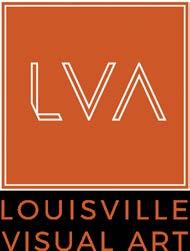

Louisville Visual Art (LVA) has been a cornerstone of creativity in our city for over a century, shaping Louisville’s cultural landscape through programs that empower artists, inspire youth, and build stronger communities. Guided by three core pillars—Youth Art Education, Artist Support and Development, and Public Art and Community Building—LVA connects people to the transformative power of visual art.
Through our Youth Art Education over the last 100 years, LVA’s Children’s Fine Art Classes (CFAC) program has provided young people with rigorous arts instruction that builds cumulatively over weeks in the fall and spring semesters. CFAC has nurtured generations of creative thinkers by developing technical skill, artistic voice, and confidence. LVA also offers outreach programming, extending access to high-quality art education throughout the community.
LVA’s commitment to Artist Support and Development ensures that working artists have the resources they need to thrive. We hire local artists as instructors, muralists, and program leaders. We invest directly in their careers by purchasing artwork for programs and offering exhibition opportunities that connect artists with audiences. LVA strengthens Louisville’s creative economy and ensures artists can build sustainable careers.
With a focus on Public Art and Community Building, LVA brings art out of the gallery and into neighborhoods. Through murals, permanent art installations, and community partnerships, LVA creates accessible, inclusive spaces where people come together, connect, and celebrate shared stories through art.
Together, these three pillars reflect LVA’s mission: More Art [for] More People [in] More Places.
Learn more and get involved at louisvillevisualart.org


Metro United Way is on a mission to raise $75 million by 2030 to change the trajectory of lives across the Greater Louisville region, where 21% of families struggle to afford basic needs like food, housing, child care, and transportation.
Serving these families will not only help them, but it will reduce social costs associated with poverty, decrease reliance on public benefits and services, and increase local economic activity.
If Metro United Way and its partners increase the annual income of these households by an average of $5,000, it could have a nearly $776 million impact on our community and increase the number of individuals in the workforce by more than 15,000. That is a major win for all of us!
From basic needs supports to policy changes to equity-driven strategies, Metro United Way works to create a better community for every person in every neighborhood. Donate today!

The Norton Children’s Hospital Foundation, the philanthropic arm of Norton Children’s, raises millions of dollars each year to support programs, equipment and facilities, research, advocacy and education for Norton Children’s Hospital, Kentucky’s only full-service, free-standing pediatric hospital; Norton Children’s Medical Center; and pediatric services at Norton Women’s & Children’s Hospital.
Norton Children’s Hospital and its related pediatric facilities are not for profit and rely on the community’s support to provide medical care for all children. This funding is vital to advancing groundbreaking research, providing new technology, enhancing programs, helping bring new medical providers to Louisville and even expanding and renovating facilities – all to ensure the children you love continue to have the health care they need.
The main purpose of the Norton Children’s Hospital Foundation is to provide the medical care children need to live long, healthy lives. When children need medical care, the entire family is often involved. It can be a stressful situation. If that medical care is not available close by, it requires long drives and a disconnect from home. By ensuring that Norton Children’s Hospital and its related facilities have all of the specialties and necessary care, it reduces the burden on families.


Family Scholar House (FSH) is more than a nonprofit— it’s a lifeline for families determined to build better futures.
With a goal to transform communities by empowering families and youth to succeed in education and achieve self-sufficiency, FSH stands beside stufent parents and their children as they break free from cycles of poverty.
FSH provides safe affordable housing, educational support, career coaching, and essential life resources. But what truly sets it apart is the love and belief poured into every family. Each individual is seen, heard, and supported— not just as a student or caregiver, but as someone full of potential.
Volunteering at Family Scholar House is a chance to witness real courage. Whether you’re tutoring a determined mom working toward her degree, packing food boxes for families, or simply offering a kind word, you’re helping rebuild lives. You’re not just giving your time—you’re giving hope.
Family Scholar House reminds us that no one should have to walk alone. Every act of kindness, every shared moment, helps light the path forward for families chasing a brighter tomorrow. Through service, we become part of their story—a story of strength, transformation, and endless possibility.


Kentucky College of Art + Design (KyCAD) is Kentucky’s only independent, nonprofit college dedicated exclusively to art and design. Located in Old Louisville, KyCAD offers a transformative education rooted in contemporary practice, interdisciplinary exploration, and community engagement.
KyCAD’s original Bachelor of Fine Arts in Studio Art has long empowered students to explore diverse creative practices—from painting and sculpture to performance and digital art. Now, KyCAD is expanding its academic offerings with six new BFA degrees designed to meet the evolving demands of the creative industries: Body Art, Digital Fabrication, Experimental Fashion, Film, Graphic Design, and Olfactory Art and Sensory Practices. These innovative programs reflect KyCAD’s commitment to pushing boundaries and redefining what an arts education can be.
With a curriculum that emphasizes hands-on learning, critical thinking, and professional development, KyCAD fosters a vibrant studio culture led by practicing artists, designers, and scholars. Students benefit from small class sizes, personalized mentorship, and access to cutting-edge tools and technologies.
KyCAD is deeply embedded in Louisville’s dynamic arts and culture scene. Through meaningful partnerships with local organizations, students gain access to hands-on experiences, professional networks, and opportunities to collaborate beyond the classroom. These connections not only enhance their creative development but also help them build lasting relationships within the broader artistic community. Dedicated to promoting a creative and productive life, KyCAD is shaping the next generation of artistic visionaries and cultural innovators.
Learn more at kycad.org

By VOICE-TRIBUNE • Photos By Kathryn Harrington and Provided By Y’ALL
When Rachel and Mayor Craig Greenberg first started going to city events with their son, they noticed something missing. “When we went to city events with our son, who was a junior in High School at the time, we noticed there were not a lot of high schoolers attending, at least few who didn’t seem forced to go by their parents. After conversations with him, we decided to create a city program to give high school students leadership opportunities and have their voices heard,” Rachel shared.
In collaboration with the Archdiocese of Louisville and JCPS, that idea became Youth Ambassadors Leading Louisville (YALL)—a program that invites two juniors from every Louisville high school, public and private, to roll up their sleeves and assist in some of the city’s biggest events. “Y’ALL is much more than a recognition program,” Greenberg explained. “Y’ALL offers two Juniors from every Louisville high school (public, private, Catholic, and independent) the chance to actively participate in shaping city events like Worldfest, Light Up Louisville, and Hike, Bike & Paddle.”
From the start, Y’ALL was about more than volunteering. It was about creating a citywide network of young leaders who could learn from each other. “Our city is large and the students represent a diverse group from every corner of Louisville,” Greenberg said. “Collaborating together helps build empathy and understanding; they learn from each other, make new friends, and make a positive impact.”
High school can feel uncertain, but Y’ALL turns that uncertainty into opportunity. “High school can be a time of uncertainty, but when young people are given chances to lead and collaborate, they gain confidence and learn the value of teamwork and service,” Greenberg said. “YALL was started to give them that chance—to be part of something bigger than themselves and to leave an impact they can be proud of.”
That impact is already being felt. “We are so proud of the YALL students,” Greenberg said. “They are leaders in their schools and communities. We want these student leaders to be future mayors, teachers, doctors, artists, engineers and entrepreneurs in Louisville.”
The students themselves share that pride. Eugene Diaz from Marion C. Moore School said, “This program opened my eyes to how exciting Louisville is. All the city events I volunteered in were amazing to be a part of, especially WorldFest and Light Up Louisville. Seeing many people of various backgrounds come together and enjoy themselves was a beautiful sight.”
At first, Diaz admitted, he wasn’t sure what to expect. “When I first got called into the counselor’s office asking if I wanted to apply to this brand new program, I of course said yes because I thought it sounded cool. But I was very skeptical on what this program would actually do for me. Little did I know this program would mean more to me than I could ever imagine.”
For Hannah Wooten of Christian Academy, Y’ALL was about being seen. “Being a teenager means it’s sometimes hard to be involved. Mrs. Greenberg made sure we had these opportunities. She learned all of our names and schools and made us feel seen.”
Her favorite memory came at Light Up Louisville: “I worked as an ‘elf’ and was in Santa’s Workshop helping take photos of all the eager families and children, learning the importance of giving back to my city. No matter what we do, if you do it with a smile it is always worth it.”
Others point to the unique behind-the-scenes opportunities. “Where else do you get the opportunity to meet new people, hang out with the mayor and first lady, and improve the Louisville community all in one package?” said Marie Laracy of Presentation Academy.
For many, Y’ALL was about courage. “When I first started my junior year and heard about YALL, I was scared to put myself out there,” said Cordelia Fleitz from Whitefield Academy. “I am not one to step outside my comfort zone but I know I wanted to be a leader and provider for my community and it was worth going outside my comfort zone.”
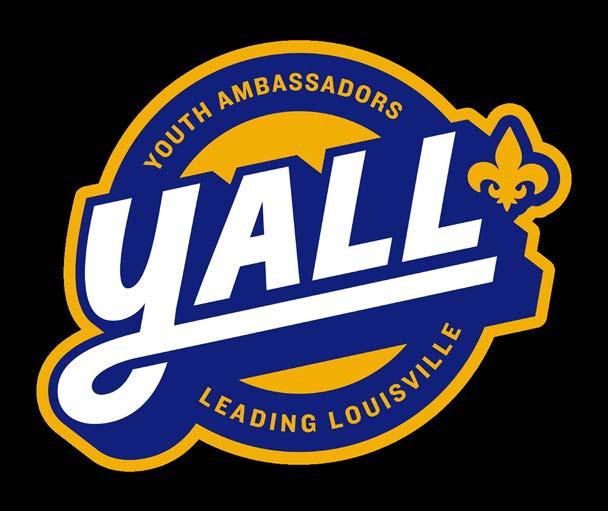
Her favorite part was seeing joy in others. “Seeing people in my community smile after writing on the wall at Worldfest or making gingerbread house magnets at Light Up Louisville was worth every minute of volunteering.”
That theme carried across the class. “We had our orientation where we got to meet every single high school,” said Kannia Davis. “We had 36 students come together. We did several different breakouts and confessions with them. So learning about ourselves and how our school shapes us was really interesting.”

For Jillian Beswick, it was about connections: “Meeting different people. And being able to experience meeting different high school students. And seeing all the different cultures and everyone coming together. It just warms my heart to see everyone coming together and helping everyone.”
Perhaps the deepest impact of YALL is how it shifts perspective. “The Youth Ambassadors Leading Louisville Program has been one of the most influential experiences during my time in high school,” said Jorge Blas from Butler Traditional High School. “I discovered the vibrant diversity that defines our city and developed essential leadership skills that taught me the true value of service. Along the way, I built meaningful relationships with people who share the same passion for making a difference.”
The program sparked inspiration for his future. “Through the YALL I have been inspired to create a meaningful career. A career rooted around community involvement, uplifting others, and advocating for change. I want to be a voice for those who often go unheard and a source of inspiration for those who need to believe in themselves.”
For Rachel Greenberg, that’s exactly the point. “Our hope is that every participant walks away not only with leadership experience but also with the drive to continue improving their community and making each experience better than the last.”
And the vision doesn’t stop here. “I hope that YALL students think of Louisville as a place to live, prosper and grow for generations to come,” she said.
If the inaugural year is any indication, that hope is already taking root. As Eugene Diaz put it best: “100 times out of 100, I would say yes to joining Youth Ambassadors Leading Louisville.”
For more information visit: louisvilleky.gov/government/mayor-craig-greenberg/youth-ambassadors-leading-louisville-yall



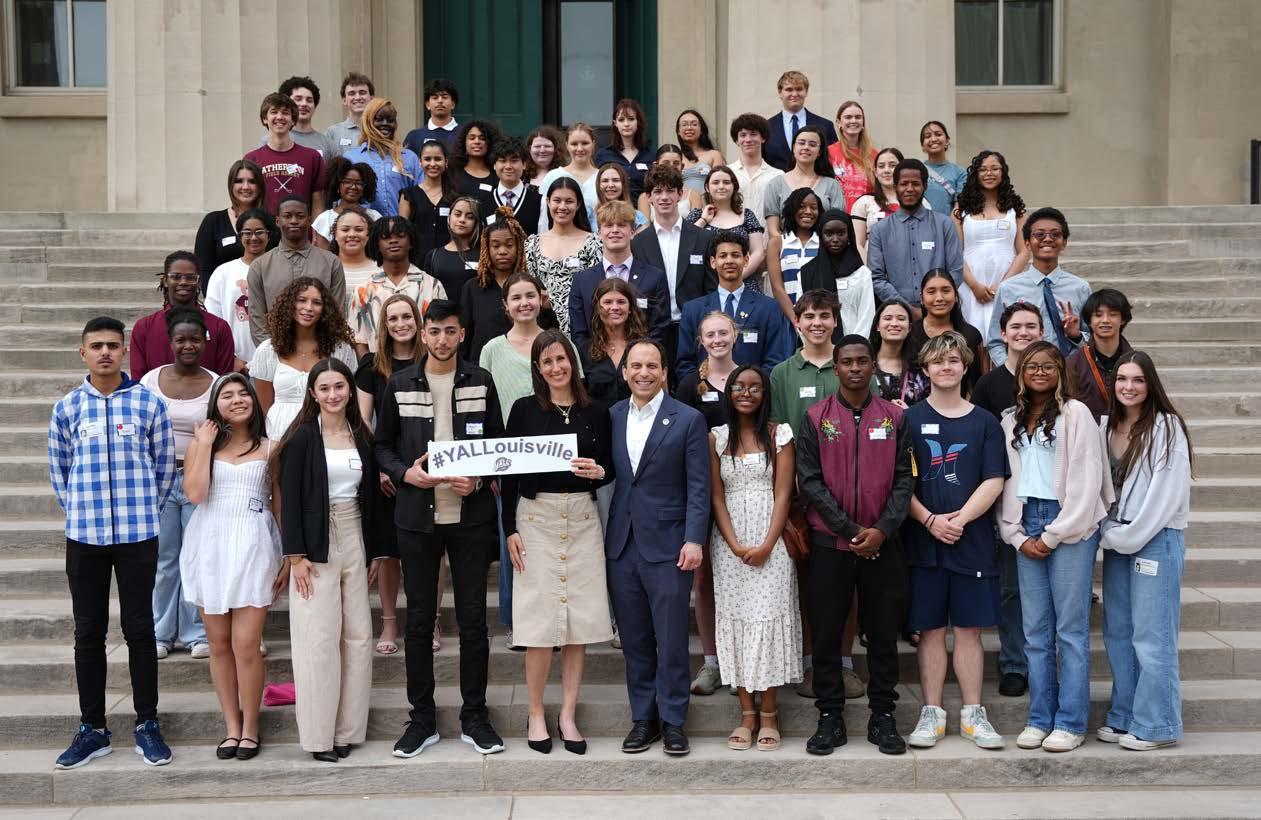


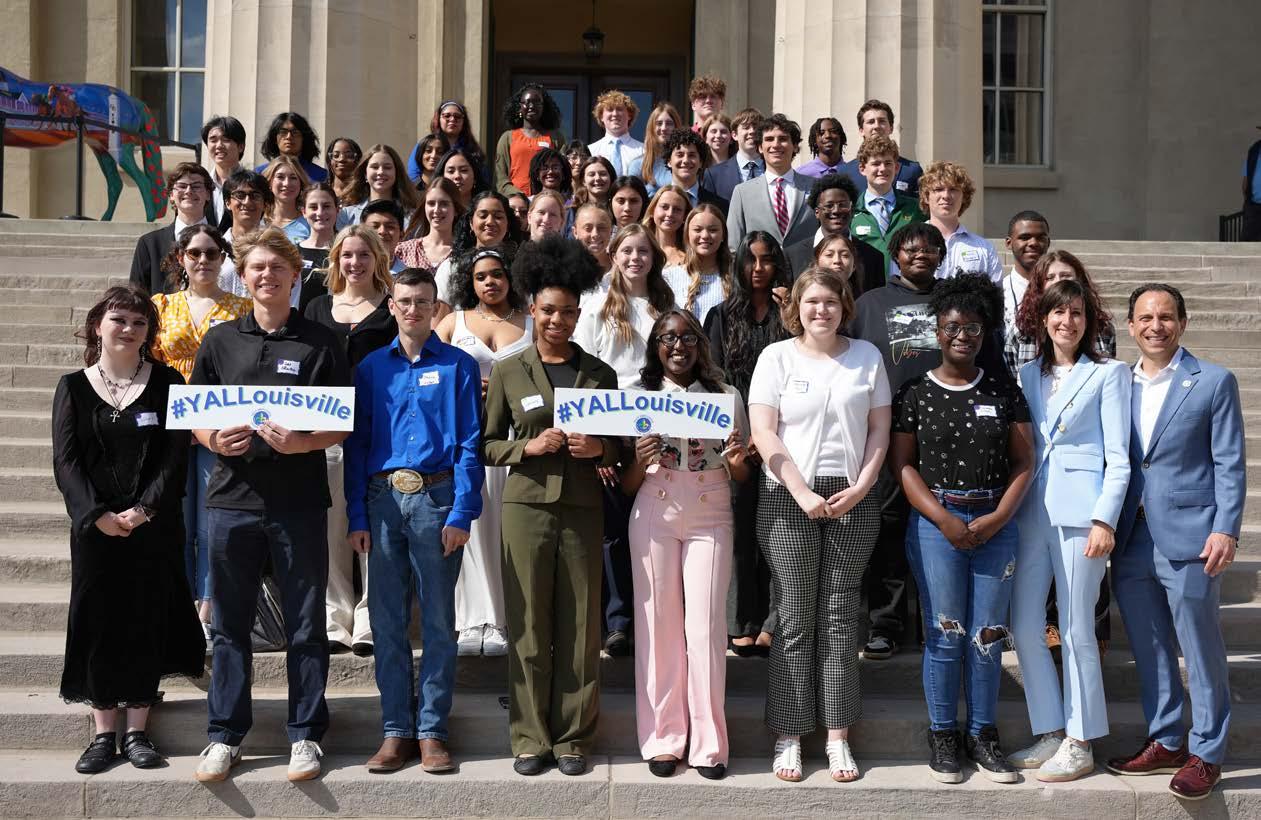







JOIN US FOR THE ANNUAL CHENOWETH SQUARE HOLIDAY WALK
Fr id ay, No v ember 7th 5-8pm


2025
2025






By Kevin Murphy Wilson | Photos Courtesy of Verena Gerlach
Earlier this year the Great Meadows Foundation unveiled an exquisite new book (with contributions from Natalie Weis, Julien Robson, John Yau, Peter Morrin and others) showcasing the substantial footprint of Louisville legends, Mary and Al Shands.
That tome, “Rounding the Circle,” which is available for purchase locally at Carmichael’s Bookstore, KMAC, and at Great Meadows Foundation’s Logan Street headquarters, perfectly captures the flavor of the contemporary art collection initially amassed by the couple at their estate in Crestwood, Kentucky (where they often held court, breaking bread with likeminded folks from near and far).
As such, many artists of note appear in this chronicle: Sandra Charles, Petah Coyne, Tony Cragg, Francesca DiMattio, Olafur Eliasson, Adrian Esparza, Wayne Ferguson, Ian Hamilton Finlay, Zaha Hadid, Alex Hartley, Anish Kapoor, Nina Katchadourian, Mel Kendrick, Sol LeWitt, Maya Lin, Elizabeth Murray, Ernesto Neto, Odili Donald Odita, Judy Pfaff, Jaume Plensa, Ken Price, Eva Rothschild, Ursula Von Rydingsvard, Susana Solano, Vian Sora, Monika Sosnowska, Summer Wheat, Peter Williams, and Betty Woodman, to name a few.
Perhaps even more importantly, though, “Rounding the Circle” also sheds a spotlight on the Shands’ legacy of providing support and encouragement to artists, critics, curators, and arts organizations, particularly those with ties to the Bluegrass State. The book suggests that their big-time backing began at least as early as the 1980s when Mary Shands was involved in the efforts to establish the Kentucky Art and Craft Foundation, which eventually evolved into KMAC Museum. And for his part, Al Shands was a steadfast Trustee of the Speed Art Museum, and also completed stints on the Boards of the Whitney Museum of American Art and the Museum of Modern Art in New York as well as the Peggy Guggenheim Collection in Venice.
That being said, and as “Rounding the Circle” attests, in recent years much of the couple’s (now posthumous) support for the arts has been funneled through the aforementioned Great Meadows Foundation, a non-profit organization established by Al Shands (roughly 8 years ago) that continues to foster the creative community here in the Commonwealth, with more than $1.25 million in grants given to Kentucky artists to date, according to a recent press release.
These impactful grants have afforded regional practitioners (and other visual arts professionals) such as Joyce Ogden, Lori Larusso, Rebecca Norton, Shohei Katayama, and countless others, one-of-a-kind travel and research opportunities. Louisville-based visual artist and educator Andrew Cozzens—who primarily researches time subjectivity and its effect on human experience and aging—said that it was largely through the support of the Great Meadows Foundation that he was able to travel to Taiwan, Mexico, Japan, and elsewhere. “Each of these places greatly informed the direction of my work in different ways,” Cozzens recalled. “And that kind of ongoing validation from the Great Meadows Foundation is a huge reason for artists to remain in Kentucky.”
For Julien Robson, Director of the Great Meadows Foundation, there’s no doubt that “Al and Mary Shands’ extraordinary vision for art and artists has left an indelible mark on Kentucky’s cultural landscape.” To him, the Shands’ collection amounted to much more than a “gathering of remarkable works.” It also spoke volumes about their sense of art as a vehicle for connection and continued growth. “Through Al’s thoughtful bequests to museums across the state, the creation of the Mary and Al Shands Art Preserve, and the enduring work of the Great Meadows Foundation, their legacy continues to inspire and support artists and communities alike. Al’s commitment to fostering creativity and bringing art into the lives of others is a gift that will go on, enriching generations to come,” Robson said in a statement celebrating the book.
For more information about “Rounding the Circle: The Legacy of Mary and Al Shands,” or to apply for a travel grant, visit greatmeadowsfoundation.org
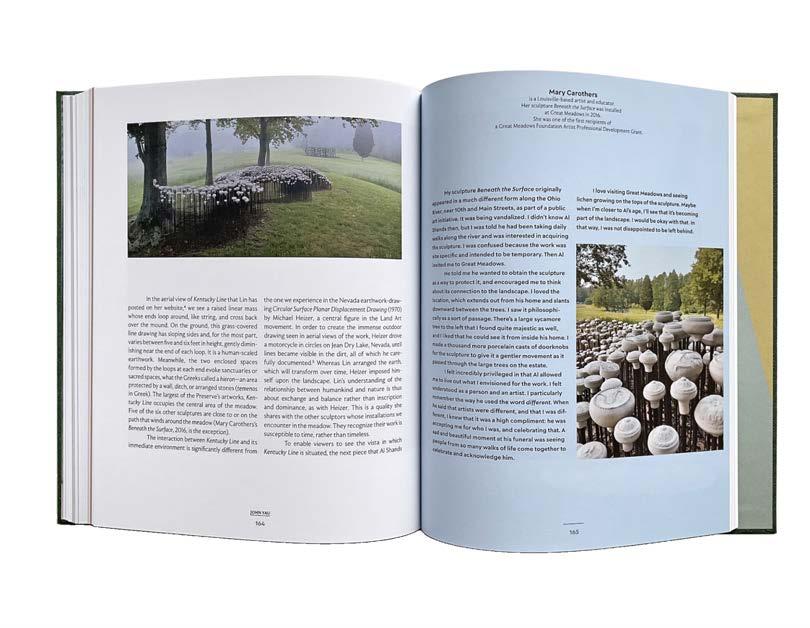
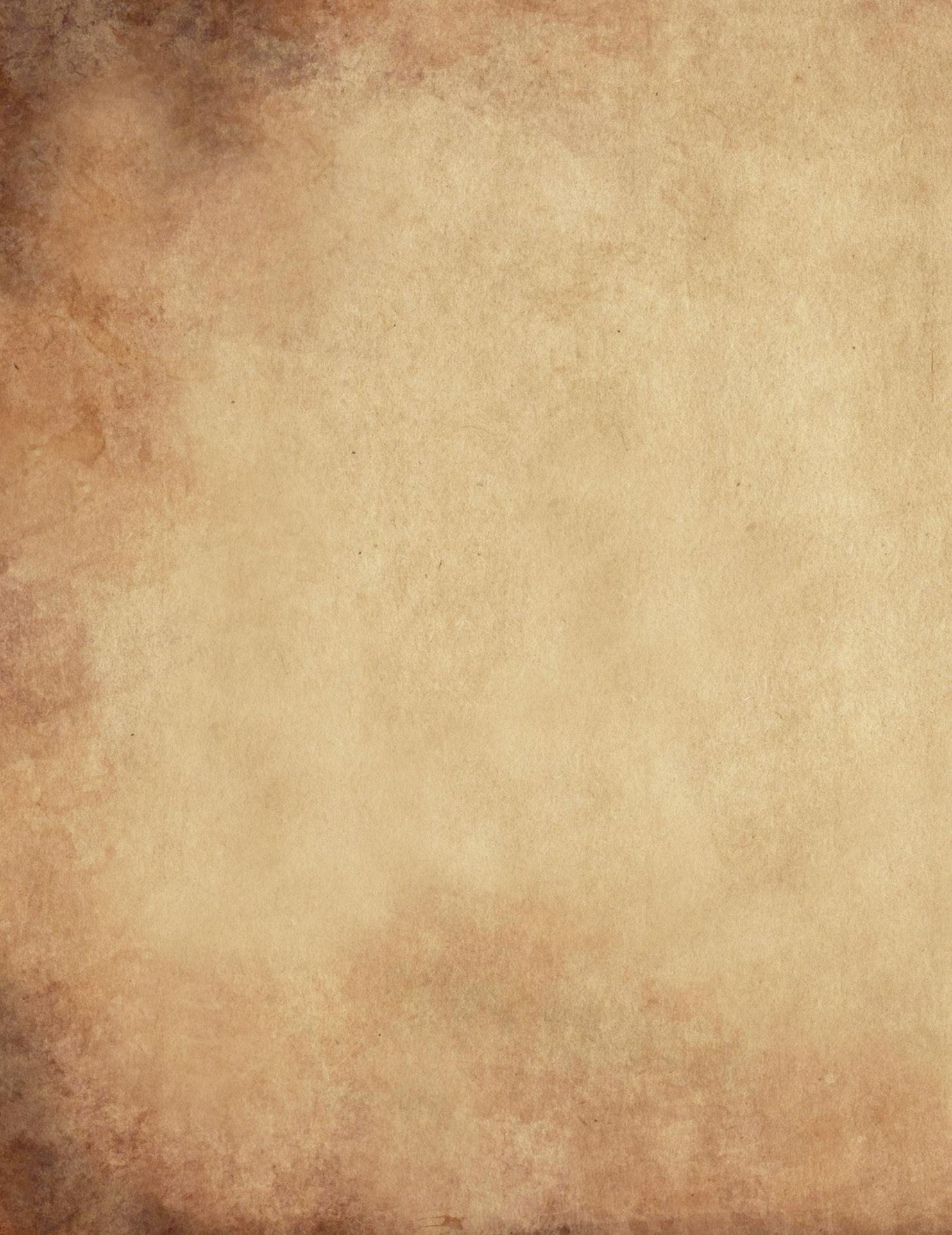
By Mary M Zoeller
My life had been lived in a pretty simple, follow the river sort of way. I went where the flow pushed me. I planted my flowers, my herbs, worked at aimless jobs, had lovely friends and a few courtships. My greatest joy was the garden and learning how, by nourishing the things that grew, I could help the health of myself, my friends, and my neighbors. I lived instinctively and peacefully and was happy.
I had always had green thumbs. Knowledge and experience helped me be a better gardener but never explained how random plants would just appear and grow so well in the tilled soil in my yard. Things like Autumn Clematis, butterfly weed, and foxglove would appear, and along with all the other flora, flourish. Maybe it was because I was willing to let that little new thing I didn’t recognize grow until I figured out what it was, but I always seemed to have the best luck in these’r andom appearances. My yards over the years, and wherever I was, always became filled with an abundance of beautiful or helpful plants, flowers, shrubs, and trees.
Over the years I gathered knowledge about those plants, what they could do and how they could help with all the simple maladies that populate all our lives. Sometimes I had the opportunity to share what I learned with my friends, my neighbors and all those I loved. This developed organically and slowly into a personal database of knowledge I could use to help others. It seemed a normal and happy thing to share with others.
I had lived in my present home for about six years. It was a very pleasant, older, blue-collar neighborhood with a nice mix of people of all ages. My house was a modest, one story, two-bedroom house with a garage and greenhouse. The greenhouse had been one of those serendipitous perks that had been there when I bought the home. I spent lots of time planning gardens of all kinds as the years passed. After six years there was an herb garden, shrubs, dwarf fruit trees, a cutting garden, flowers for color, eating and remedies. There was also the fire circle, the fishpond, and borders of shrubs and grasses for privacy.
On a June Saturday I was sitting on the steps leading down the deck with my morning cup of coffee. I was thinking about where I might put some kind of water feature and what it might look like. My cat Al, short for Alfonso, was sitting next to me and was allowing me to pet him.
He was a sleek black cat with brilliant green eyes. He had wandered into my yard as a kitten, shortly after I had moved in. One short snack after that he had adopted me, my house, and my yard as his home. Early on I had to teach him to stay away from the birds and their feeders. He had caught on quickly to the difference between flying prey I wanted no harm to come to and the nuisance prey I was happy for him to catch or chase away. With Al around the chipmunks and squirrels minded their manners. Mice that invaded our house, greenhouse or garage were dealt with severely. I had mixed feelings about that but chiding him over it was met with a severe disdainful look. “Mind your tasks and I’ll mind mine,” he seemed to say.

As we sat there my thoughts of fountains were ended by Al leaping up and running around the side of the house. Interruptions to sunny morning pettings were unheard of so I decided to follow. As I rounded the corner of the house and walked towards the street, I saw Al looking, with concern, at a young boy sitting on the sidewalk. I could hear little whimpers and the boy’s head hung low. As I got closer, I recognized him as the little boy who had recently moved in a couple of houses down the street.
I sat down next to him and asked him quietly what was wrong. After a moment, in a halting sentence, he told me he was lost and couldn’t find his house. Then he burst into tears. I couldn’t help but put my arm around his shoulders to give him a little comfort. I was so relieved there was a simple solution to this little one’s troubles. I told him that he was very close to home and after some coaxing got him to stand. We joined hands and, Al following, I walked the young man home. We knocked on the door and a very anxious woman answered the door. She had a dour look on her face when she saw me, but then, upon seeing her son, relief seemed to wash over her. She knelt down and held her arms out to him. With tears running down his face he ran into her arms. “Well,” I thought, “all’’s well that ends well!”
Without a glance at me, Mom ushered her son into the house and the door shut. I tried to explain this away by considering how concerned she must have been about her son being missing. Didn’t quite work and Al gave me a look that said, “If you’re thinking what I think you’re thinking, forget it. That was rude behavior, period.” With a flick of his tail, he walked off and I followed.
I spent the rest of the day on mundane weekend chores. I was hoping to get all that stuff done so I could spend most of Sunday doing fun things. Al came and went as he wished through the cat door I had put in for him. He did spend much of the day lying in the shade watching the off-limit activity at the bird feeder.
I woke up early Sunday. I was excited because it was a day I could devote to preparing some recipes to help a couple of my neighbors who had chronic bothersome symptoms. One had sour stomach issues, another achy joints, another needed my recipe for calming the nerves. In the past I had tried to pass along the recipes to them. They said they had tried but said the recipe was never as helpful as when I did it.
It was usually a happy chore to make my Sunday deliveries, but this morning proved to be a little more disturbing. Each person I visited was, as always, happy to see me but each also passed along that there were disturbing rumors being passed through the neighborhood grapevine about me. The rumors ranged from my being a little odd all the way to the accusation that children were not safe around me. My friends and I laughed about the ‘odd’ comment but the idea that I would ever harm a child was deeply painful to me. Everyone knows that rumors like that, regardless of the truth of them, can stick like a smudge of tar.
On my way home, I stopped to visit an elderly couple I hadn’t spoken to in a while. They had also heard the rumors. I was flabbergasted and became determined to find the source. This was already out of hand, and it was very necessary for this bud to be nipped as soon as possible.
By end of day all threads led to one source. Her name was Ranay Duprey. She was the mom who had just moved in with her son. There was no obvious reason for her to do this, and she must have started the rumors before I brought her child home. I knew myself well enough to know that I would have to confront her. Though it was unlikely to solve anything I needed to know, why?
Over the next few days, I tried to catch her at home. I had no luck until one evening. When I knocked on her door the light in the front room came on and then, to my surprise, the door opened. Ranay did not look surprised to see me. In appearance she was forgettable, medium blond hair, even but plain features, colorless. So average as to disappear even when standing alone.

“What are you doing on my doorstep?” she said.
“I think you know,” I replied.
A malicious grin appeared on her face. “Have my rumors finally started to reach your ears then? It’s certainly taken longer than it should have.”
“You wanted me to know it was you?”, I asked with surprise.
“Well, of course.” A look of puzzlement crossed her face.
“But why? You don’t even know me. You’re trying to poison my reputation here and you don’t care if I know it’s you?” Now, it seemed, we were both perplexed.
“You really don’t know why, hmmm, that’s interesting.” As the door shut in my face I heard her mutter, “This will be easier than I thought.” The light in the front room went out.
I stood on her front stoop, stunned, for a very long moment. Then I meandered through the warm night air for quite a time trying to figure out what was going on. I came up with nothing. The only time we had met was when I had brought her son home. We had no history, no contact, nothing that I could see that connected us.
Over the next few weeks nothing became clearer. I spent a lot of time encouraging friends to, basically, defend my honor. Most of them were happy to do it when and where they could. It helped some but I didn’t know everyone and there were some people around who were bound to take the rumors as some sort of truth.
I rarely saw my new neighbors. Of course, I was more attentive than usual to their comings and goings due to Ranay’s curiously hostile behavior. It seemed odd to me that I hadn’t seen her son at all. There should have been trips to school, after school sports or clubs, friends over: but there was none of that. Ranay did have a dog, but he was pretty quiet. I only got occasional glimpses of him in her backyard and heard a rare short bark.
Then random, sad, and inconvenient events started to happen. I had a series of flat tires; someone ran off road into our front yard leaving deep ruts. I kept finding dead animals in the same area, some mangled in horrible ways. The plantings I had put in along my front sidewalk began to languish. It looked like every dog and cat had taken to peeing on them.
These events never encroached on my actual house or passed further than about fifteen feet into my yard. A bag of garbage had even been thrown at our house but none of it, happily, had passed that arbitrary line.
Al spent much more time monitoring goings on in the front of our house. I put a folded blanket on the table where he had set up his new post to make him more comfortable. He seemed a lot more irritated and yet more conciliatory towards me as well. He alternated between batting my hand away when I tried to pet him and sitting cuddled up next to me when I was reading. When I’d leave for work, to run errands, or to visit friends he’d growl fiercely at me.
Our backyard continued to be the calm, seemingly safe, space it had always been. Al and I started to spend more time out there than ever. It was a special space full of an abundance of plants, flowers, and herbs. I had put in some dwarf fruit trees and, as Fall approached, the fruit was promising to be plentiful. The veggies were doing well too, and I had many a fine meal eating out of my own yard. There had been some new plant additions over the summer, and they were doing well. One that I didn’t remember planting had started to show its blooms. They looked like they were going to be a lovely shade of purple blue. In fact, the plant’s leaves had a little of the look of delphinium, which I loved. I needed to do a little research to remind myself what that was, I thought. Al came up as I was admiring the plant and laid a paw gently on one of its leaves and looked up at me enquiringly. “Don’t ask me,” I said and laughed. “I can’t remember what it is.”

Al did a cat eyeroll and gave a sigh. Sometimes living with Al was like living with a grumpy Aunt.
That evening, as I listened to the early Fall bugs sounding in the yard, I realized how tense life had become. Al and I were both cross. We never knew what nasty thing we would find in the front yard or what, at least inconvenient, thing would happen to me when I left the protective circle of our home. It was hard to tell how much of this was just an unusual run of bad luck and how much was the result of Ranay’s apparent campaign to make my life miserable. In any case, I decided to confront her the next day. I sighed as I knew this had a snowball’s chance in Hell of helping.
I crawled into bed that night exhausted from all the thinking and fell asleep instantly. Sometime, not much later, I woke abruptly. There was a feeling deep in my bones of a strong wrongness. I was throwing on clothes when I noticed Al was gone. It was worse than I thought. Al had never left my side when there was anything amiss.
I ran down the hall looking all the way for Al. As I ran into the sitting room, I heard Al hissing and yowling and, to my surprise, a dog growling. Hastily I unlocked the back door and ran across the back deck. I was expecting to have to save Al from a vicious dog. I found, not a fight between them, but a united front. They stood shoulder to shoulder facing down the driveway, both obviously poised for a confrontation. Except for the dog and Al’s low growls the night was beyond still. The streetlights emitted a muddled murky light. I ran to the corner and looked down the driveway. It was not clear what they were growling at, but something had to be there. I tried to move in front of Al and his new friend, but they were having none of it. They steadfastly remained in front of me with their attention focused down the drive toward the street.
So, I had to stop behind them. I too focused my eyes down the drive. Gradually I began to see. At first it looked like a brownish smudge of fog. Vaguely, within that fog, a figure could be seen. As unclear as the look of it was, the feeling it was directing towards us was unequivocal. It meant the worst of harm to us, much pain followed by death.
I struggled to control my fearful shaking. I had no idea what to do but knew that I must control my thoughts, to somehow do something, to fight this apparition. As I calmed myself, I began to feel a warm tingling in my body. It started all over and, as it grew, a strong energy began to flow up through my body from the ground below me. The more energy that came to me the calmer I became. I drew it up, storing it under my ribs. I placed my hands flat on my chest, and then, as if throwing a ball, I flung my hands toward the fog and yelled, “Begone!”. The energy leapt through the air toward the figure, leaving surf-like ripples through the air. As it contacted the fog there was a yowl of pain and rage, the thing exploded and disappeared. It was as if it had never been there. The streetlight brightened, and the insects began their normal conversations.
There was a quiet pause, then I looked at Al and the dog. They both turned to me and, I swear, they both seemed to be grinning. “I think she’s going to faint,” said the dog. And I did.
When I woke up, I was on my back, and two pairs of eyes were staring at me. One pair belonged to Al and the other to the young boy I had led to Ranay’s house. “Hello,” said the boy, “my name is Markee.” I tried to get up, but Al jumped onto my chest and meowed questioningly as he peered into my eyes. When he seemed content I was OK Al jumped off and Markee grabbed my arm and helped me up.

We went over and onto the deck. Al sat on the end of the lounge chair with his tail curled around his body. Markee and I sat in two of the deck chairs. I was at a loss for words.
All I could think of to say was, “Where did the dog go?” Al and Markee looked at each other and then seemed to have a short conversation, Markee spoke in English while Al made various cat sounds. Then Markee turned to me and began to explain. “I have to talk fast,” he said. “As soon as Ranay recovers I’ll return to my dog form, and you won’t be able to understand me. She’s a very powerful witch and this is how she controls me. The only one who can change me back is her. I’m sorry for tricking you into taking me to her house. I had to. She said she would never let me be a boy ever again,” a tear crept down his cheek. “She needed to get close to you to get a better reading of your power. When you seemed so clueless she was really happy. She’s been doing all kinds of things to you ever since. She thinks it’s funny. Today she decided she was bored with it all. Her plan tonight was a big assault to get through the wards on your house and then to get rid of you and Al.”
“How did wards get on my house?” I asked.
“You made them, well, you with the help of Al. Every time you worked in your garden or made one of your recipes for your neighbors I could see the magic rising. It looks like a shimmering cloud. After a while your house became surrounded by this haze of protective magic. For Ranay, you might as well have put a big neon sign blinking “A witch lives here!” on top of your house. She doesn’t understand why you don’t know what you are. After a while she quit caring and just wanted to get rid of you. She really hates you. How come you don’t know?”
I shrugged and Al began meow lecturing to Markee. “Oh,” Markee said. “Al says usually witches like you, who have a big connection to the earth and all growing things, are not so powerful. So, a lot of times, those witches’ parents will do sort of a mind wipe on them when they’re young, so they can stay hidden more easily. Then when the kids get old enough to understand the parents usually remove the wipe and explain the situation and teach the young witch how to protect themselves.”
“My parents died together in a car crash when I was very young,” I said. “That explains it,” Markee said. “I guess they didn’t have time. Anyway, the bigger problem with you is that you are very powerful and don’t hide it at all. I get why now, but Ranay thought you were just trying to taunt her. So that’s why she came here. She loves to battle with what she calls ‘do-gooder’ witches. And you weren’t even hiding yourself at all! You make her really mad!”
“Late this afternoon, when she started making potions and chanting so she could attack you two, she was distracted. I snuck out when I could and came to talk to Al. I’ve been watching you both all this time and you all seem really nice, and you helped me when you thought I was sad. Even if I stay a dog forever I have to help.” Al nodded and gave a reassuring meow. “Anyway, Al knew I wasn’t all dog, so he listened, decided I wasn’t a liar, and let me pass your wards. Then Al and I made a plan so we could defend you. We would have woken you up but figured you wouldn’t be much help, you know, considering you knew nothing about your power but wow, we were wrong. You were awesome!”
Al did more meowing and Markee said, “we have to act fast now. Al says, you have to figure out how to eliminate Ranay. He says figure out what that new plant is and use it in combination with the pennyroyal and some hemlock. He knows you found some of that close by. You need to rest up and do lots and lots of research. He says you can find lots of info still in a bigger library. He says maybe you can find other witches around to help but that you have to be really careful to make sure they’re safe before you talk to them. Then you say the right words, the right gestures and use the potion while using all of your power against her. You did enough last night to dissipate her because she was in another form and didn’t think you’d put up much of a fight. Al says that made her weaker, so you were able to defeat her and also that we won’t be so lucky next time.”
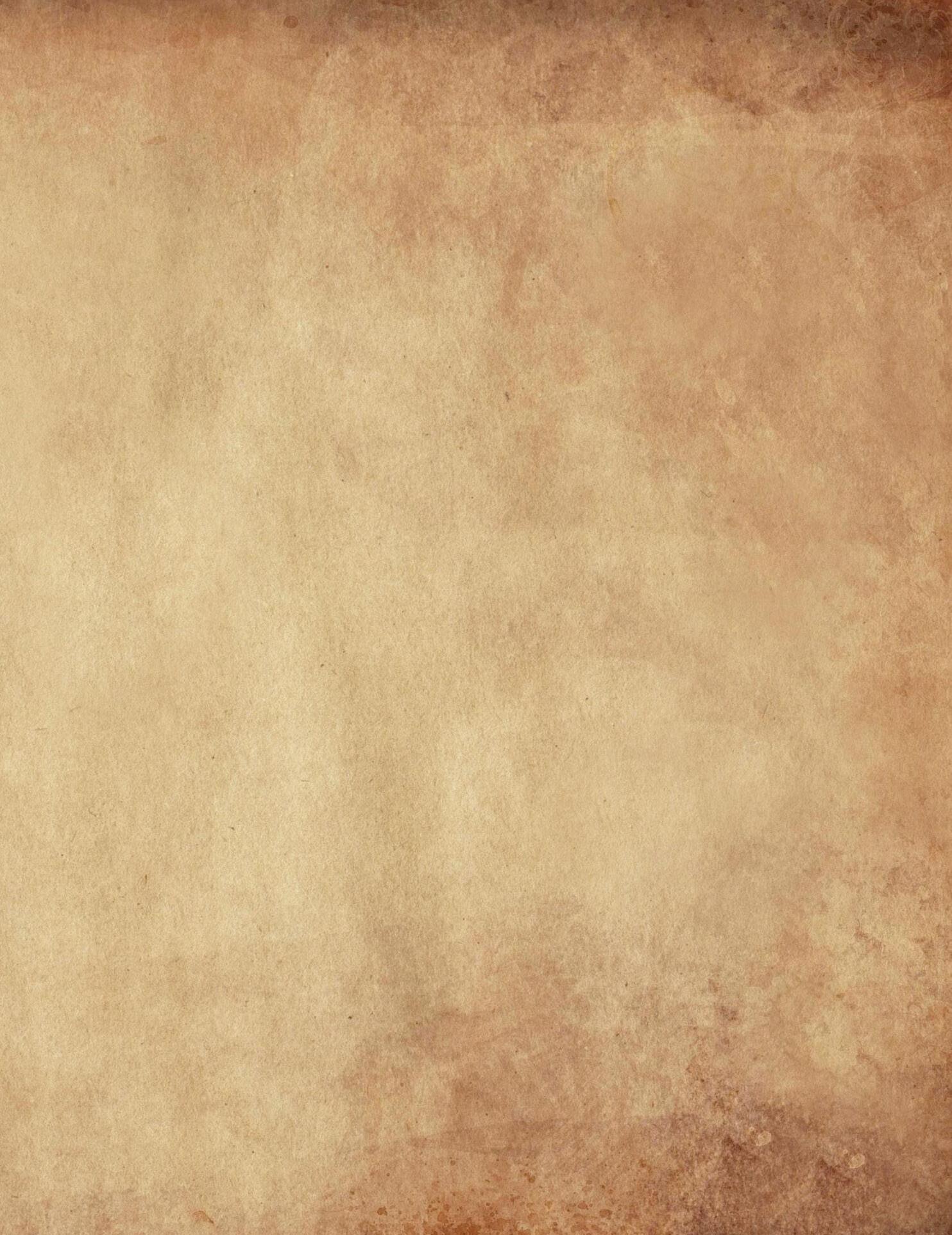
“Uh oh,” Markee said with eyes growing large. “Ranay must be coming back, I feel myself changing.” Markee became surrounded by what looked like little sparkles. “Please, please, let me stay with you and Al!, “he pleaded and with a pop turned back into his dog form.
“Of course, you can and will stay with us,” I said to the medium size mottled gray dog standing next to me. Markee woofed once and gave his tail a wag.
We were all exhausted. After a long time, I convinced myself it was safe for us to sleep because Ranay was, probably, still pretty weak. We all cuddled up on the bed and had a short but welcome deep rest.
We knew now we would have little time to prepare for Ranay’s next move. She knew I knew her dog boy had abandoned her for me, and Al had turned out to be more than she bargained for too. She had to be angry and determined. We also knew the sooner we moved the more we could capitalize on what damage we had caused her. I would have to save my confusion over being a witch, (Really, a witch?!) for later.
A few days later we were as ready as we felt we had time to be. Al and I had worked out a rudimentary means of communicating, composed mostly of me showing him info I’d found and him hissing or purring to indicate yes or no. There were also the few scratches given when my stupidity became just too much for him.
Markee became our lookout. He had established his sentry position at the front storm door and took it very seriously. More than one delivery person had the wits scared out of them by Markee’s enthusiastic defense. Al and I agreed he was doing a fine job especially for one so young.
Ranay did make it hard for us. We had to stay within the boundaries of our house to stay safe. Sometimes we would see her pacing the street opposite our house like a caged animal. The only reason Markee and I didn’t freak out about it was because Al seemed so calm. In retrospect I’d say Al had been faking a bit.
Searches for information had to be done via the internet. On occasion Ranay would interfere with that or send us fake info. Al always knew when some bit of fact was suspect. It must have had some kind of magical glimmer when he looked at it. When the signal was down Al and I would work in the yard and gather ingredients. We also had potion construction practice. Additional smacks by Al were plentiful as I tried to put ingredients together in the right way at the right time and at the right temperature. If we made it through the Ranay thing my first spell after would be one to help Al and I communicate without scratches.
We waited too long, of course. Monday morning, we woke to a gray rainy day. Water washed down the window in mesmerizing rivulets. We were all gathered at the dining room table trying to check for flaws in our proposed assault to defeat Ranay. We wanted to get her close to the magical boundaries of the house. We hoped the wards would protect us from at least some of the harm Ranay’s spells would cause.
I think Al noticed it first. There was a gradually growing sense of unease. The air seemed to be thickening to the point of making breathing difficult. I moved toward the back door and was about to open it when I was hit by two flying balls of fur. Al and Markee had knocked me to the floor. As I lay flattened they, as one, turned to look out the door’s window. I followed their gaze and saw Ranay floating not two feet away from the bottom of the deck steps.
This was bad, so very very bad. How had she passed the boundary? And how had she gotten so far into the yard without us noticing. I watched as the plants on either side of the steps started to wilt, then turn brown and then fall away into ash. Ranay was surrounded by a sickly aura of canned pea green punctured with veins of writhing black. A triumphant grin hung upon her face. It was a whisper, but we all heard it so clearly, “Come out and play.”
I felt pain in my arm. Al had bitten me. Thank God, as it had broken my thoughtless shock. I ran to the kitchen where the potions and tools we had put together were waiting. I gathered them up and shoved them into my pockets.

Trying so hard to remember, as I did so, the order they were supposed to be in. Markee and Al were growling at the door. Ranay had not advanced. Were the wards closer to the house stronger? I dared to hope but did notice that more of my beloved gardens were beginning to wilt.
Markee, Al and I were as ready as time would allow. I stepped to the door and this time I went out first to meet Ranay. Markee and Al took their place, one on either side of me. Ranay laughed and said, “What a motley crew you are. You can’t defeat me this time. I’m older, wiser and far more powerful than even the three of you combined.” Saying this, with a negligent wave of her hand she threw us all off the deck and into the shrubs.
It was a painful landing but worth it as landing in the shrubs gave us a little cover and time to regroup. As planned we separated. Al started to slink under the porch towards Ranay at the steps. Markee used the cover of the shrubs to move to the left. My way was less clear as I could not move forward with the porch and railing blocking me. I reached into a pocket and withdrew a vial and threw it at Ranay. It hit her squarely in the chest and exploded covering her with a gummy ichor. I had enough time to clamber over the railing and onto the deck.
Immediately upon landing I was hit with another magical blow that threw me into the side of the house. Al and Markee both chose that time to attack Ranay from either side. They were more successful than I had been but when she recovered she dealt them both painful blows. I saw my friends lying on the deck. Markee looked dazed and Al, much worse, had a terrible gash on his side. He struggled to rise but it was too much and he sank back. Ranay began to laugh, “Easier than I expected,” she cackled.
She floated toward me and I made a gesture. A gesture I had never made before but one that felt almost more natural to me than breathing. Ranay began to sink toward the earth. The closer she came to the earth the stronger I felt. Once again I felt the power gathering in my chest and I stood. Ranay made a cutting gesture towards me, and I felt searing pain. But the power was rising now fully from the earth, filling me with strength. Now I stood before her upright and outraged at the harm she had caused to my friends. I reached deep into my pocket and brought forth a little bound bundle of herbs, flowers and one tiny twig. I held them prayerfully in the palm of my hand and blew gently across them towards Ranay. A pale gold and spring green mist floated towards her. She laughed and began to raise her hands to create her own sigil but the mist by then had gently started to curl around her fingers. With shock she tried to move and found her hands trapped. She tried to speak a curse, but the mist had reached her lips and silenced her. The mist became darker green, purple curls began to move through it and the golden glow became brighter. The more she struggled the stronger the mist became, enveloping her and wrapping around her throat, trapping her arms and legs.
The moment she touched the ground there was very little to be seen of her. The mist had created a cocoon around her, and though she struggled she could not break free. At that moment I hesitated. Immediately her arm broke free and with cunning swiftness she grabbed Markee by his throat. Her other arm broke free and in that hand was a knife. At the beginning of the arc of a killing blow my resolve returned. The mist gathered her again, the knife fell, Markee fell to the ground. I finished her. It was not enough to encase her, as had been the intent. I had felt her hatred of all that was growing and good through the connection of the mist. In the end no mercy could be given, I let the mist destroy her.
In the end the mist had rendered Ranay into the smallest and most innocent of particles that returned her to the earth. There was work that had to be done in the gardens to repair the damage her toxic presence had brought but we did it.

Our physical injuries we could take care of. Al took longer to recover because of the severity of his wounds. Markee had a very sore throat and we all had multiple bruises, cuts and probably slight concussions.
Markee returned to his boy form as soon as Ranay’s ashes were disbursed but still could not remember his past. We had lost a dog companion but, as far as the neighborhood was concerned, we had gained a nephew. No one in the neighborhood had seen him that one day when Ranay used him as bait, which was one of the few strokes of luck we had had.
It was hard for him to adapt for a while, and still is a bit. He still can’t remember his pre-Ranay life but all in all, he’s happy. And he either had magic in his before-life or some of it rubbed off on him when he was with Ranay. The boy is developing skills.
As for me, meeting my very dark side has changed me in ways I am still discovering. Al, Markee and I hold each other up most days but it’s sometimes quite rough.
For a while no one noticed that Ranay was gone. When it was clear that her house was abandoned there was an investigation, but since there were no signs of violence the police gradually gave it up as a mystery. Some people in the neighborhood accused me of having something to do with her disappearance but my friends squashed those rumors. Funny how when the rumors were false nothing could be done and now, when they were true, people didn’t believe them.
We decided to move. Al and I eventually fixed the communication thing though he still scratches on occasion. We agreed that I had probably left a trail of magic behind me wherever I went. A trail that would lead other, possibly bad, witches right to us. I studied how to cover my tracks and we figured out a safer place for us to live.
I’m still not used to this, but I have Al and Markee to think of, and that helps. We have so much to learn, and we all feel an urgency to learn as quickly as we can. None of us wants to be caught unawares again if we can help it.
I know I can never contact any of my old friends no matter how much I miss them. Though they do often receive little care packages to fit their needs. They were kind and, after all, no one can make the recipes like I can.

e cobwebs are strung, the pumpkins are glowing, and our contestants have crept out from the shadows—our annual Halloween Costume Contest is o cially underway! is year’s Halloween Costume Contest is packed with frightfully fun looks, from ghoulishly glamorous to bone-chillingly clever, and every entry is ready to win your vote. Now the power is in your hands, dare you cast yours?
Voting is open October 1 through Halloween night, October 31, with the winners announced online November 1 and featured in the December issue of e VOICE-TRIBUNE.
For those still perfecting their frightful attire, there’s time to join the fun—entries will be accepted through October 10.
Simply scan the QR code to explore the contestants, cast your vote, or submit your own entry.



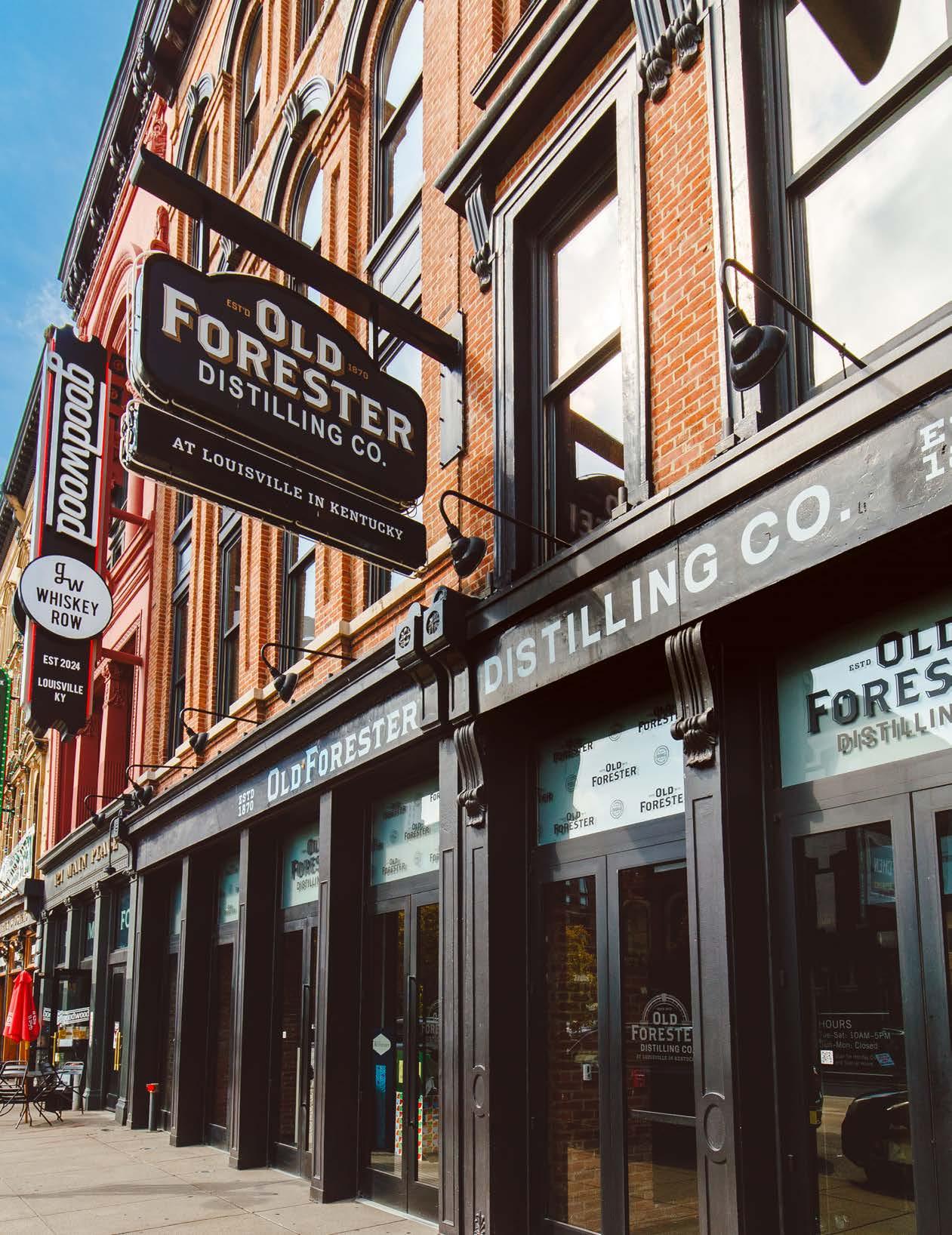
By Chris Morris • Photos By Matt Johnson
Why is downtown Louisville’s Main Street nicknamed “Whiskey Row”?
When I first conceptualized the Old Forester Whiskey Row Series, I was operating under the illusion that everybody would know what “Whiskey Row” was. Certainly, Bourbon drinkers would know. Certainly, Louisvillians would know. As I found out, that was not the case. I quickly learned that there was very little research or documentation on what we call “Whiskey Row.” I turned to the Kentucky Encyclopedia, to the Louisville Encyclopedia and found that neither of these great works even mentioned “Whiskey Row.” Further research revealed that there was virtually no information on “Whiskey Row” anywhere to be found. The bottom line was if I wanted to learn about the history of “Whiskey Row,” I would have to conduct the research myself.
How or why did I know about “Whiskey Row” in the first place? Growing up in Louisville as the son of two Brown-Forman employees (Dad joined the company in 1946 and Mom in 1952) I grew up with the book “Nothing Better In The Market” on the living room bookshelves. It was published in 1970 to celebrate Brown-Forman’s 100th anniversary and told the history of Old Forester and referenced its early presence on “Whiskey Row”. Many years later that fact inspired me to bring that story to life through the presentation of different expressions of Old Forester. Each to be based on a significant event that occurred while Old Forester was bottled on” Whiskey Row,” an event that had impacted how the brand was produced.
Using various industry publications such as the Wine and Spirits Bulletin of the 19th and early 20th centuries and Mida’s Criteria as well as other industry documents, I began to piece together the story of “Whiskey Row”. And what a fascinating one it was and is again. Louisville was established in 1778, at the Falls of the Ohio because of its strategic location. The Ohio River, in its entire 981-mile length, had only one navigational barrier, the Falls. These were a major barrier to boats making their way down the Ohio, so it was inevitable that a town of some sort would rise at this location. Here most river traffic needed to stop, unload passengers and cargo, float unloaded over the Falls and then reload for the trip down river. It could be weeks or months before water levels allowed shipping to proceed. This required goods in transit, including barrels of bourbon, to be warehoused for safekeeping.
As a result of this practice a large number of whiskey trading houses were established in Louisville. These businesses, with their barrel warehouses, concentrated along Main Street in a district that came to be known as “Whiskey Row.” This was due to the fact that Main Street stretched along the southern bank of the Ohio and fronted the Louisville Wharf where boats were loaded and unloaded.
After the Civil War, the resurgent bourbon business saw the development of new trading houses in Louisville. These companies resumed the practice of buying whiskey in bulk from rural and city-based distillers and grouping them together for sale in bulk lots to wholesalers, jobbers, retailers, doctors, and pharmacists.
My research revealed that before the imposition of Prohibition in 1920 there were 89 different whiskey companies that had their headquarters along Main Street in downtown Louisville. I am convinced that Louisville was the headquarters of the domestic whiskey industry prior to Prohibition in the United States.
Now let us be clear. Despite what some may believe there were no distilleries located on Main Street in downtown. There were a few warehouses and bottling facilities, but mainly they were headquarters of distillery companies, such as Brown-Forman, J.T.S. Brown & Sons, Glenmore Distilleries and Bernheim Bros. In other words, it was the Wall Street of American whiskey.

So, as any real estate agent will tell you, location is so important, and “Whiskey Row” was in the right location for the Kentucky Bourbon industry to flourish and expand from the mid-19th century all the way up to Prohibition. And of those 89 firms only Brown-Forman is still there with its presence at 117 and 119 W. Main on famous “Whiskey Row”, in the very buildings it bottled Old Forester in from 1881 - 1919.
In 1870, George Garvin Brown, then a pharmaceutical salesman, provided significant innovation to the city and industry. Whiskey was an important medicine in those days and was sold as such to doctors and druggists. Brown often heard complaints from his clients about the unreliable quality of the whiskey that was then on the market. Whiskey was sold in bulk by the barrel, and after it left the distillery, there was no control over its quality. Unscrupulous vendors could increase their profits by cutting their whiskey stocks with water, turpentine, and other agents that destroyed the quality of the product, as well as the reputation of the distillery of origin. The complaints of doctors about the quality of medicinal whiskey convinced Brown that there was a need to bottle and guarantee quality bourbon.
Brown established a business at 322 W. Main Street to satisfy the market demand for a medicinal bourbon whiskey that had a consistent level of quality. This level of quality could only be reached by “batching” a number of bourbon barrels together. These barrels were chosen and combined by Brown based on their complimentary maturation profiles. In this manner, he could reproduce a consistent taste profile time after time. To protect the integrity of this taste profile, Brown was the first on “Whiskey Row” to offer his bourbon to the trade exclusively in glass bottles. He wrote his guarantee of quality on what would later become the label for his Old Forester brand. I brought this history to life with the 1870 Original Batch expression.
The 19th century ended with the passage of the federally mandated Bottled in Bond Act of 1897. This act required that bourbon designated for sale to the consumer be sold packaged in a sealed bottle. By this time Brown had moved his firm to larger quarters on “Whiskey Row” at 117 W. Main Street. This event is represented by the 1897 Bottled in Bond expression.
When the 20th century began Louisville, its distilling industry and Brown would face a number of threats including World War, the growing Prohibition movement and in the case of Brown-Forman, a disastrous fire.
On October 2, 1910, Brown-Forman’s office and bottling operation were heavily damaged by a fire. Until repairs could be completed a batch of Old Forester that had not yet been bottled was required to be re-barreled. This unique batch when finally bottled was called “Old Fine Whisky” by Brown’s son and successor, Owsley. This product is represented by the 1910 Old Fine Whisky expression.
Ten years later Prohibition would deal the bourbon industry a near death blow. During Prohibition (1920-1933), most distilleries were forced to close, many would never re-open their doors.
Brown-Forman, however, remained in business by operating under one of Kentucky’s six Federal licenses to bottle and sell existing stocks of whiskey for medicinal purposes. The 1920 Prohibition Style expression celebrates this fact.
In 1924, Brown-Forman acquired the G. Lee Redmond Company’s concentration warehouse in Louisville at 18th and Howard Streets. This had once been the site of the Lynndale and White Mills Distilleries. Brown-Forman moved its operations from “Whiskey Row” to the Redmond site in November of that year. This move ended the bourbon industry’s presence on “Whiskey Row” for nearly 100 years. But with the Kentucky Bourbon renaissance of the mid-2000’s things have changed.
Today the Bourbon industry is back on “Whiskey Row,” but this time with real working distilleries, tasting rooms, vibrant visitor experiences, history walking tours and more. “Whiskey Row” is as important to Louisville as it ever was!
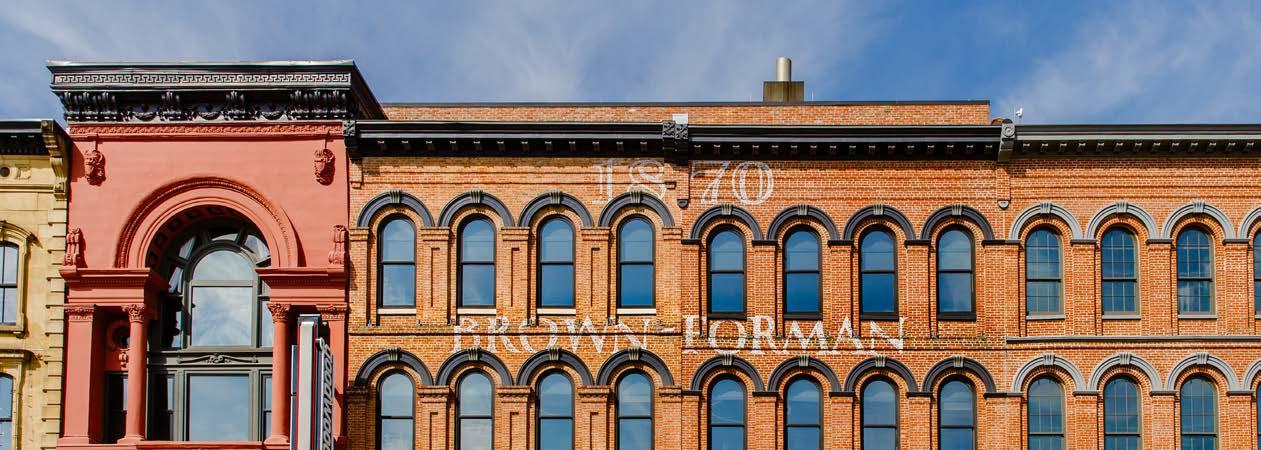




By Jackie Zykan
With over 20 years of experience in beverage alcohol, and a love affair with the natural world, I am delighted to share some of Kentucky’s finest pours alongside fresh, local, and seasonal botanicals.
September is bourbon heritage month, which can leave our palates craving something a little different once October rolls around. We can still pay tribute to the incredible plant that makes our bourbon so delicious (and no I am not talking about corn). Oak is the primary contributor of flavor in Kentucky bourbon, but is also revered as being a spiritual protector and wise elder of the plant world across many cultures. My love affair with this magnificent tree extends far past the cocktail, so much so my perfume brand (ODUOAK) is centered completely around its celebration. Oak is all around us, providing shelter for wildlife, ample shade, leaf compost for our soil, and during this season- acorns in droves. It is said the heavier the acorns drop in the fall, the harsher the upcoming winter will be. Such a quintessential example of nature in balance. Luckily, our recipe uses a very conservative amount of acorns in order to respectfully leave plenty for wildlife. The efforts to create the recipe though are much more involved. Fair warning, there are many steps to the acorn syrup preparation. Luckily, if spending a weekend preparing a syrup for a cocktail doesn’t sing to you, our featured Kentucky product is just as delicious without it.
Italian spirits have co-piloted many classic bourbon cocktails, so it makes perfect sense that in the epicenter of our native spirit someone would be inspired to make these ingredients closer to home. This nano-distillery located in the crux of Louisville’s Nulu and Phoenix Hill neighborhoods is a progressive example of Kentucky’s distilling scene. Prova offers a diverse selection of quality minded products which pay tribute to the founder’s family heritage. Much like many of our beloved bourbon brands, Prova seeks to honor the past by celebrating traditional processes in ways resonant with the present.
Featured Kentucky Flora: Quercus palustris (Pin Oak, Swamp Spanish Oak)
Yes. You can eat acorns. But there’s a catch. These little treasures require processing to strip them of their extremely high tannin content. These compounds act as a survival mechanism for the tree, providing protection from predators and disease. Even oak barrel staves see their share of tannin stripping before use in a process known as “seasoning” wherein stave wood is left to the elements to oxidize and leach out excess tannins. The result is a softer, sweeter profile in the aged spirit with less acidity and bite. This is an interesting consideration when choosing a whiskey. Though not the only factor that impacts “smoothness” of flavor, choosing a bourbon that was aged in staves seasoned for extended periods of time can be a useful compass when seeking a less aggressive pour. A cooperage well known for long seasoned staves is Zak (located in Larue County, KY), so if you are digging into the details of what goes into your pour, look for products matured in their barrels if it’s a smooth sip you crave.
It is important to note that any acorns from any type of oak will do for this recipe. While creating this piece, a nearby pin oak readily contributed an abundance of acorns, so this recipe primarily used fruit from that particular tree. I would advise to leave white oak acorns resting where they lie if you are collecting in forested areas. Due to harvesting pressures for its use in the whiskey barrel industry, I tend to leave these gorgeous specimens as undisturbed as possible. Personal preference.
and
• 2 oz Prova Amaro Castello • ¾ oz Acorn Syrup • 4 oz San Pellegrino Sparkling Mineral Water
Garnish Options: orange twist, apple slices, rose petals
Directions: Combine all ingredients in a tall ice filled glass. Garnish with as desired.
Non-Alcoholic Variation: The recipe can be made using 1.5 oz syrup + 4 oz sparkling mineral water. The syrup can also be used to sweeten tea, on pancakes or ice cream, anywhere you’d like to welcome a flavor twist.
As always, be mindful to clearly identify what you are foraging. Any acorns will do but be sure to use freshly ripened (light brown) acorns without holes, cracks, dark spots, or signs of decay/pests.
Ingredients:
• ¼ cup acorn nut meat (approximately 1.5 - 2 cups whole acorns) • 5 whole cardamom pods • Water, for repeated boiling and leaching acorn tannins • 1 cup fresh pressed apple juice • ¼ cup light brown sugar • ¼ cup sweetened condensed coconut milk
• ⅛ tsp rose water • ⅛ tsp salt
Directions: Crack open acorns and reserve yellow meat inside. Using a mortar and pestle, crack open cardamom pods. Combine both in a small pot with just enough water to cover. Bring to a boil, then strain liquid out. Repeat this process until the liquid no longer turns brown after heating. Spread the strained solids on a sheet of parchment paper and toast in a 200 F oven for 1 hour. Remove and allow to cool slightly. In a narrow tempered glass (I like to use a Pyrex measuring glass) add toasted solids and apple juice. Using an immersion blender, mix until acorn and cardamom particulate is about the appearance of coffee grounds. Pour the mixture through a fine mesh strainer. Congrats! You’ve just made an apple-acorn “milk”! But wait, there’s more! In a saucepan combine liquid with brown sugar and sweetened condensed milk. Bring to a boil, reduce heat, and allow to simmer for 15 minutes, stirring frequently. Remove from heat, add rose water and salt, then pour the mixture into a heat-safe glass. Place in the freezer for about 20 minutes. Once the top layer solidifies, crack a hole in the surface and pour the lower layer of liquid syrup into a separate vessel. I suggest straining this through a very fine mesh to remove any small fatty solids.
Admittedly, this is the most labor intensive syrup I have ever featured in this article. The result is a complex and delicious multipurpose syrup, and each step is necessary to make sure the bitterness of the tannins is tamed. Repeat boiling and straining is effective for this, and the use of a fat wash with the sweetened condensed coconut milk as well as the addition of salt act as an insurance policy to really tone the acid down.
When foraging wild plants always be completely certain of identification and follow the rule of “when in doubt, don’t”. Only take what is needed, leaving plenty for our native pollinators and fauna. Avoid harvesting from areas which are exposed to pesticides or other chemical applications. The statements in this article are for entertainment purposes only and are not meant to diagnose, treat, or medically advise. Please drink responsibly, you are loved by many.




By VOICE-TRIBUNE • Photos By Dan Dry
In this thoughtfully designed home, Crystal Smith of Bittners demonstrates her gift for blending elegance with livable comfort. From the very beginning, the most rewarding part of the project was the collaboration; working closely with the client to translate their personal style into a space that feels authentically their own.
The interiors unfold in a palette of moody blue-gray walls, which set a refined backdrop that is both intimate and restful. Neutral textiles in charcoal, gray, and soft off-white fabrics on bedding and upholstery keep the rooms cohesive and serene, while warm wood tones in the bed frame, furniture legs, and side tables add depth and contrast. Layered throughout are rugs from Anabel’s, grounding each space with texture and warmth.
Furnishings from Baker (including the sofa, swivel chairs, and a striking marble table) anchor the living areas, while the primary bedroom features a neutral Phillip Jeffries grasscloth wallcovering, a Baker bed, chair, and bench, and a custom Bittners console. A commissioned artwork of the client’s mother adds a personal touch, turning the room into a sanctuary that balances sophistication with heart.
Crystal’s approach showcases not only her skillful use of color, texture, and form, but also her dedication to creating interiors that resonate with the lives of the people who inhabit them.
For more information, visit: bittners.com







By VOICE-TRIBUNE • Photos From Pexels.com
As the leaves turn, our homes too naturally shift with the season, and Fall 2025 is all about warmth, personality, and subtle luxury. This year, the trends invite us to embrace cozy sophistication, layering texture and color in ways that feel intentional, not overdone. Whether it’s your living room you’re looking to refresh or a full seasonal reset, here’s what’s making spaces feel extraordinary this fall.
Sustainable Décor
Fall 2025 champions thoughtful, environmentally conscious design. Reclaimed wood furniture, upcycled accents, and décor crafted from natural or recycled materials are gaining center stage. Sustainability doesn’t mean compromising on style; in fact, these pieces often add unique character and a story to your home, blending design with purpose. The Earth is home to us all, after all.
Rich, Earthy Hues
This fall, color palettes take inspiration from nature’s own transitions. Deep amber, terracotta, forest green, and burnt sienna are everywhere, paired with soft neutrals that allow each shade to shine. These tones bring depth and warmth to interiors, creating inviting spaces that feel both grounded and elevated. Accent pieces like a velvety pillow, a ceramic vase, or an oversized throw can transform a room into a seasonal sanctuary.
Textured
It’s all about touchable, layered textures. Think woven blankets, boucle armchairs, natural jute rugs, and tactile wallpapers. Layering materials like wood, wool, stone, and metals adds dimension and personality to a room. This season, comfort is chic; spaces are designed to be lived in, lingered in, and adored.
Statement Lighting
As the days shorten, lighting becomes both functional and dramatic. Sculptural lamps, warm-toned pendants, and candle arrangements create an ambiance that’s cozy and stylish. This fall, lighting is a focal point, highlighting textures, colors, and curated décor.
Bringing the outdoors inside is trending in a big way. Branches, dried florals, gourds, and subtle autumnal arrangements add seasonal charm without overwhelming a space. Even a single arrangement on a coffee table or mantle can evoke the feeling of the season, pairing perfectly with the richer fall color palette.
Curated
Fall invites us to slow down, and homes are reflecting that. Reading nooks, window seats, and intimate lounges are curated with comfort and style in mind. Plush throws, soft lighting, and a carefully chosen stack of books make these spots irresistible. It’s about creating spaces that encourage pause and reflection.
Mixing
2025 fall interiors celebrate character. Vintage finds, family heirlooms, or pieces with a story are layered alongside contemporary décor, creating a collected, timeless aesthetic. This season, individuality and personality trump cookie-cutter design; your home should tell your story.


By Alisha Proffitt • Photos Provided
When I met with Teresa Starr just one week after her mastectomy, she looked every bit like a Disney princess sitting on her front porch, hummingbirds visiting her as if to offer their own blessings. It was humbling to witness her carry so much grief and grace at once, and even more humbling that she was willing to speak so openly about an experience so raw and personal.
Teresa was recently diagnosed with ductal carcinoma, stage one breast cancer. This is not her first battle with cancer. Ten years ago, she survived cervical cancer. These two diagnoses are unrelated, and she is not genetically predisposed to the disease. Still, a second fight is undeniably heavy. Compared to her first surgery, she says, this experience feels more vulnerable. “Having a surgery like that, you don’t see it,” she explained. “This is external. And this is very, very visible to everyone who knows me. And it feels more personal. And it feels more out there, and it feels like something I can’t hide.”
Her decision to undergo a double mastectomy was not made lightly. “Knowing that I had breast cancer and I could have done the least, I could have had a lumpectomy, I could have started from there. But I chose a double mastectomy, because my tissue is so extremely dense that you cannot see through it at all. It could have been anywhere else, and even if they got it all the first time, it could have come back,” she said. “Don’t be afraid to do the hard thing to make sure you’re good in the long run.”
At the same time, Teresa is quick to point out that no two cancer journeys are the same. “I don’t judge anybody who can’t or won’t do that, for different reasons. And doctors will recommend different things. Everybody’s body is different, everybody’s cancer is different, they’ll find it at different stages, and it’s ok to do what your doctor recommends. Trust yourself and trust your doctors. And do what you need to do and don’t be afraid to do whatever it is you have to go through, because there are support networks out there, even if you feel like you don’t have a big one now, there’s one out there waiting for you.”
For Teresa, that network has included Louisville’s Gilda’s Club, where she has found comfort and community. “I would say everybody at Gilda’s feels like Gilda’s has been essential for them at some point,” she explained. “You don’t have to go every week. You don’t have to go to every event. You don’t have to go to the group sessions if group sessions are scary to you. You can go learn how to can vegetables or paint with somebody. They’ve really got something for everyone. Not every single thing is going to be for you. But find something and don’t isolate.”
Her wider circle has rallied around her as well. Friends filled her refrigerator with meals, and her community threw her a going-away party for her breasts, organized by Kimberly Thompson. “I have never known that many people to come out and support me for anything in my entire life,” Teresa said. “So that was great to see everyone out there and they really care.”
Even with all this love, she stresses the importance of balance. “The check-ins are nice. I will say it gets a bit much when it’s every day. But I understand that people worry. We don’t always know what we need. And sometimes it’s just space, and we need time to rest and heal. We get that everybody wants to be supportive, but we are going through a lot. Sometimes it’s hard, just feeling like you have to be strong for everybody else while they’re dealing with your diagnosis. Don’t be that person.”
She also speaks candidly about the anger that lingers long after a diagnosis. “Some of us have had cancer for ten years off and on, some of us have been battling it for ten years straight, some of us just got a diagnosis a couple months ago and a lot of us, regardless of what level you’re at, are still really f****** p***** off about it. It’s ok to still be mad about it. Because people are going to say that you should go through all these stages of grief and whatever, and then come to accept it. Not everybody does that. Not everybody does that at the same pace. And it’s ok to be really f****** p***** off about it. It’s ok to be mad. It’s ok to cry about it. But don’t let anybody make you feel like you should be at a certain stage of dealing with your cancer. It’s cancer. It’s your battle. Deal with it however the hell you want.
Throughout this journey, her partner Chris Williams has been her steady support. The two met eight years ago and have been together ever since. During her recovery, Chris even brought his smoker home from his restaurant, Four Pegs, so he could cook while staying close to her. “I can’t experience what she’s going through,” Chris admitted. “So the best thing I can do is just try to support. Anything that she needs, just be there for her, just keep reminding her that she’s beautiful.”
He also has plans to provide meals for Gilda’s Club members before their Tuesday night meetings, hoping to inspire other chefs and restaurants to join in. “I just want to say that the strength and grace that she’s shown through this whole process has been absolutely astounding,” Chris said. “She’s always been my rock, but just to see the strength that she’s had through this. And just to see the strength of those women at Gilda’s Club, the strength in this room of these women—I think that it is definitely underestimated, the strength that women have.”
Teresa also wants people to understand that her story is part of a bigger picture, one that includes not just breast cancer but Parkinson’s, chronic illnesses, and other diagnoses that are present in every community. “Our friends are involved in the Parkinson’s Foundation. She’s going through it, I’m going through it,” Teresa said. “These things happen in these circles everywhere and people are affected by multiple things. And we can bring awareness to each other’s causes and support each other. Drawing all the circles and seeing where we all intersect, and then bringing those people together who make it feel like no one is as alone as they feel like they are.”
Teresa is currently raising funds through a GoFundMe a friend started for her to cover medical bills and the income lost while she is unable to work. Any remaining funds, she says, will be donated to Gilda’s Club and to breast cancer research and community support.
Her story and the story of countless others is not only one of survival but of strength and solidarity. “We all might not have the same diagnosis, but we can all be there for each other,” she said.
You can contribute to her GoFundMe, and in doing so, help build the kind of community Teresa knows we are capable of, one where no one has to face their diagnosis alone.
QR Code: Fundraiser for Teresa Starr by Amanda Masters: Teresa’s Fight Against Cancer
For more information of the Gilda’s Club of Kentuckiana visit: gck.org
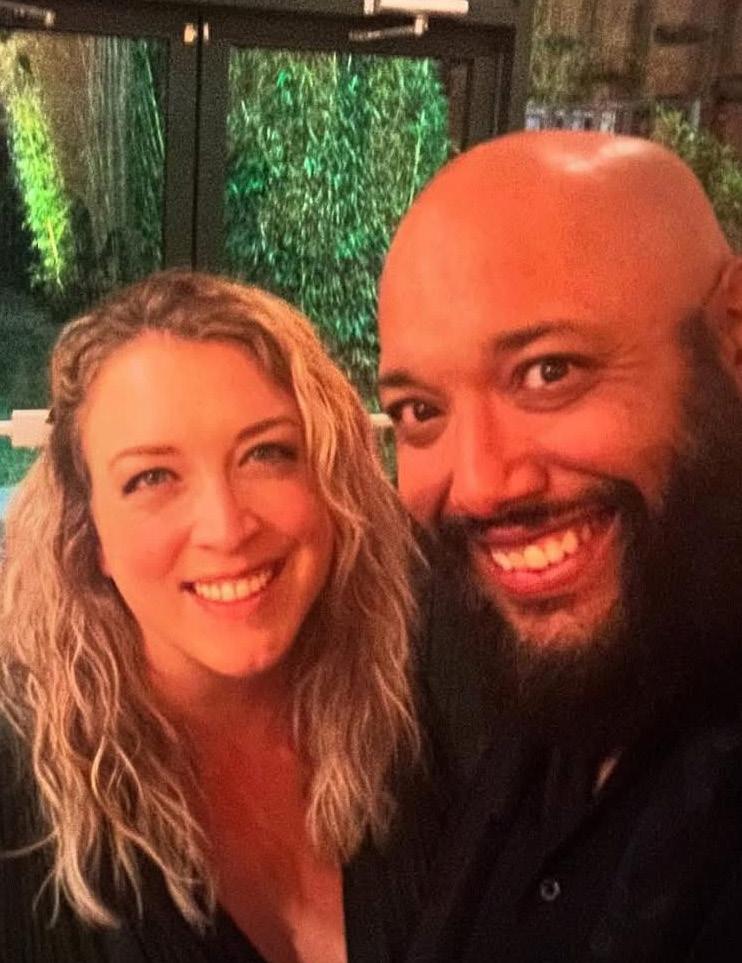

By: Alison Cardoza • Photograhs From pexels.com
Have you ever spent time in the grocery store struggling to comprehend food labels? Feeling completely overwhelmed? Naturally, you strive to make healthy choices for your family and yourself, but this process can be protracted, particularly when you are short on time.
The American Heart Association recommends that we consume no more than 2300 mg of sodium per day. An ideal limit is no more than 1500 mg per day. The Dietary Guidelines for Americans recommends limiting added sugars to no more than 10% total calories. For women, this means no more than 100 calories from added sugar daily (6 teaspoons). For men, no more than 150 calories from added sugars (9 teaspoons). The World Health Organization recommends reducing total fat intake to 30% of total energy intake to help prevent unhealthy weight gain. There are many sites and apps that help us make healthier choices and make it EASIER in your busy life. One app, in particular, that I have been using is the Yuka app. The Yuka app is a free mobile app that helps users access the health impact of food and cosmetic products by scanning the bar codes. It provides a rating from 0 to 100 for each product, based on nutritional additives, quality, etc. This information helps us make a more informed decision about these products before we purchase. This app accesses a product’s nutritional quality considering factors such as calories, salt, sugar, saturated fats, fiber, and protein. For example, if you scan your favorite cereal, Yuka uses a color coded scale to rank the product. It will list it as excellent (green), limited risk (yellow), moderate risk (orange), and bad (red). It will list if the sugar content is too sweet or just right. It will list if the calories are considered a bit too caloric or just right. It will list sodium content. (We should try and stay below 480 mg per meal, FYI). It will list the positives and negatives of a particular product. The app provides a healthier alternative so you have the option to make a healthier choice.
What are great snacks to eat before a gym workout?
A balanced pre-workout snack before a workout should consist of a combination of carbohydrates and protein for sustained muscle support and energy.
Examples of snacks prior to a workout-
• Banana with peanut butter
• Yogurt with berries
• Granola bar
• Eggs
Let your body rest 2-3 hours before hitting the gym if you have eaten a LARGE meal. No one wants to feel sick while working out! Eating a snack (listed above), wait 30-60 minutes before the start of your workout.
What should I eat after a workout?
To help your body recover, rebuild muscle, and replenish energy stores, consume protein 30-60 minutes after a workout for optimal muscle recovery.
Examples of snacks/meals after a workout-
• Turkey wrap
• Salmon with sweet potato
• Chocolate milk
• Smoothies
• Yogurt
• Cottage cheese
• Hummus dip and veggies
• Almond butter
Alison Cardoza, ACSM Certified Personal Trainer and Fitour Group Exercise Instructor at Baptist Health Milestone Wellness Center. B.S. Exercise Science and Sports Medicine with a minor in Health Promotions from the University of Louisville. Former UofL Ladybird and former NFL Colts Cheerleader.

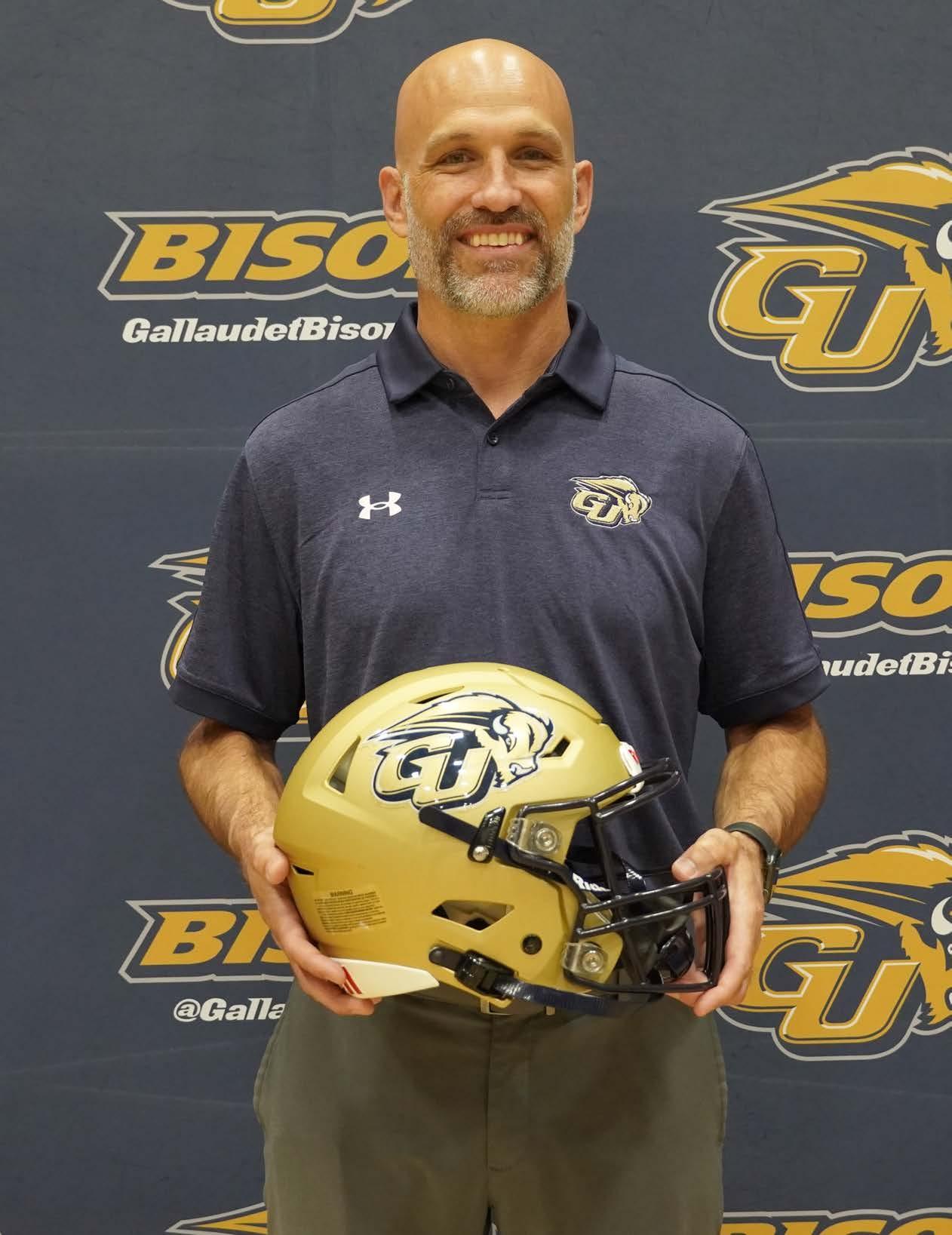
By RUSS BROWN • Photos Provided By UofL Athletics
It’s been quite a year for former University of Louisville quarterback Stefan LeFors, a fan favorite while playing for coach Bobby Petrino from 2000-2004.
In April LeFors, 43, landed his first football head coaching job at the college level when he was hired by Gallaudet University in Washington DC. Then in August, the ex-Christian Academy (CAL) coach learned he had been elected to the U of L Athletics Hall of Fame.
Gallaudet is a small, private university for deaf and hard-of-hearing students that was chartered in 1864 and is the only university in the world where every program and service is designed to serve deaf and hard-of-hearing students. Nicknamed “Home of the Huddle,” it’s the birthplace of American Sign Language and it’s where the football huddle was invented in 1894, used by deaf players to keep opponents from reading their signs. The Bison are an NCAA Division III school that plays in the Old Dominion Athletic Conference.
With his strong connection to Gallaudet, LeFors seems to have been destined for the job. He is the only hearing member of his immediate family, which has a history of deafness over three generations. LeFors’ father, mother and brother are deaf, as are his paternal grandparents. His dad, Larry, was born deaf. Stefan’s mother, Susan, and older brother, Eric, became deaf as a child after having mumps. (LeFors’ son, Luke, 18, and daughter, Ella, 16, aren’t hearing impaired).
Eric was a quarterback at Gallaudet (1996-99); Susan was on the volleyball team (1977-78); his uncle, Nick LeFors Jr., played men’s basketball and golf (1973-75); Nick’s wife Peggy, (‘76) was a member of the cheer squad and another uncle, David, attended the school (‘86-89).
“My ties to GU run deep with family members and being on campus as a kid watching my brother play football in the late 1990s,” LeFors said when he was hired. “It really makes this even more of a unique and special opportunity for me and my family.
“I grew up in the deaf world and I love football. I never imagined I’d be the coach at Gallaudet one day, but here I am. Wow! I heard about Gallaudet all the time growing up. Now I have the opportunity to live in both worlds at once. It’s a wonderful opportunity. As a CODA (Child of Deaf Adults) I think I can build strong connections with players.”
“I’m incredibly humbled and excited for this next chapter and grateful for the opportunity to grow, learn and take on new challenges,” he added. “My passion is developing young people and sharing the knowledge I’ve learned from all the wonderful places I’ve been both as a player and coach.”
Eye contact was vital in the LeFors household in Baton Rouge, La., and that might help explain his skill at reading defenses. “I learned to communicate with my eyes from a young age, learning to pick things up,” he said. “Maybe a guy from a normal hearing family wouldn’t pick it up.”
Petrino said he sought advice from LeFors when the coaching staff needed new hand signals or play names. He said his QB thought differently and saw the field differently.
“We are absolutely thrilled to welcome Coach Stefan LeFors to the Gallaudet family as our new head football coach,” Gallaudet athletic director Warren Keller said. “From the moment we began this search, we were looking for someone who could inspire our student-athletes, elevate our program, and lead with passion, integrity, and vision. Coach LeFors brings an incredible track record of success, a deep love for the game, and a clear commitment to developing young men both on and off the field. We’re confident he will make an immediate impact on our culture and carry on our proud tradition with energy and excellence.”
LeFors arrived at Gallaudet from Parkview Baptist School in Baton Rouge, La., where he had served as head football coach and physical education teacher since March 2019. LeFors guided Parkview to a 47-24 record and made six state playoff appearances where the Eagles compiled a 7-6 postseason record.
Prior to Parkview, from 2011-19, LeFors compiled an 86-20 record and won two Kentucky 2A State Championships (2016, ‘18) and seven district championships at CAL. In 2016, he was named AP Coach of the Year for Kentucky. In addition, he was named district coach of the year five times.
“I wouldn’t change my life for anything,” LeFors said in a 2003 ESPN interview. “I have a great family, great parents, grandparents, everybody. They just can’t hear. So we talk with our hands. It’s not a big deal to me.”
LeFors (2000-04) will be inducted into the U of L Athletics Hall of Fame in November, along with others. “I am so thankful for my coaches, teammates, support staff, Cardinal fans and especially my wife and family who have been a huge part of this journey. Thank you!” LeFors said in a release.
He helped bring the U of L football program onto the national stage by leading the Cardinals to 20 wins as a starter, which included a victory over No. 10 Boise State in the 2004 Liberty Bowl. A two-time first-team All-Conference USA quarterback, LeFors ranks eighth in school history in passing yards with 5,853 and is tied for eighth in touchdown passes with 38.
Known for his impeccable accuracy, LeFors stands second in the program with a completion percentage of 66.0 percent. As a senior in 2004, LeFors guided the Cards to an 11-1 record and a top 10 ranking in the final polls. In throwing for 2,596 yards and 20 touchdowns, he led the nation in completion percentage with a school record 73.5%, passing efficiency at 181.7 and passing yards per attempt at 10.1. LeFors was named the game’s Most Valuable Player after accounting for three touchdowns. He rushed 12 times for 76 yards for a touchdown and completed 18-of-26 passes for 193 yards and two touchdowns.
LeFors was drafted in the fourth round (121st overall) of the 2005 National Football League (NFL) Draft by the Carolina Panthers and stayed with the organization for two years. He signed with the Edmonton Eskimos of the Canadian Football League (CFL) from 2007-08 and played with the Winnipeg Blue Bombers for the 2009 season. He returned to Louisville in 2010 as an academic specialist prior to starting his coaching career.
In addition to LeFors, the Hall of Fame class includes Lola Arslanbekova, Volleyball (2009-2012); Candyce Bingham, Women’s Basketball (2007-2009); Nikki Boltja, Lacrosse (2011-2014); Joao De Lucca, Men’s Swimming (2011-2014); Adam Duvall, Baseball (2009-2010); Christine Exeter, Women’s Soccer (2010-2013); Peyton Siva, Men’s Basketball (2009-2013); Russ Smith, Men’s Basketball (2010-2014); and Alyssa Voelmle, Field Hockey (2011-2014).
The event will begin with a reception at 6 p.m., dinner at 7 p.m. and the induction ceremony to follow. Tickets are $75 per person, or $750 for a table of 10, and may be purchased online through “My Cardinal Account” at GoCards.com, specifically at this link: https://am.ticketmaster.com/uofl/buy/25hof.

By RUSS BROWN • Photos Provided By Louisville Athletics
Louisville’s football team predictably stormed through its lightweight non-conference schedule unscathed going into Atlantic Coast Conference play in late September, but where the Cardinals (3-0) stack up in the race for the Atlantic Coast Conference championship, or at least a spot in the title game in Charlotte a couple months from now is still a mystery?
When the season started the chase looked wide open, with as many as five teams, including U of L, considered to have a shot at the title, although Clemson was a solid choice to win the crown. But things have changed, and even though the regular season is only one-fourth of the way finished, it has become increasingly clear that the path to the championship will run through the Sunshine State.
Miami (3-0), ranked No. 2 nationally as of this writing, looks like the most complete team in the nation while Clemson (1-3) has not only dropped its first two ACC games, but is suffering through its worst start in the coach Dabo Swinney era and its worst overall in 21 years.
So where does that leave Louisville? Well, in about as good shape as the Cardinals could hope, especially considering their favorable ACC schedule. The Cards were picked to finish fifth in the league in the preseason poll behind Clemson, Miami, SMU and Georgia Tech.
The good news for coach Jeff Brohm’s team is that they don’t have to face No. 8 Florida State, which was selected seventh in the preseason poll, or No. 16 Georgia Tech, and it will play the Tigers at home on Nov. 14. So U of L’s fate could be determined by how it fares on its trip to Miami on Oct. 17 for a prime time game on ESPN.
There is always the worry, of course, that Clemson and quarterback Cade Klubnik, Preseason ACC Player of the Year, will have their act together by the time they arrive in Louisville in mid-October, or that the Cards will throw in a clunker as they did last season in losing to a terrible Stanford team with a title game slot still at stake.
U of L opened the league season at Pittsburgh and took on Virginia (Oct. 4) ahead of the trip to Miami. Then comes three straight games the Cards will be heavy favorites to win prior to Clemson’s visit, two of them at home -- Boston College, at Virginia Tech, and California. Other than Miami, which defeated them in L&N Stadium last year 52-45, the Cards’ biggest challenge appears to be SMU in Dallas on Nov. 22, the week before the season finale against Kentucky in L&N.
A darkhorse contender on Louisville’s schedule could be California (Nov. 8, L&N). Nobody expected much out of the Bears this season until quarterback Jaron-Keawe Sagapolutele started throwing the ball and showed they can be dangerous. Furthermore, it could be a so-called “trap game” for the Cards, coming the week before Clemson.
In regard to U of L’s status going into ACC play, few conclusions could be drawn because two of their non-conference opponents -- Eastern Kentucky and Bowling Green -- were severely outmanned. As for James Madison, U of L surprisingly struggled to a come-from-behind 28-24 victory, needing game-saving plays from wide receiver Caullin Lacy and running back Isaac Brown, in addition to a defensive score via a fumble recovery in the end zone.
Even Brohm wasn’t quite sure how his team would fare against much better competition.
“I like our team,” he said. “I think we have a good plan. We’ve shown some good signs and we’ve shown some signs we need to improve, and it’s still yet to be determined. Playing good competition will determine where we’re at.
“We know we’ll be much more tested against teams we will face from here on out. We’ll see where exactly we shape up. Every year is different. Sometimes you have some good early competition where you see where you’re at and kind of make adjustments, which is what I like. Other times you breeze into it, so to speak, with the level of competition and now you go into conference play where it’s always going to be a battle unless you play lights out.”
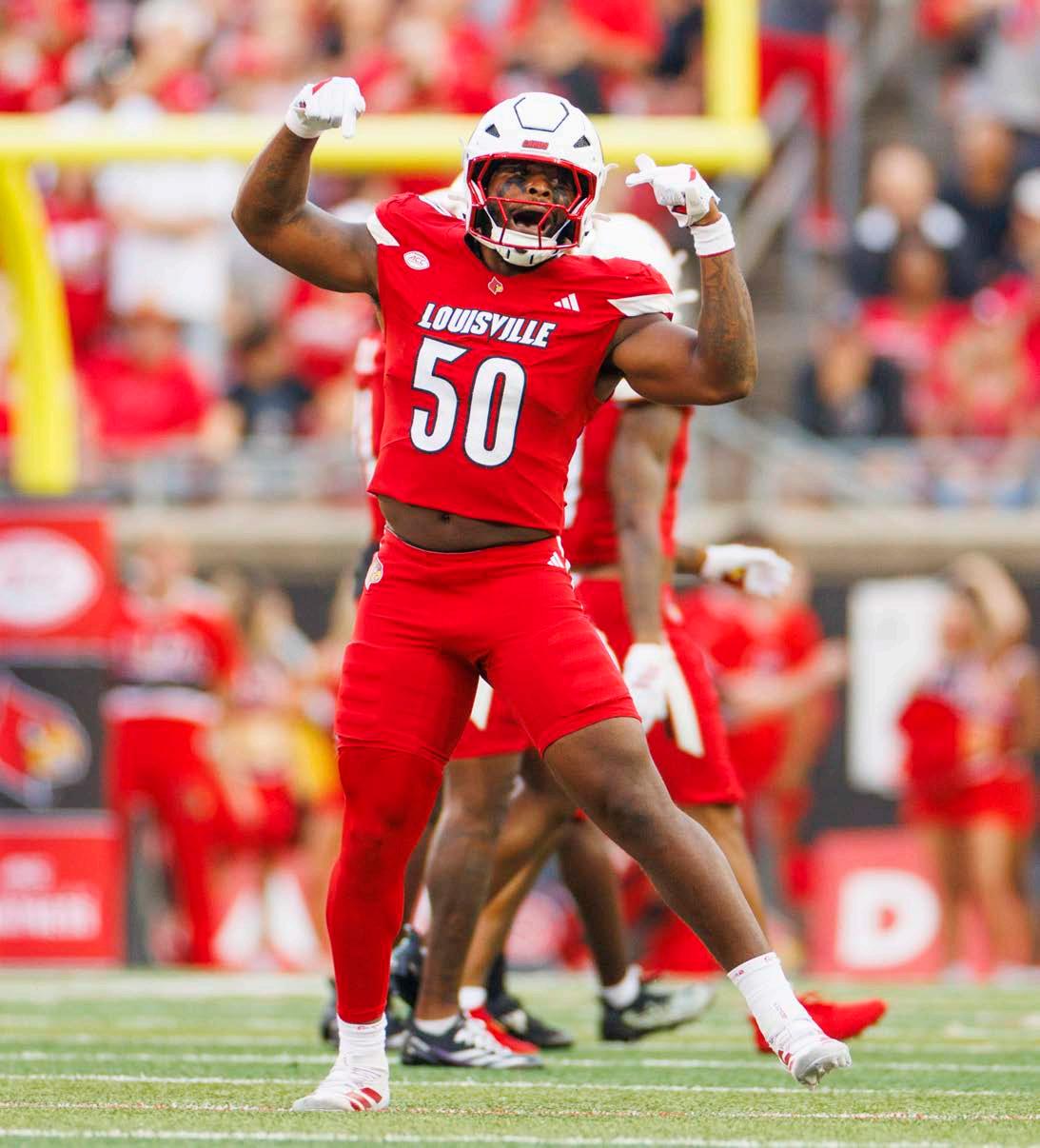
Through those three games, U of L’s strength was its defense and special teams play. Going into league play, the lingering questions revolved around the offense, in particular its offensive line which was outplayed by JMU’s more physical defensive line and gave up three sacks and six quarterback hurries against Bowling Green.
Meanwhile, redshirt senior Caullin Lacy has become an emerging star. Lacy is Mr. Everything for the Cards, and if he keeps it up he will be a strong candidate for ACC Player of the Year. Against Bowling Green he had 281 all-purpose yards, including a 75-yard punt return for a touchdown.
“Whether it’s the slot, the outside, the backfield, the return game -- all four spots, we need to utilize him,” Brohm said.
With a few other exceptions, such as wide receiver Chris Bell, running back Isaac Brown and defensive end Clev Lubin, the jury is still out regarding the Cards’ potential.

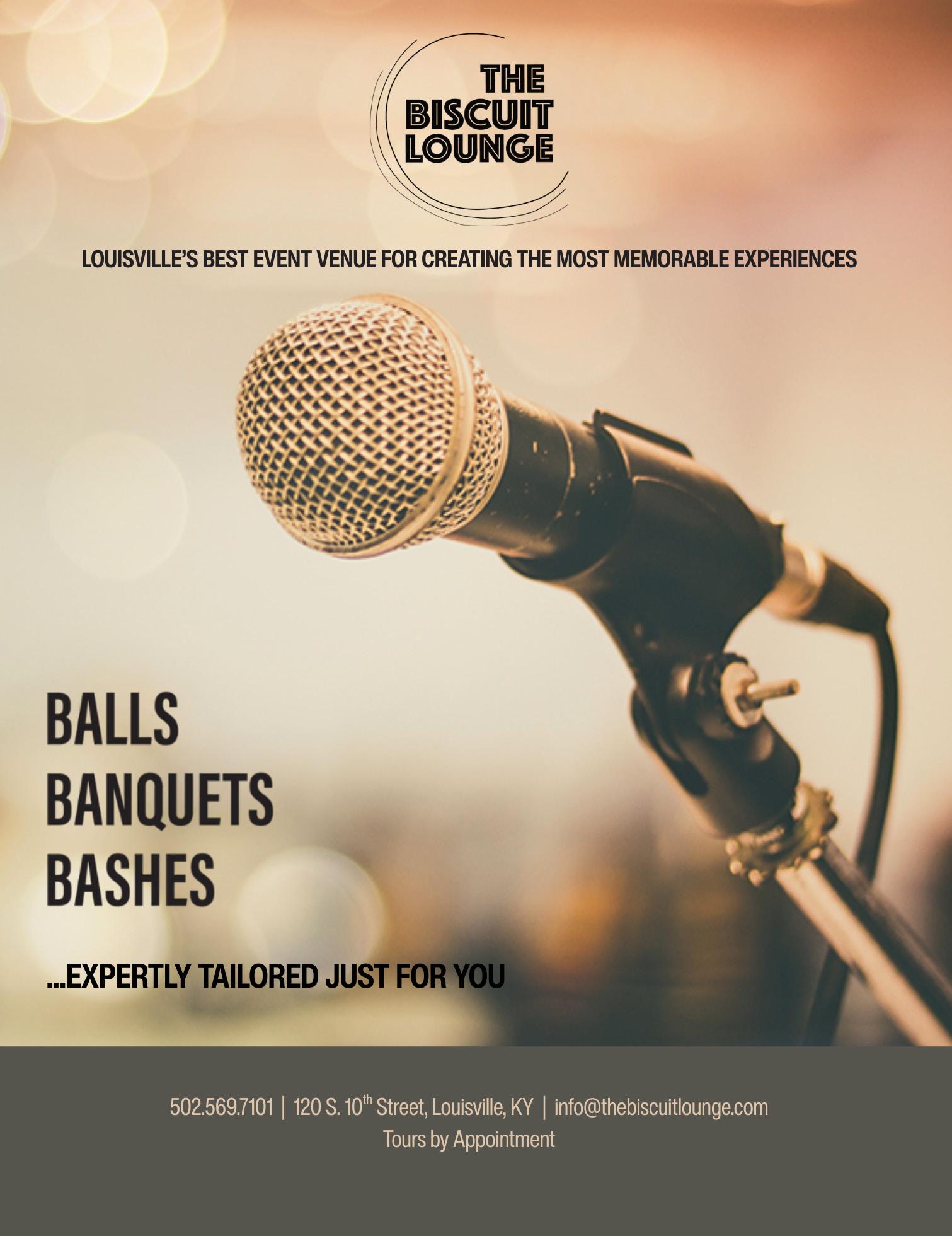

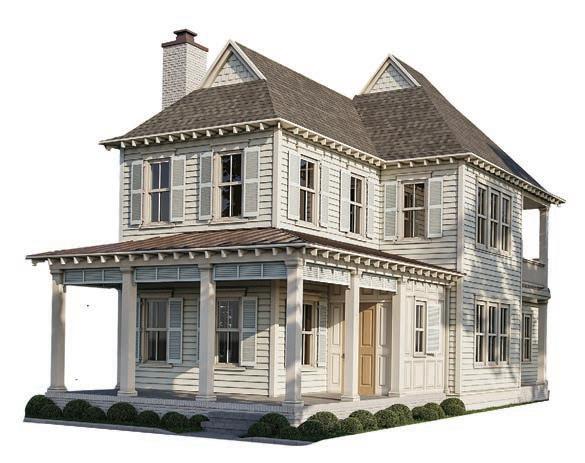















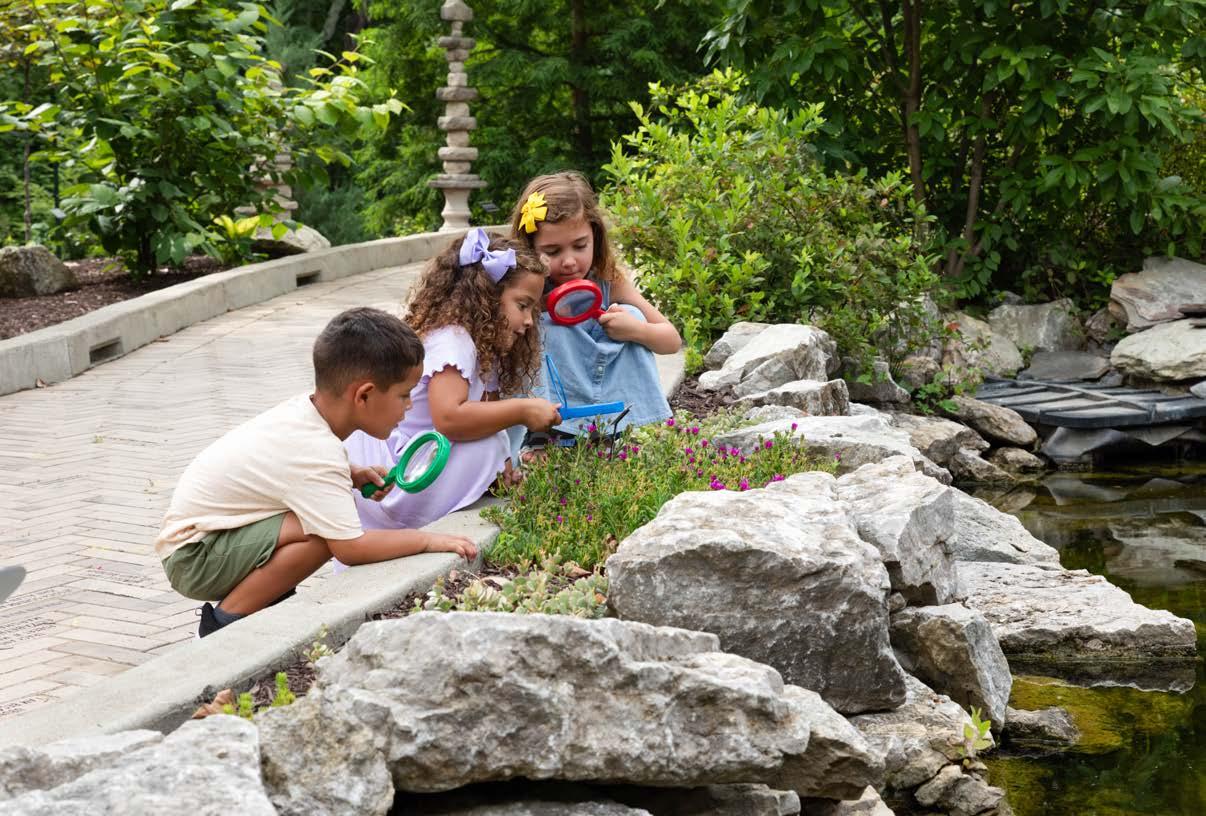




By VOICE-TRIBUNE • Photos By Lindsey Franklin
Ellie Abbick and Nick Pemberton were married at The Gillespie, where family and friends gathered to celebrate the occasion. The downtown venue provided a grand setting for the couple’s special day.
The bride wore a gown from Rebecca’s Wedding Boutique. Her hair and makeup were styled by The Fenley Studio, completing her look for the ceremony.
Kingsley’s Meats and Catering provided the menu, while guests enjoyed a cake from The Whisk House. Flowers were designed by Charissa’s Floral Design, adding color and detail throughout the event.
Music was provided by JD Entertainment, with coordination by Chelsey of CNB Weddings. The wedding was photographed by Lindsey Franklin at Studio Llotus, who captured the highlights of the day. The VOICE-TRIBUNE congratulates Ellie and Nick Pemberton and wishes them a lifetime of happiness together.


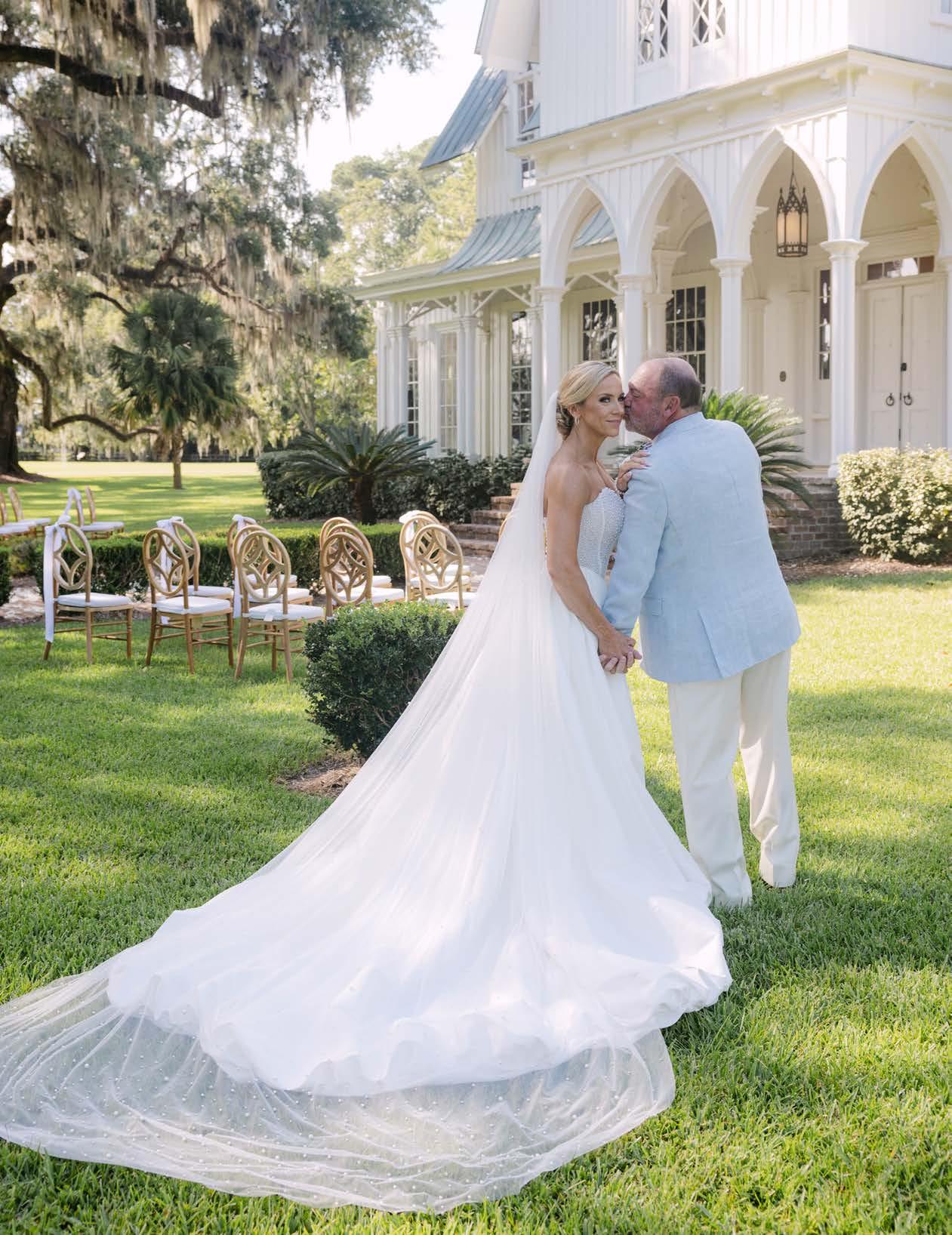
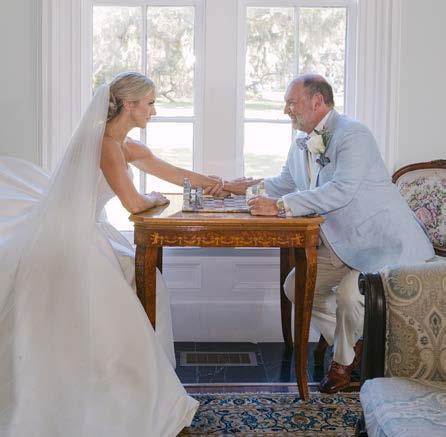
By VOICE-TRIBUNE • Photos By Lisa Staff
Louisville sweethearts Diane Werle and Brian Patton celebrated their wedding in timeless Lowcountry style at The Mansion at Rose Hill in Bluffton, South Carolina. Their love story began in the fall of 2023, when Brian first spotted Diane across a Louisville pool at a housewarming party. Though he boldly told his best man, Ned, “I’m going to marry that woman,” courage didn’t strike until later, when he tracked her down through friends and Facebook. A first date at 7 a.m. over coffee sealed their fate, and from that morning forward, the pair became inseparable.
Brian’s proposal was straight out of a classic film—literally. After watching Diane’s favorite, An Affair to Remember, he braved his fear of heights to ask for her hand at the top of the Empire State Building on Christmas. The moment was complete with New York winds, stubborn tickets, and a spontaneous, joy-filled response from Diane that left no doubt of her answer.
The couple’s Southern celebration reflected their personal style and hands-on planning. Diane took the reins as planner, crafting details down to ribbon-tied chairs and rehearsal dinner florals. Her bouquet honored her grandmother, while Brian and his groomsmen were dressed in custom suits tailored by Crittenden Rawlings. Even the couple’s beloved dog had a role in the festivities. Guests enjoyed a ceremony framed by sweeping oak trees and Spanish moss, followed by a reception at the Sea Pines Ocean Lounge featuring seafood towers, surf and turf, and dancing under the stars.
Family and friends surrounded the couple, with Diane’s sister Lisa Klein as Matron of Honor and Savannah Paige Patton, daughter of the groom, as bridesmaid. Brian’s Best Man was Ned Bass, alongside groomsman and cousin Jeffrey Slusher. From the Hilton Head Symphony Trio to confections by Carrie Castano, every vendor added to the elegant, personal tone of the day. With laughter, family ties, and Lowcountry charm, the wedding of Diane Werle and Brian Patton was a celebration to remember.
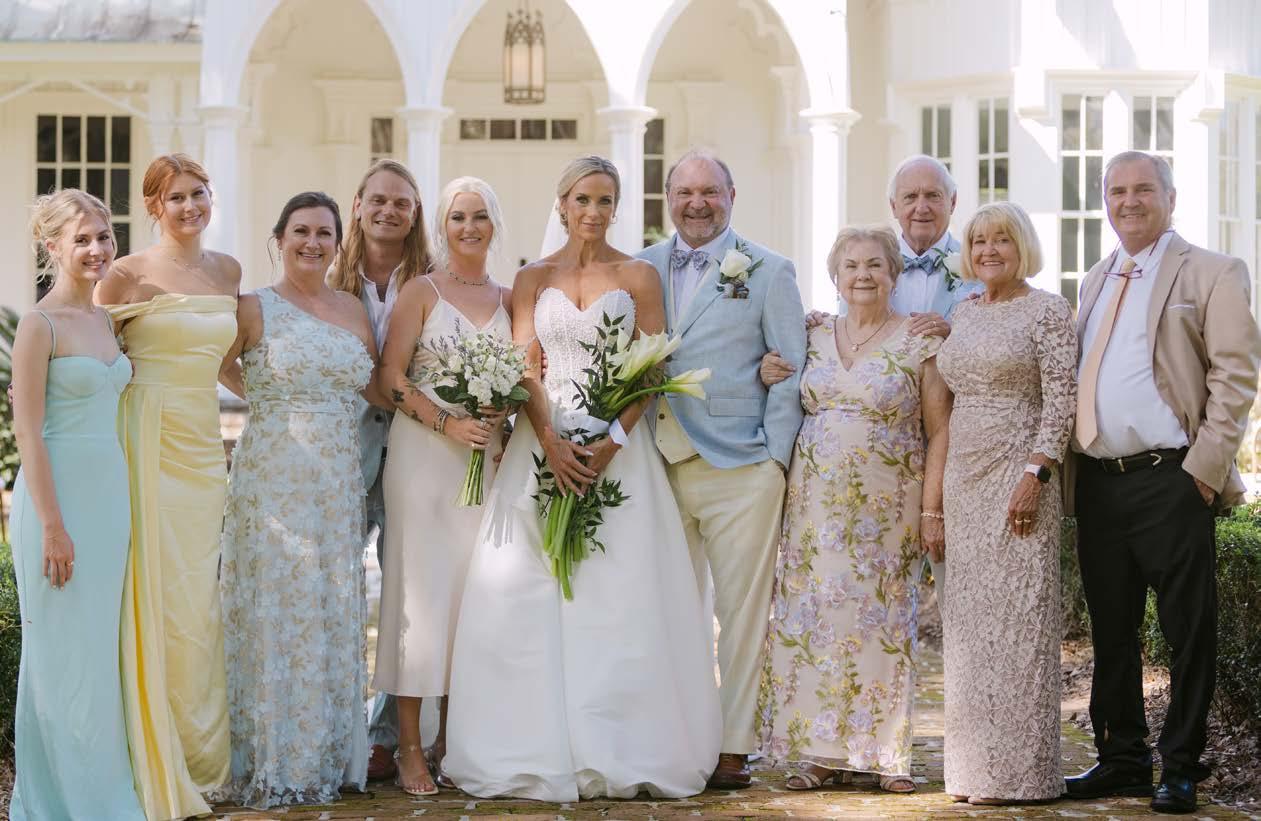


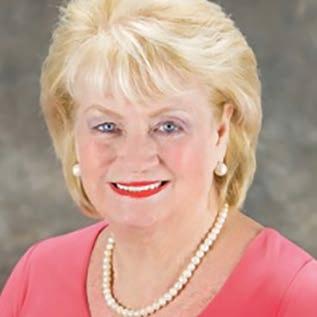
Paula
It is with deep sorrow that I acknowledge the passing of Jefferson County Clerk Bobbie Holsclaw, who left us on Wednesday, September 10th. Bobbie dedicated 27 years of her life to serving the people of Jefferson County, and she did so with unmatched excellence.
I had the privilege of working for Bobbie for eight of those years as her director of public relations and spokesperson, and that time was nothing short of transformative. She was a conscientious, caring, and compassionate public servant whose leadership style inspired everyone around her. Bobbie’s legacy is one of dedication and a relentless commitment to service.
As Clerk, she oversaw the operation of the Jefferson County Clerk’s Office and the administration of county-wide elections with a steady hand and an unwavering sense of duty. True to the Clerk’s Office motto of providing VIP service, Bobbie ensured that every resident of Jefferson County was treated with value, integrity, and performance.
She was a model of what it means to be a faithful public servant, and her presence will be profoundly missed. Louisville Metro has lost not only a remarkable Clerk but also an extraordinary leader whose work and memory will live on in the countless lives she touched.
My heartfelt condolences go out to her family, loved ones, and County Clerk employees during this time of loss. May they find comfort in knowing that Bobbie’s impact on this community will never be forgotten.









By Kathryn Harrington
It’s finally my favorite time of year. The leaves are crunchy, the air is crispy, and I’m currently re-watching all seasons of Gilmore Girls for about the 7th time. As the leaves turn from green to gorgeous shades of red, and pumpkin spice sneaks into every coffee cup, Louisville dives headfirst into October with a calendar packed tighter than a Halloween costume closet.
First stop, the St. James Court Art Fair. I know, I’ve talked about it before, but I can’t help myself. This legendary event turns the iconic streets of Old Louisville into a sprawling open-air gallery, filled with handcrafted goods, jewelry, paintings, and enough inspiration to make your current gallery wall collection jealous. Whether you’re hunting for that perfect piece or just strolling with a caramel apple in hand, it’s one of Louisville’s best events for art appreciation, and you definitely don’t want to miss it.
For the nature and animal lovers, the Kentucky Bat Festival is bat-tastic (hold your groans, please). This festival features critters, educational displays, and is very fittingly held at Louisville Slugger Stadium, home of the Louisville Bats! Kids and adults can learn about these fascinating creatures while enjoying a silent auction, arts and crafts vendors, children’s crafts, and a free mini bat to each attendee!
As the nights grow longer, everyone’s inner October enthusiast awakens at the Jack-O’-Lantern Spectacular. Imagine a nighttime walk through a magical, illuminated forest, with hundreds of intricately carved pumpkins showcasing everything from spooky sculptures to whimsical scenes. You never know what you might find! Over the years, I’ve spotted everything from characters from classic Disney movies and South Park to our Governor Andy Beshear and even pumpkins dedicated to the Hatfields and McCoys. It’s a luminous celebration of fall’s most iconic symbol. Plus, it’s a lot less scary than Halloween movies if you’re more of a pumpkin lover than a horror fan.
And for the culinary connoisseurs, the Louisville Black Chef Showcase is a must. Celebrating the vibrant flavors, rich traditions, and innovative talent within Louisville’s Black culinary community, this event is a feast for both your eyes and your taste buds. It’s an inspiring showcase of culture, cooking, and community, and a true taste of Louisville’s diverse and delicious soul.
So, if you’re ready to cozy up with art, adventure, and a little Halloween magic, October in Louisville has you covered.

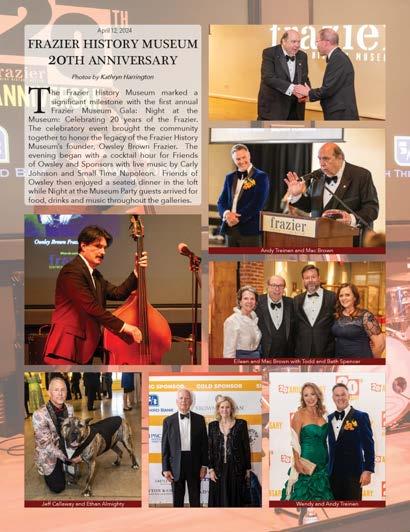





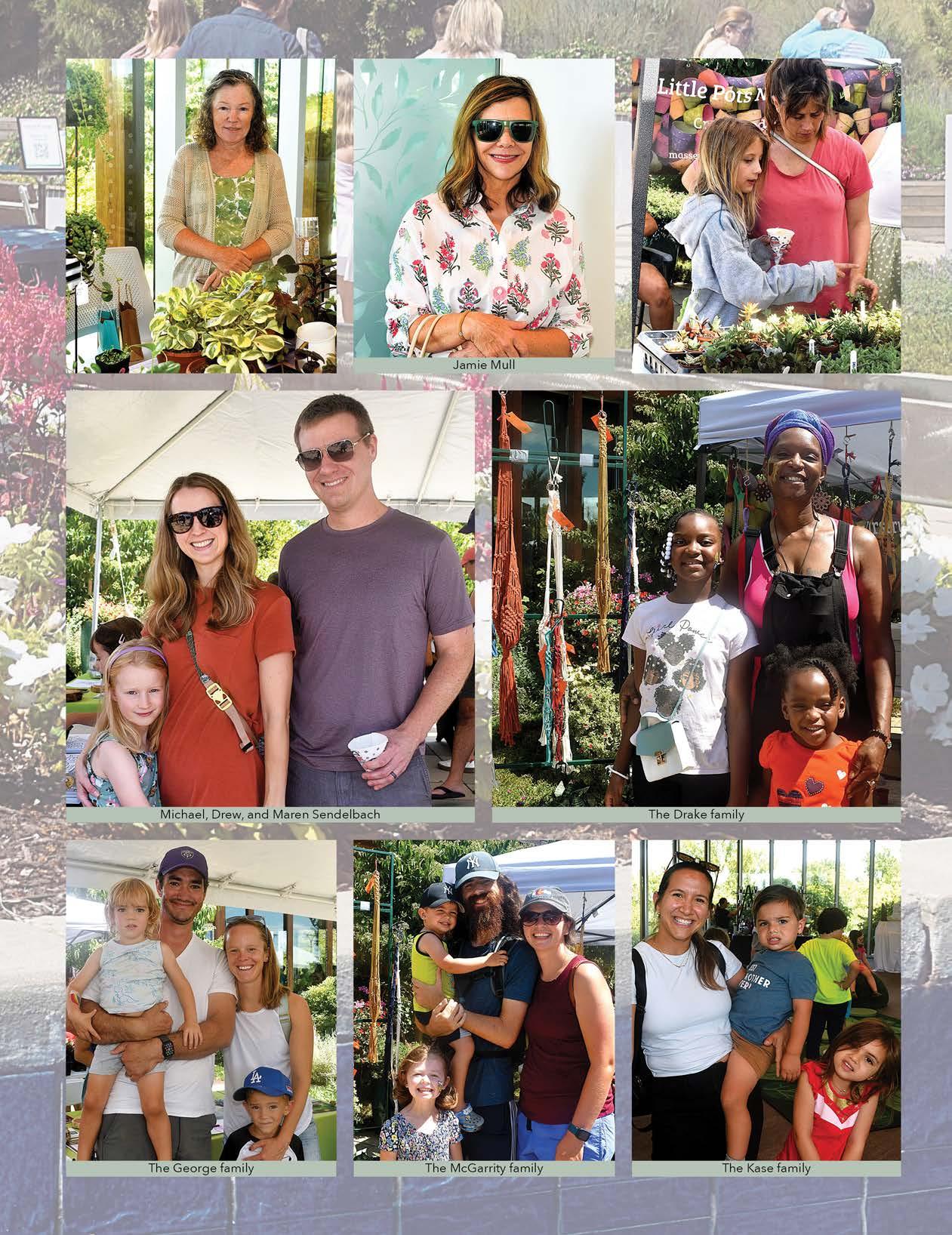



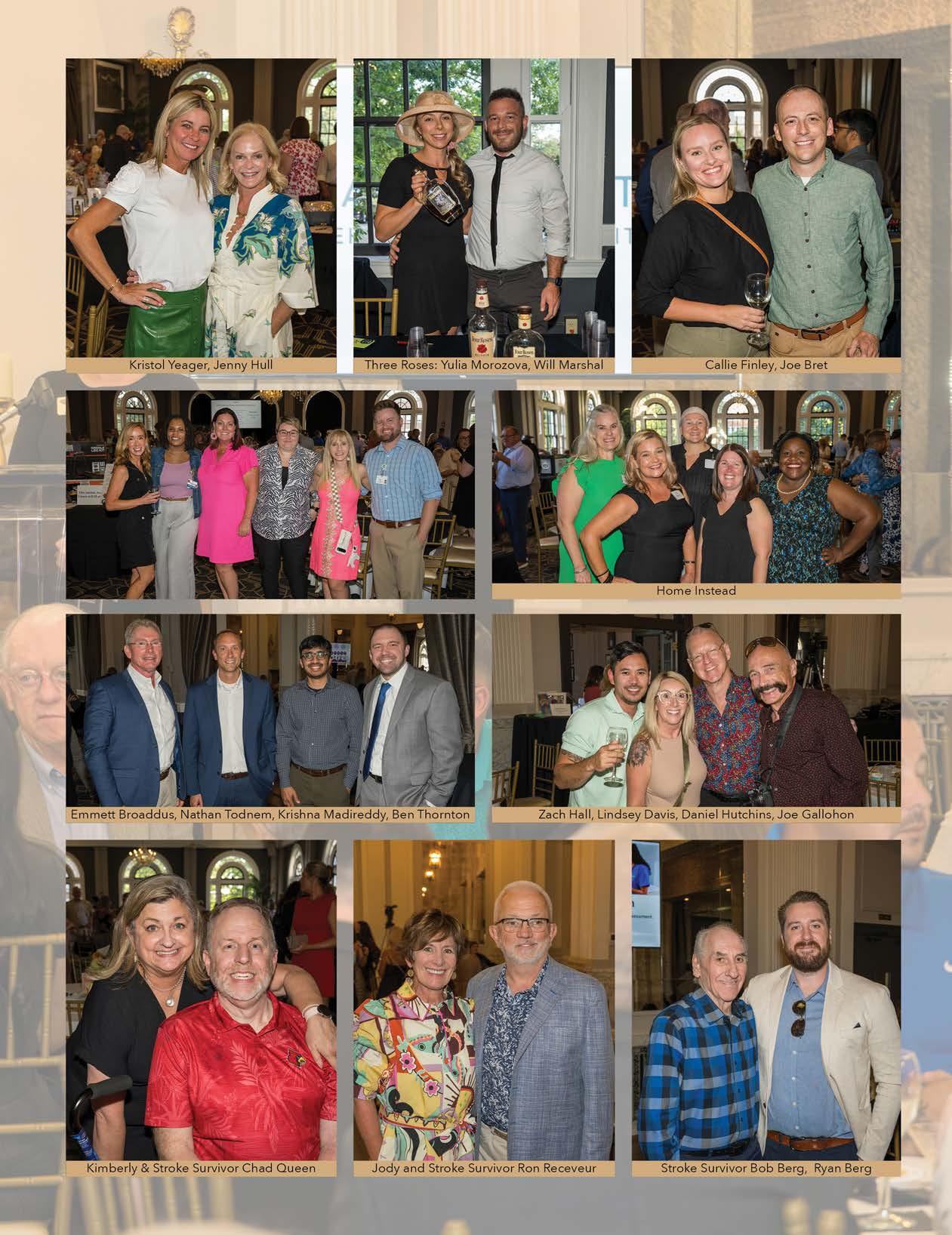





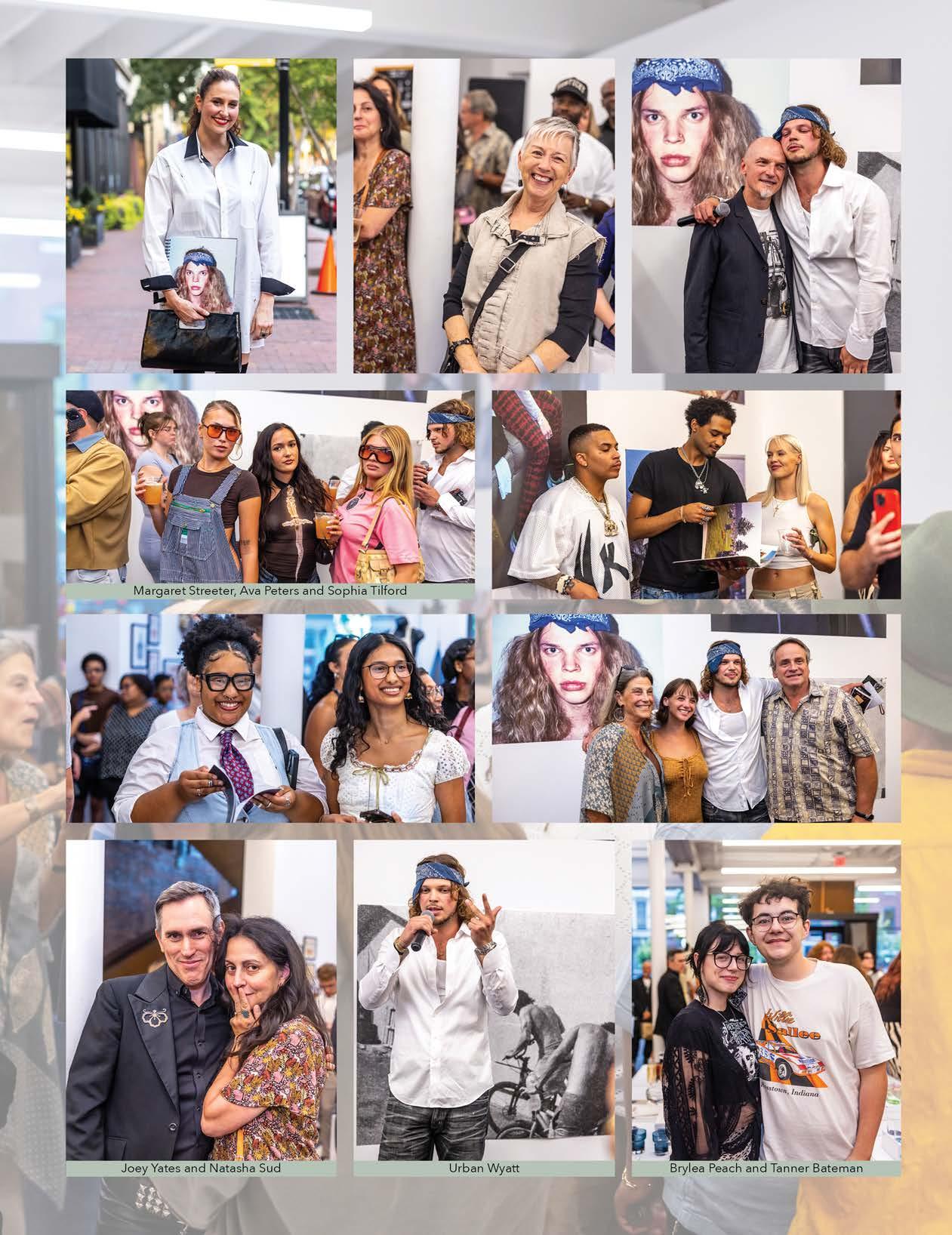

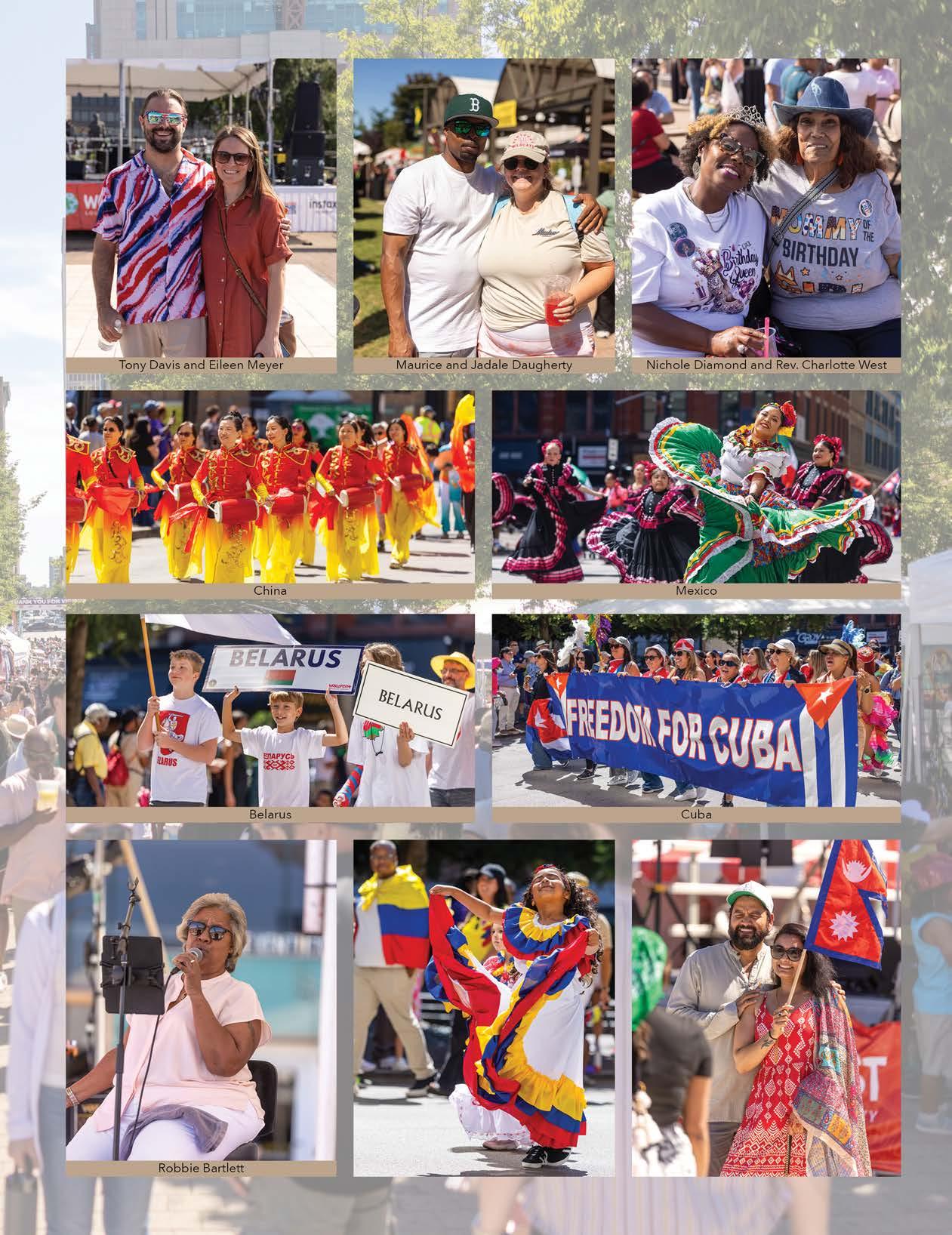
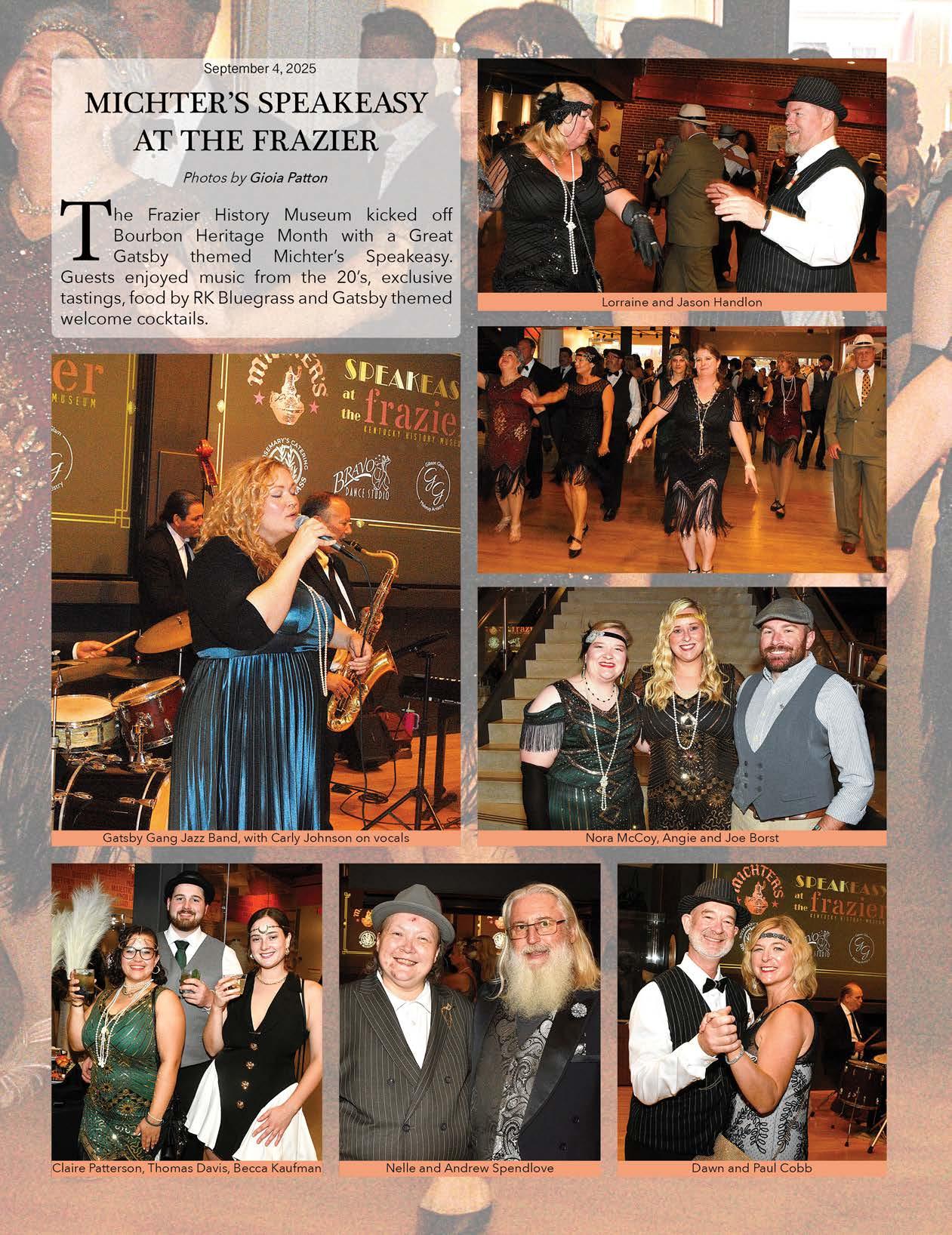

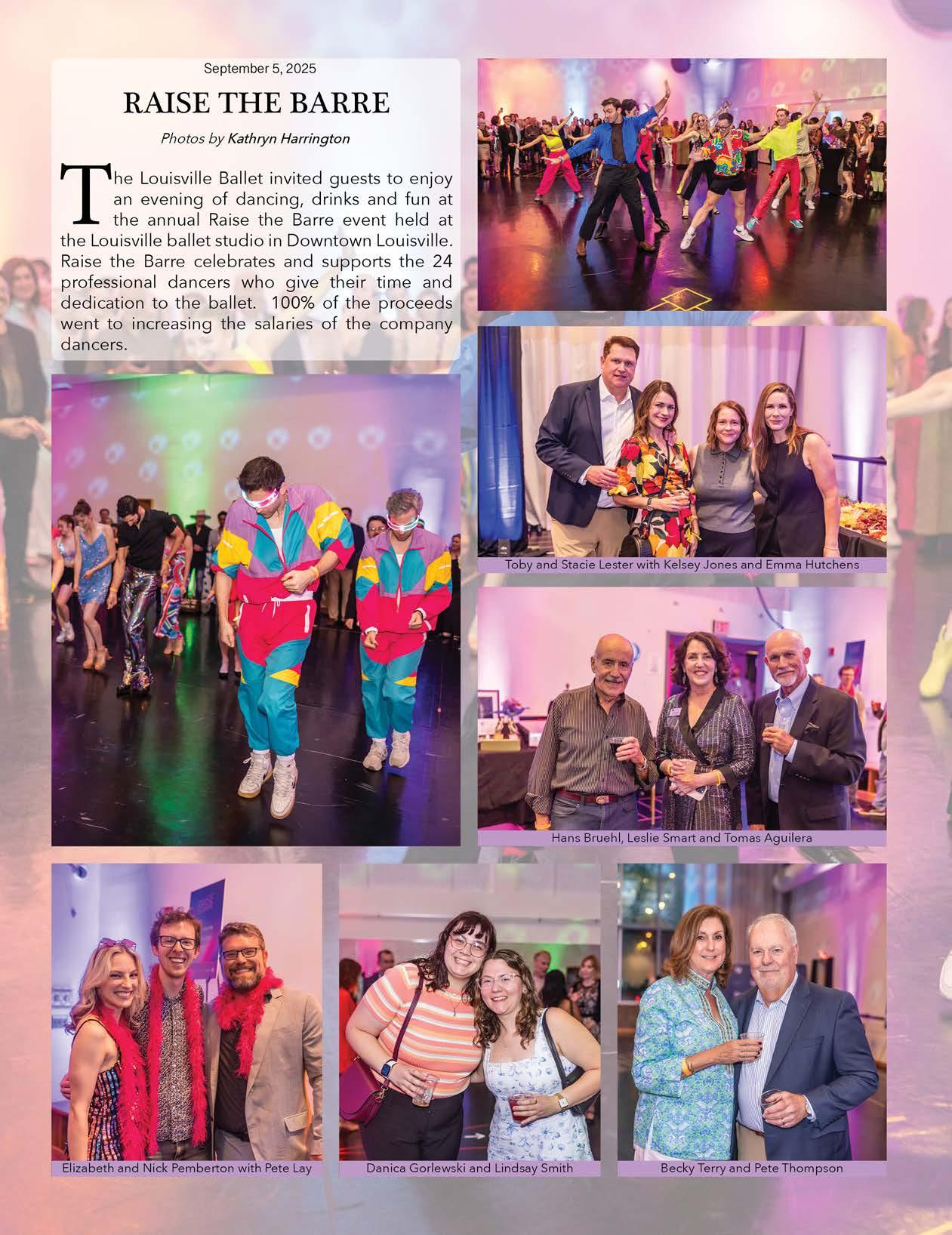



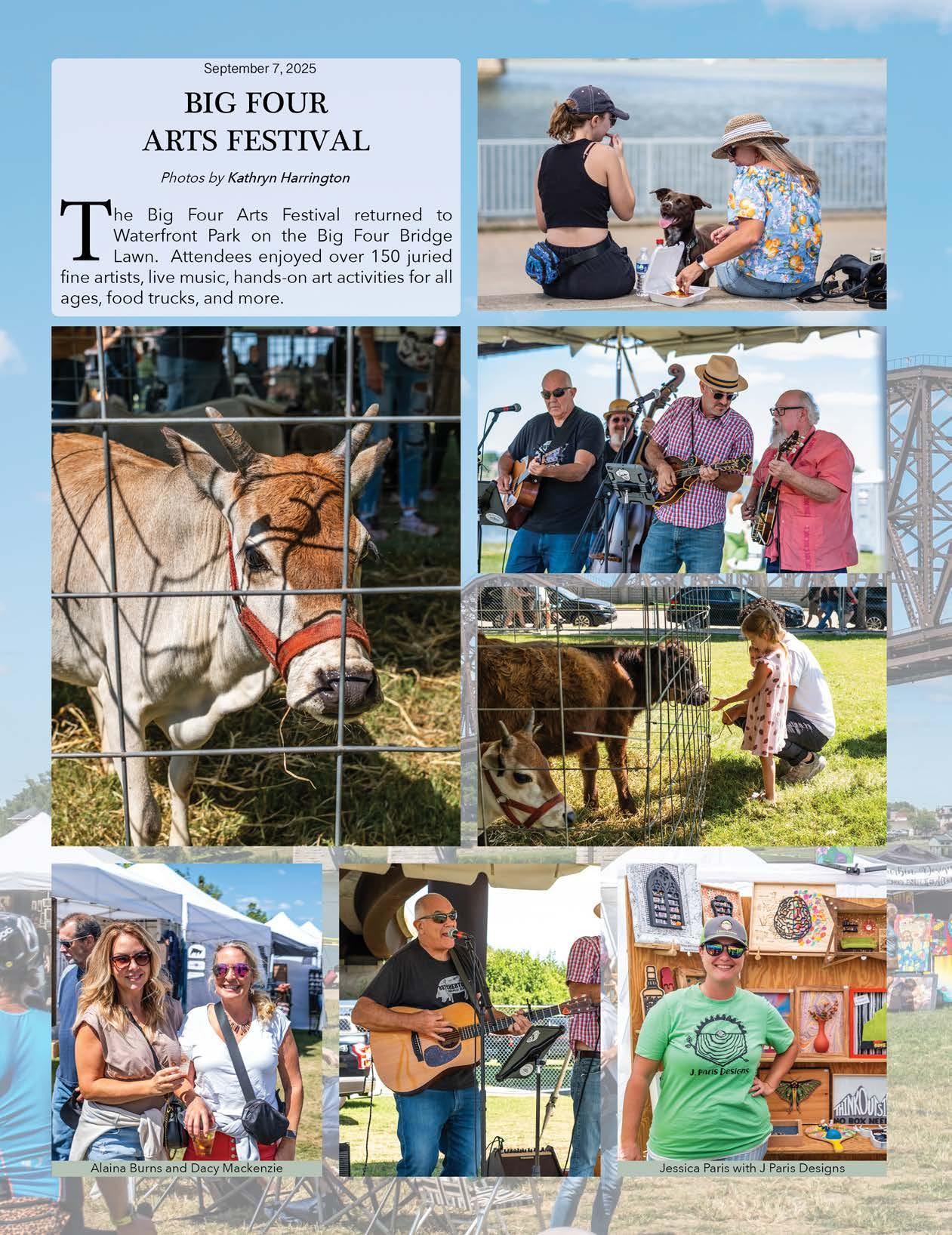
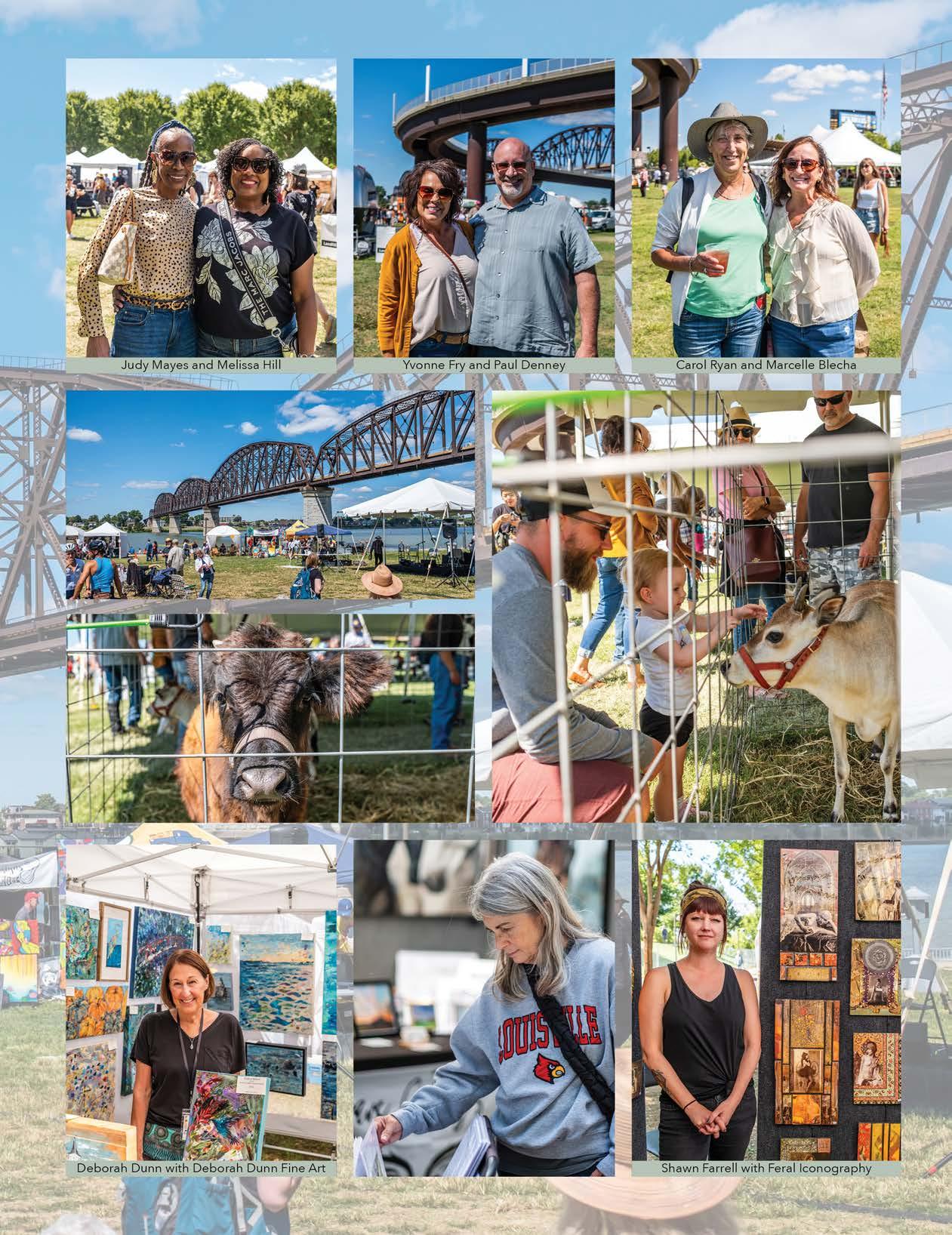





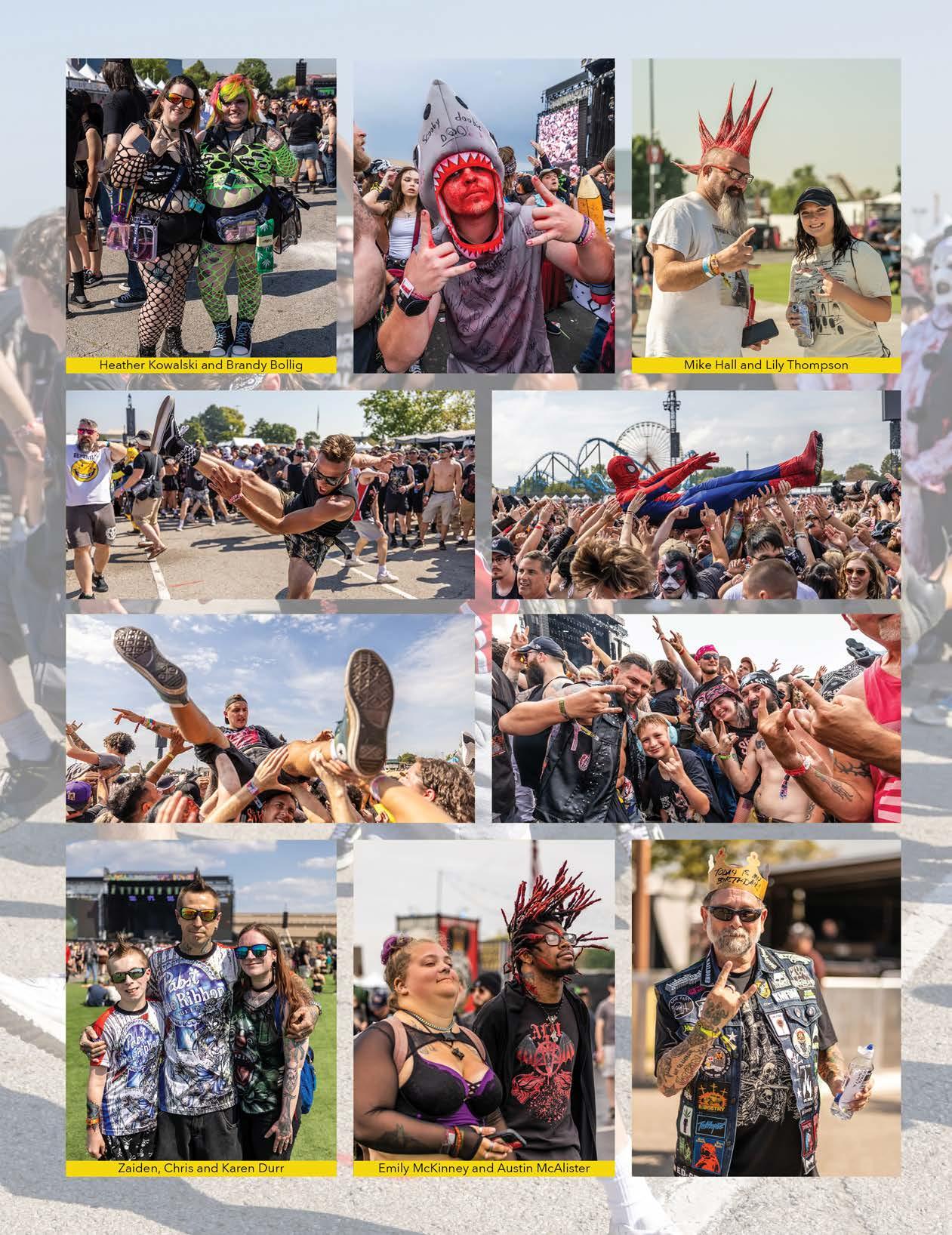

Thank you to our sponsors for your continued support:
We extend our deepest gratitude to our sponsors, whose generous support makes it possible for us to share the stories, voices, and creative spirit of Louisville. Through your commitment, the VOICE-TRIBUNE is able to highlight the arts, culture, fashion, philanthropy, and the many facets of our vibrant society. It is because of you that we can continue to celebrate and uplift the people and organizations shaping our community with vision, style, and heart. Thank you for believing in our mission and for helping us shine a light on the voices that make Louisville truly extraordinary.
Amy Wagner
Baptist Health / Milestone
Wellness Center
Barry Wooley Designs
BEDR
Bittners
Chenoweth Square
Cultured
Family Scholar House
J Michael’s Spa & Salon
Kentucky Select Properties KMAC
KyCAD
Laura Rice
Louisville Ballet
Louisville Visual Art
Melanie Galloway
Monk’s Road Boilerhouse
Metro United Way
Norton Healthcare Foundation
Reflections of You, by Amy
Sassy Fox
Susan’s Florist
Yew Dell Botanical Gardens
Waterfront Botanical Gardens

